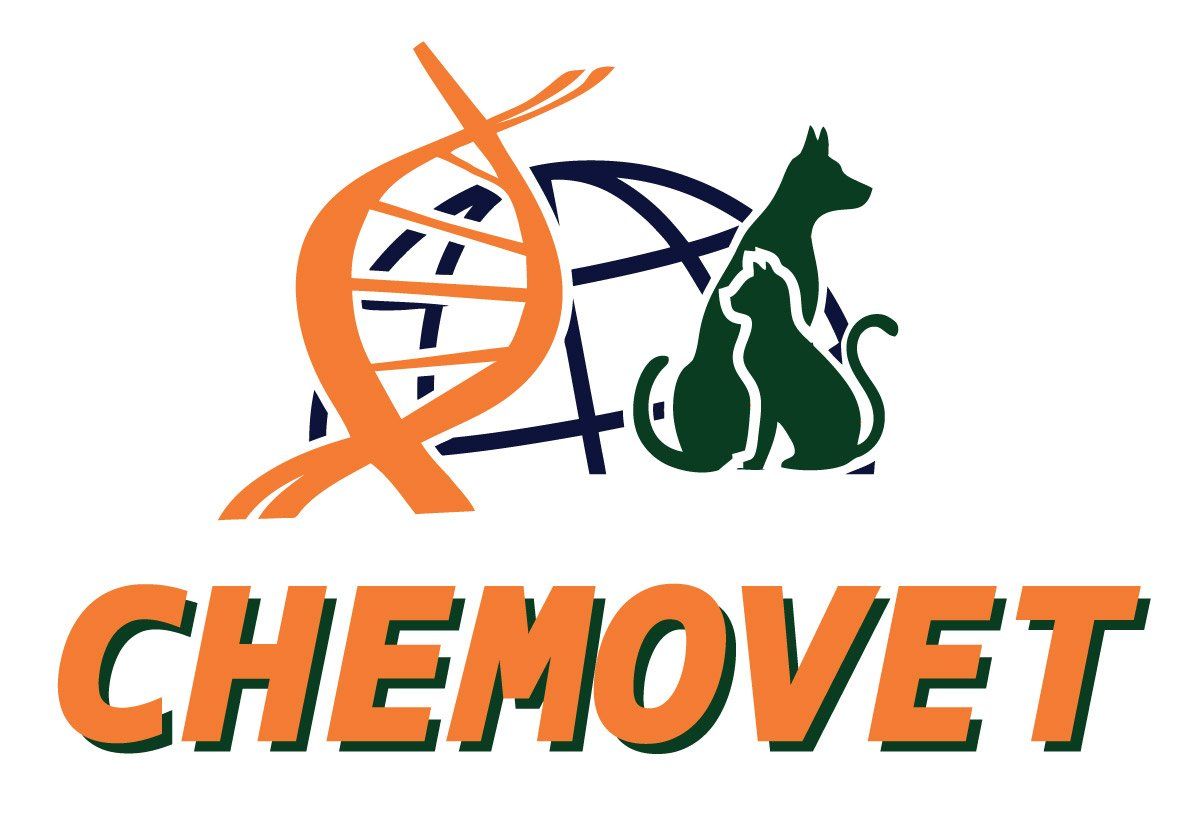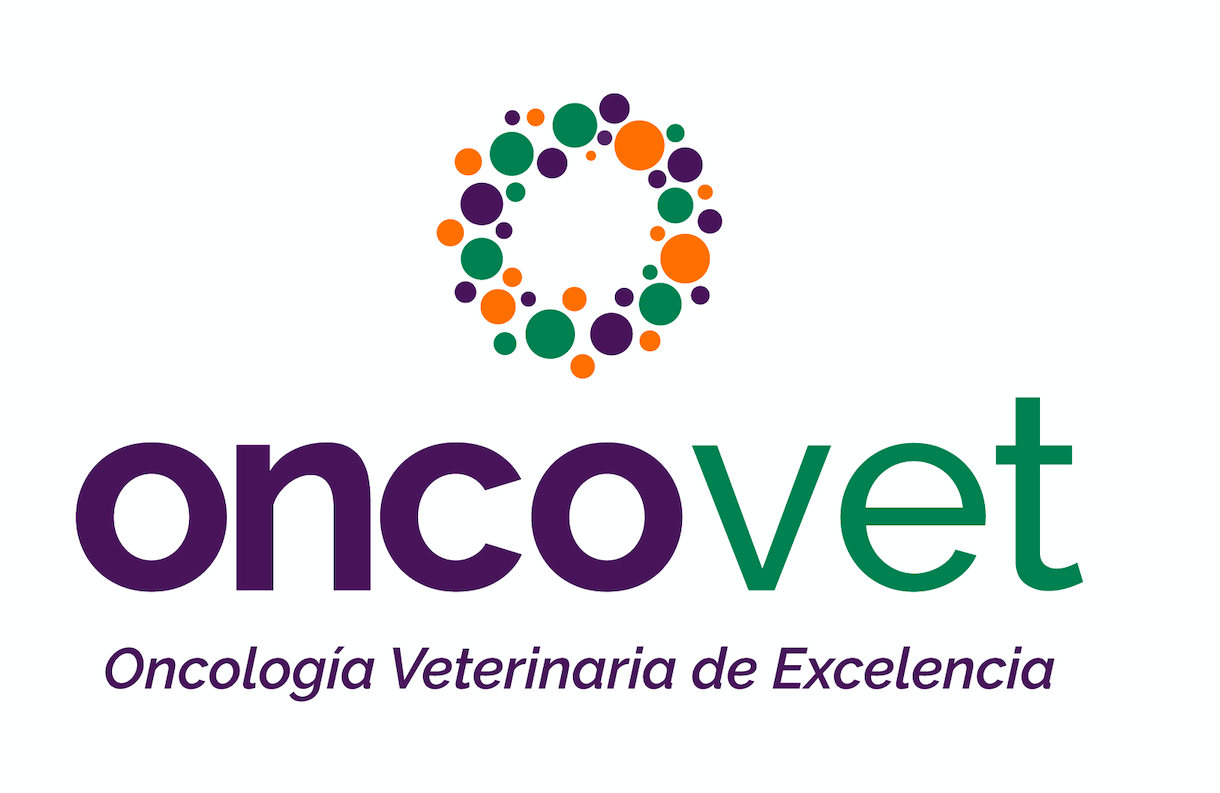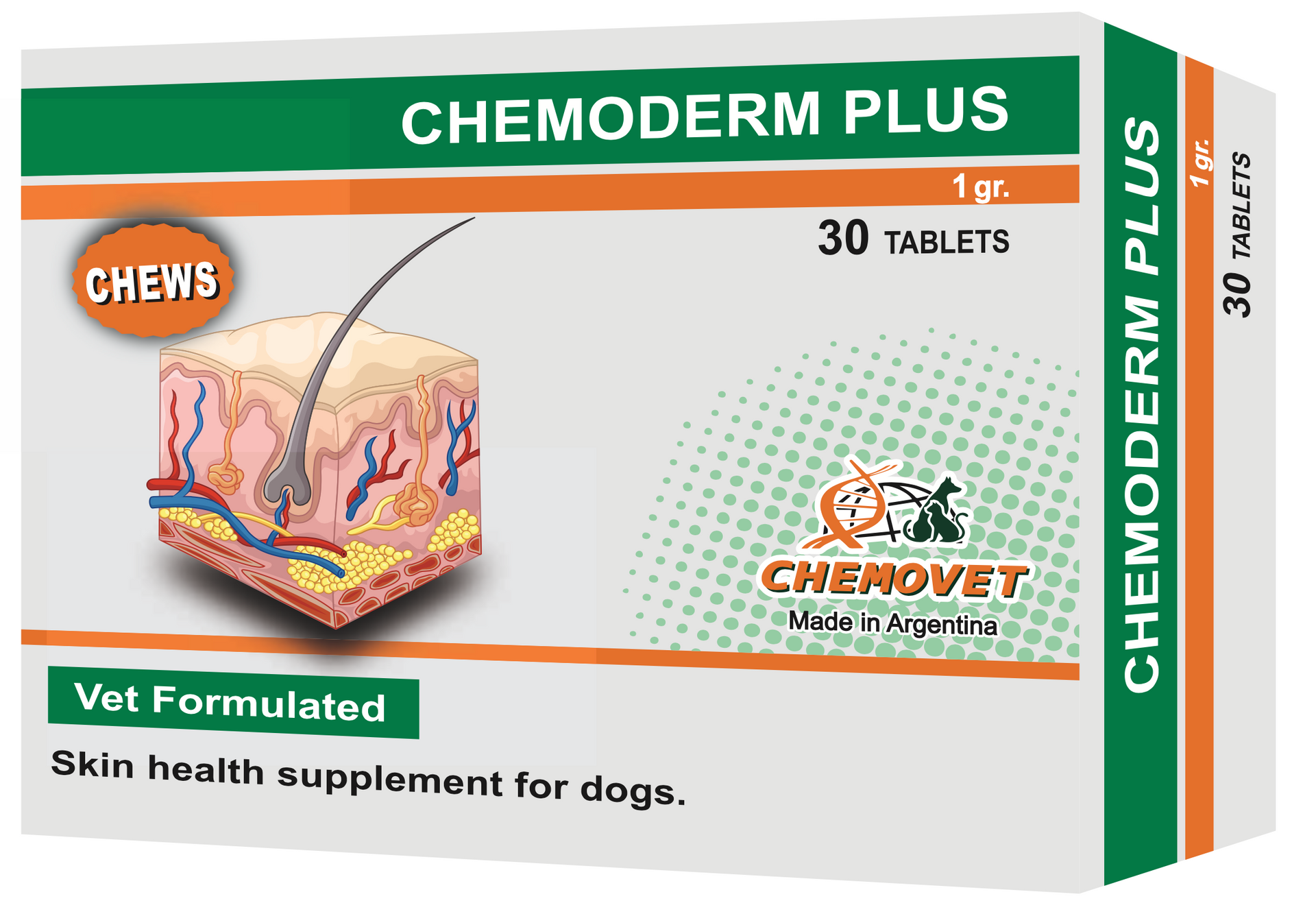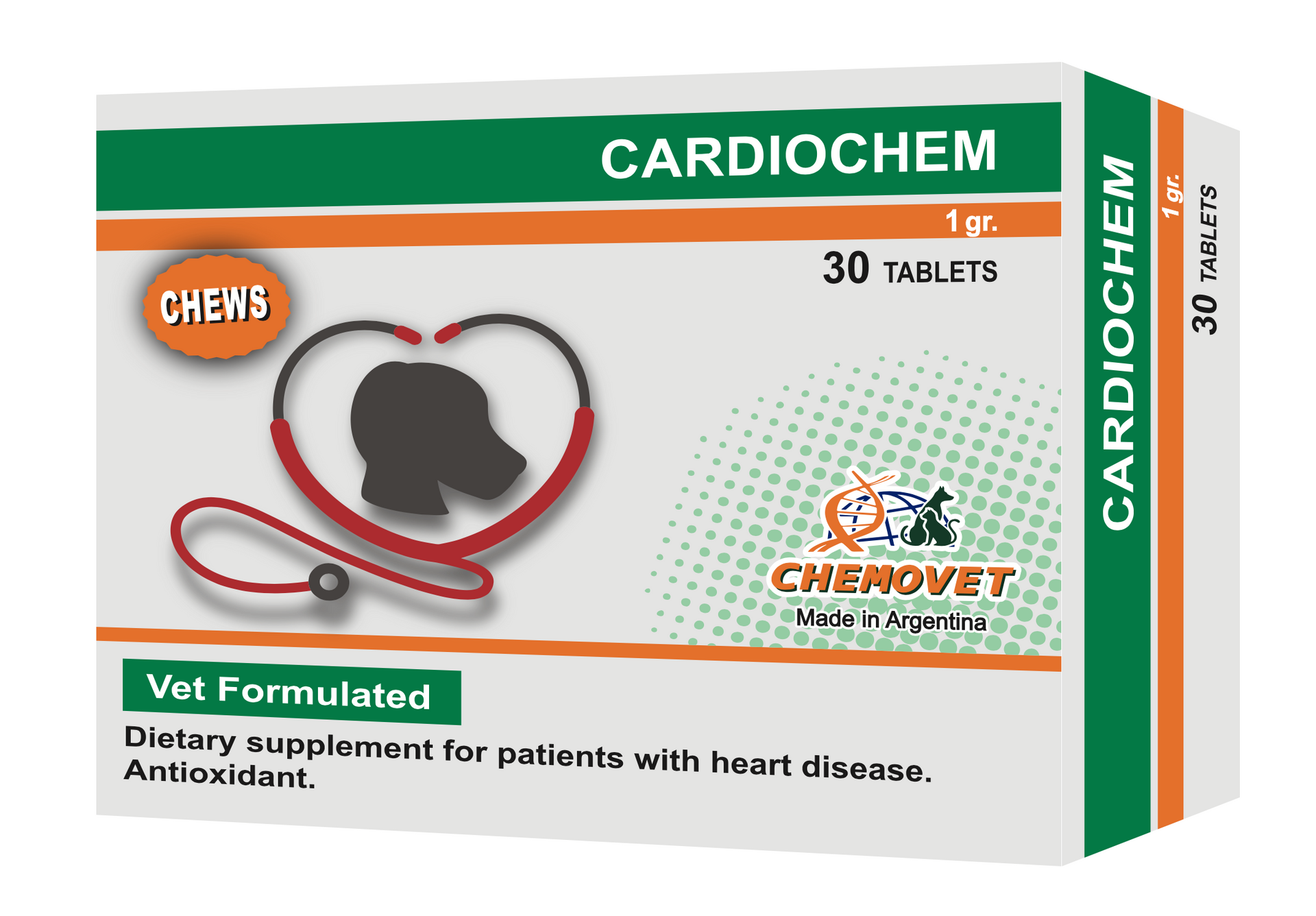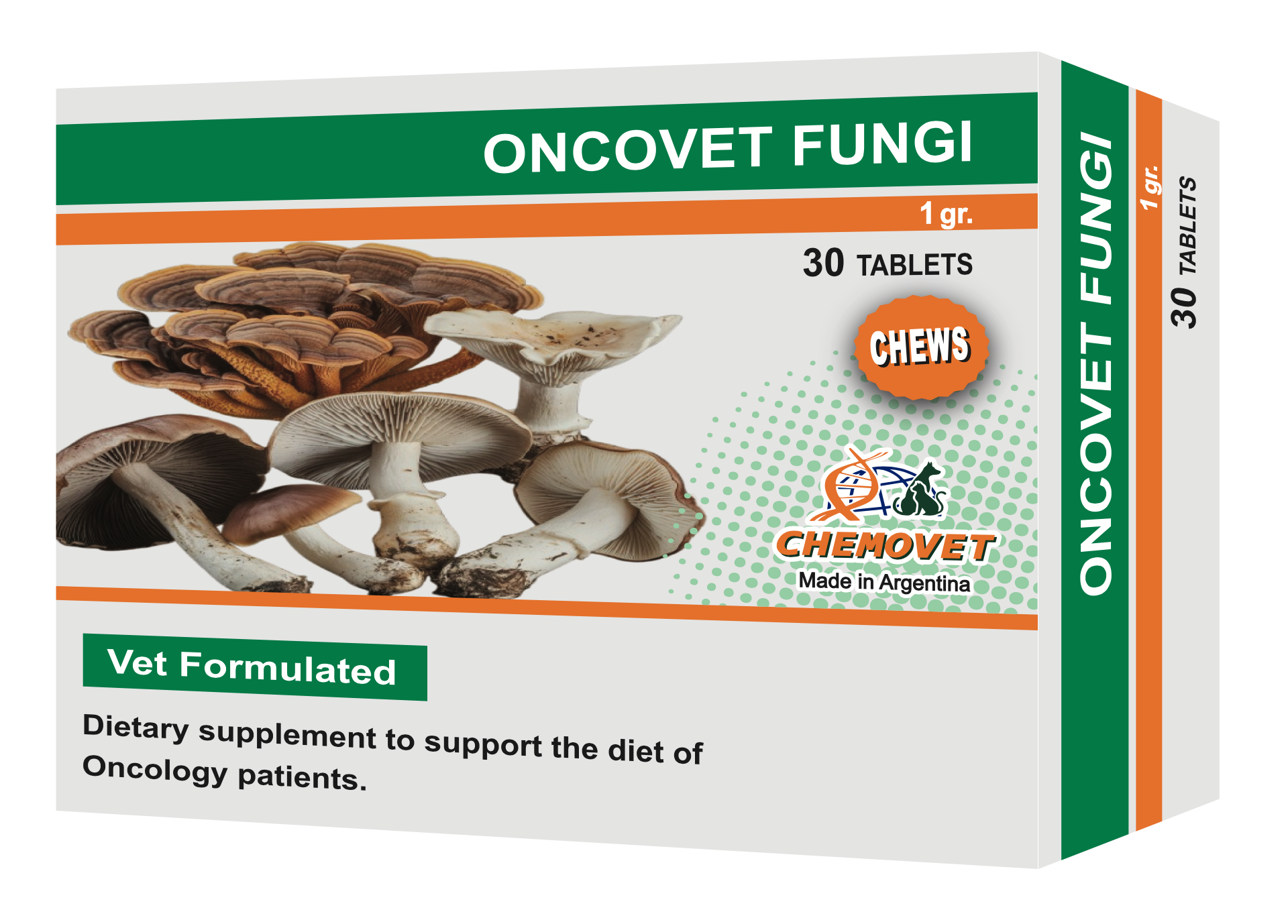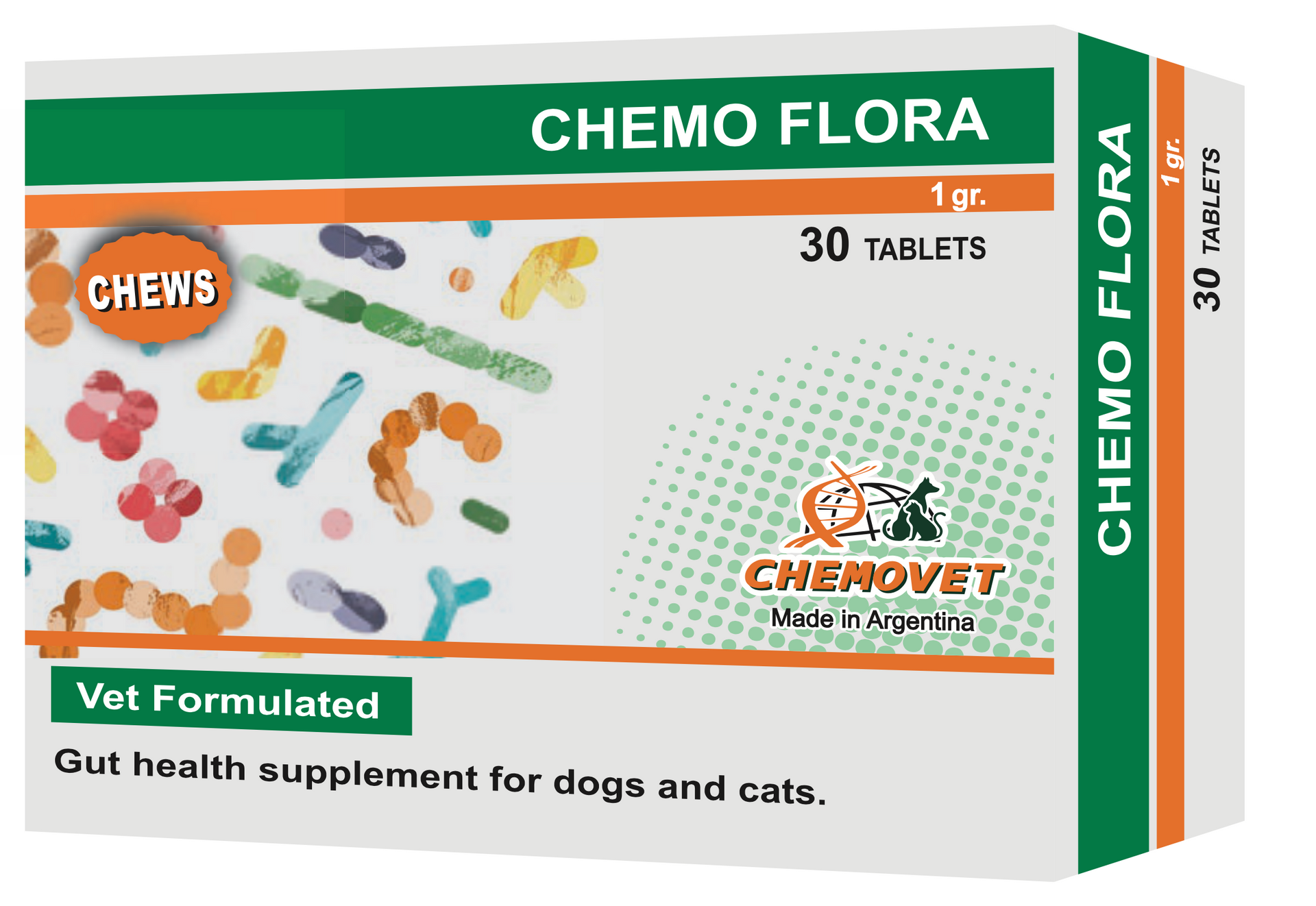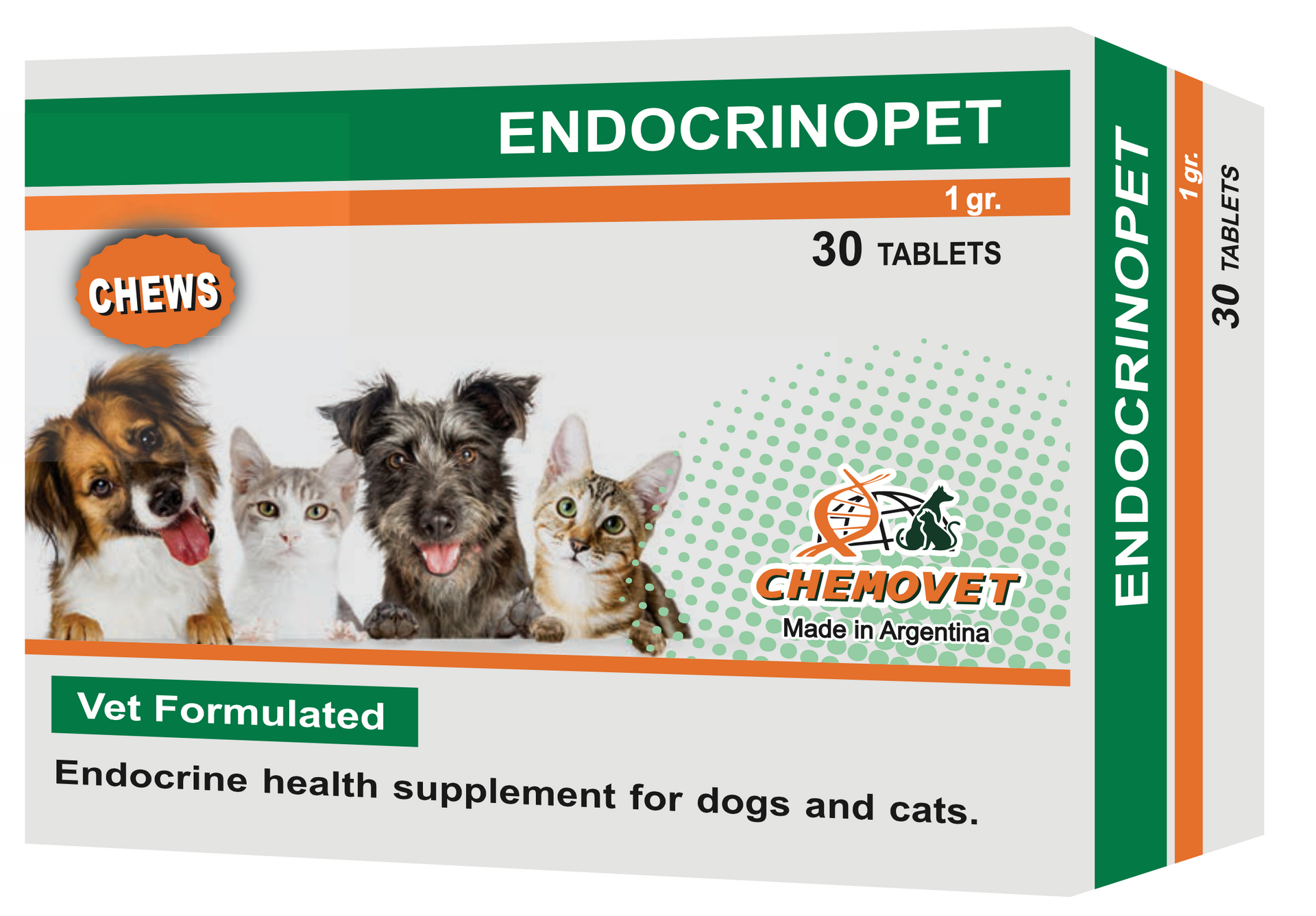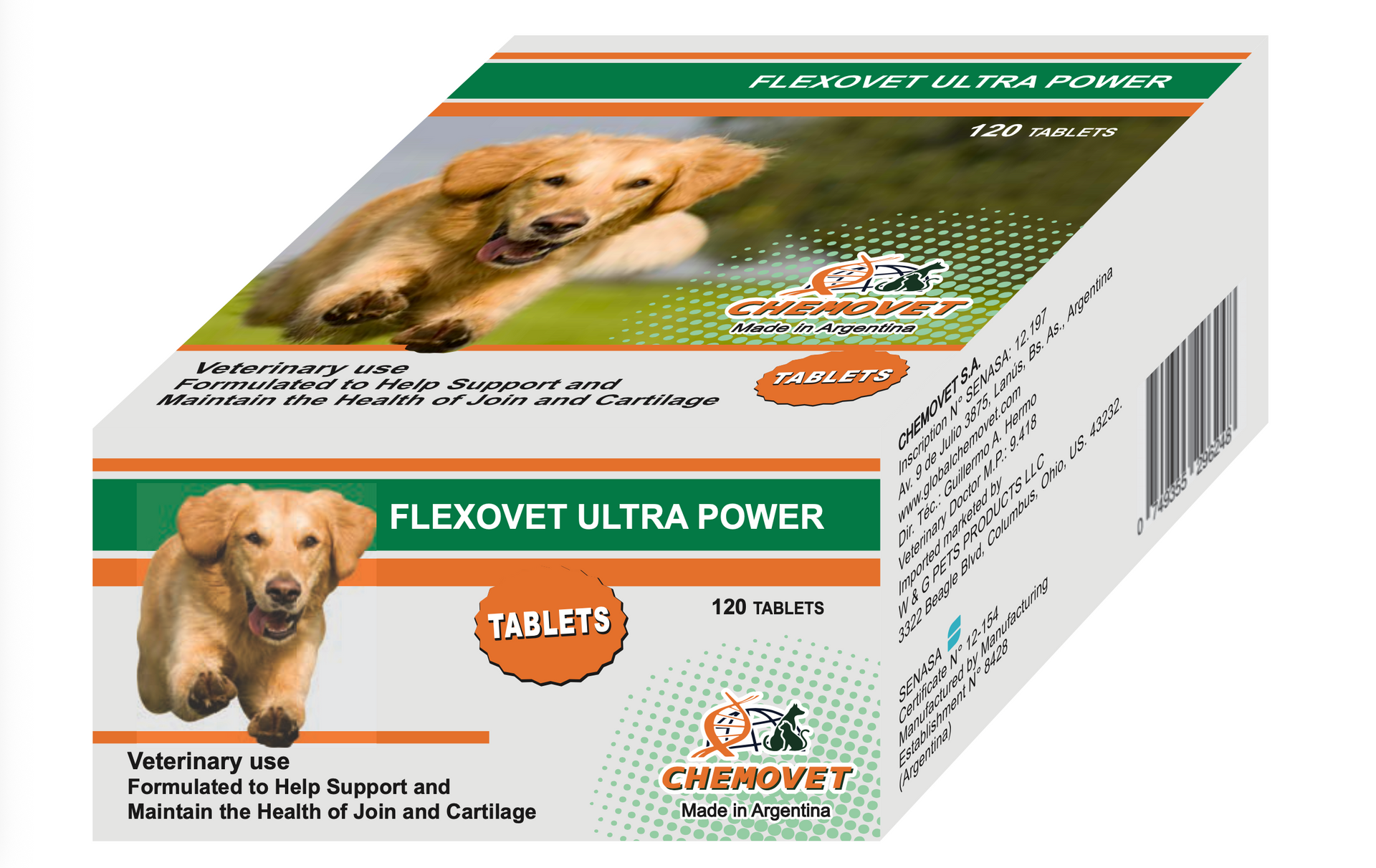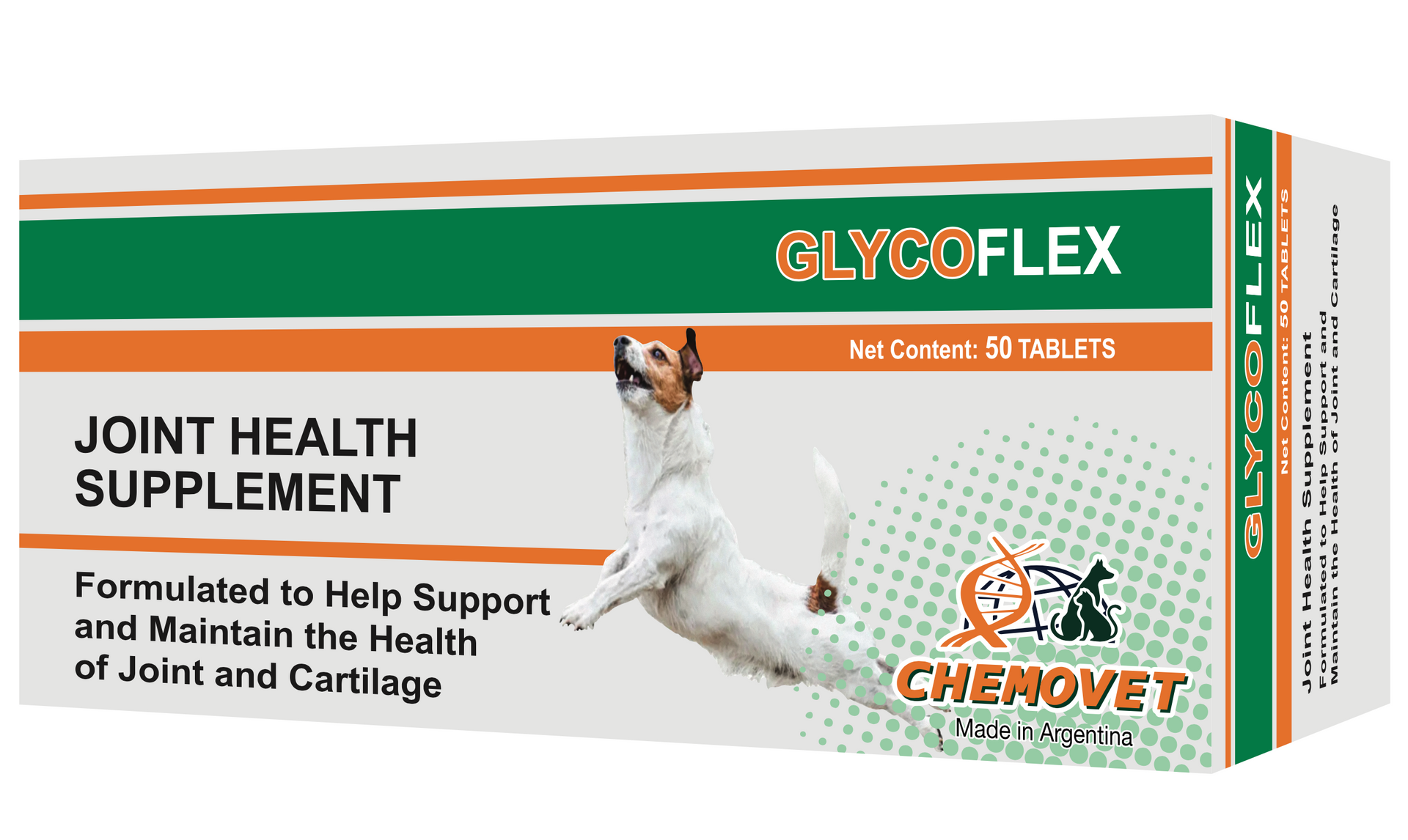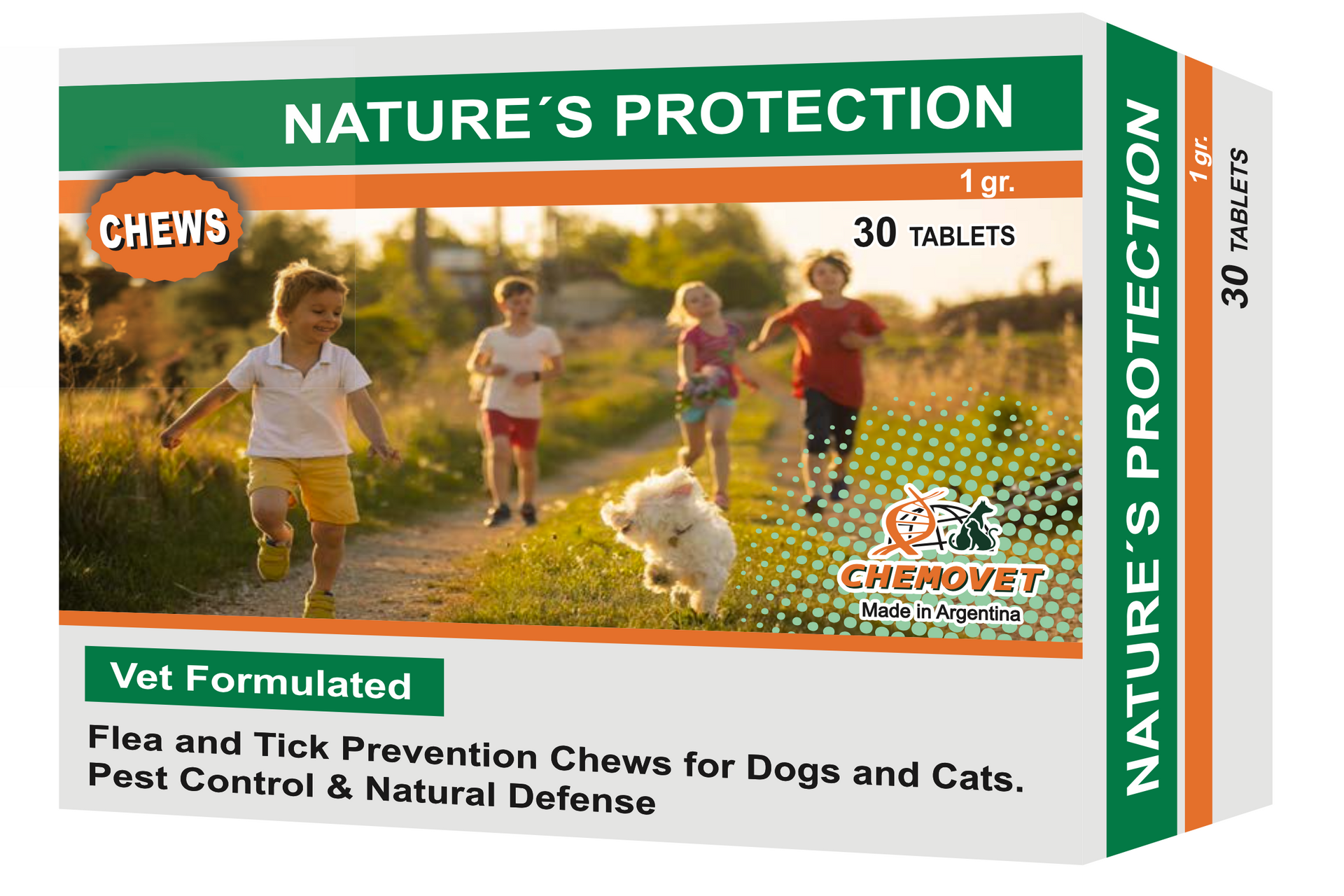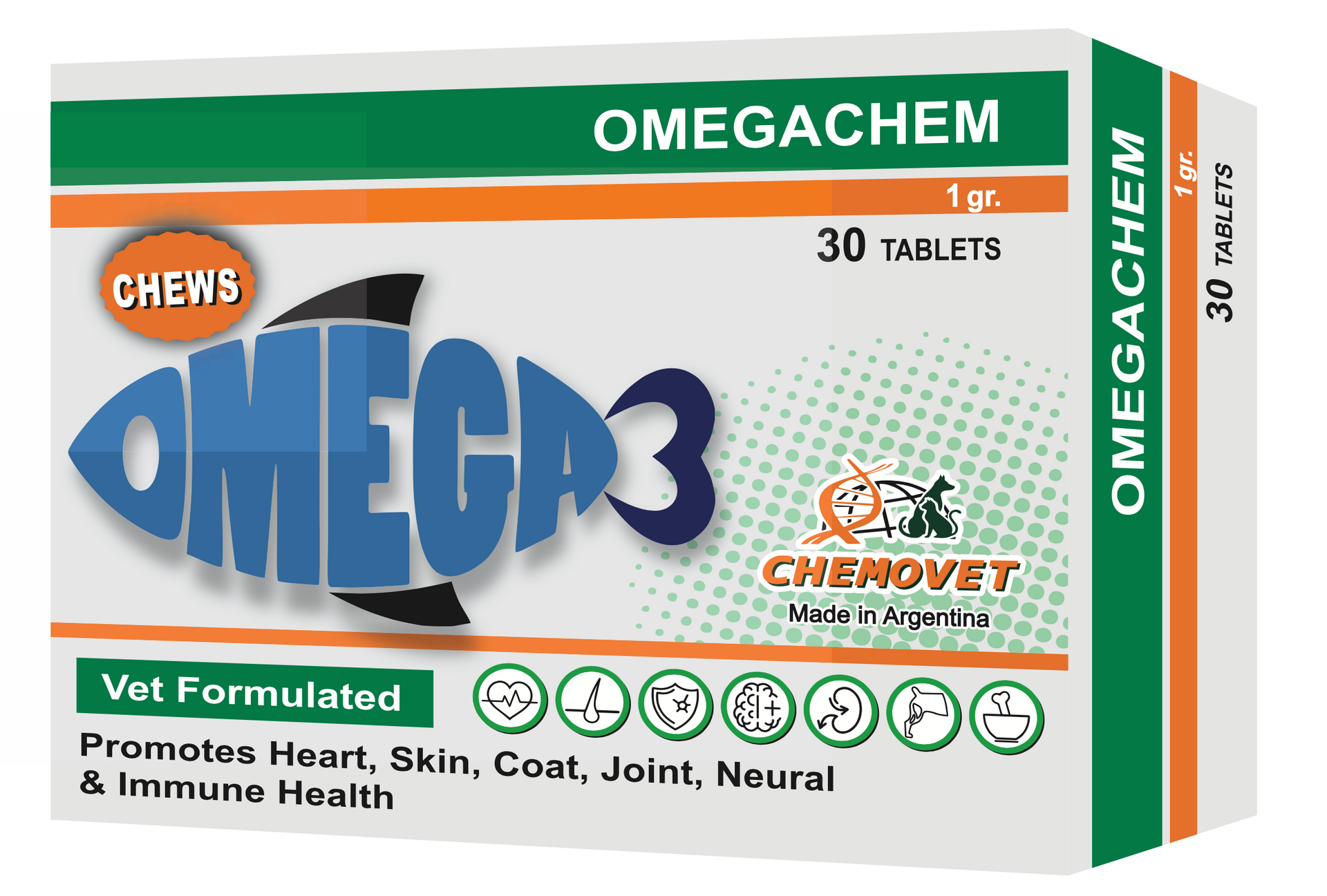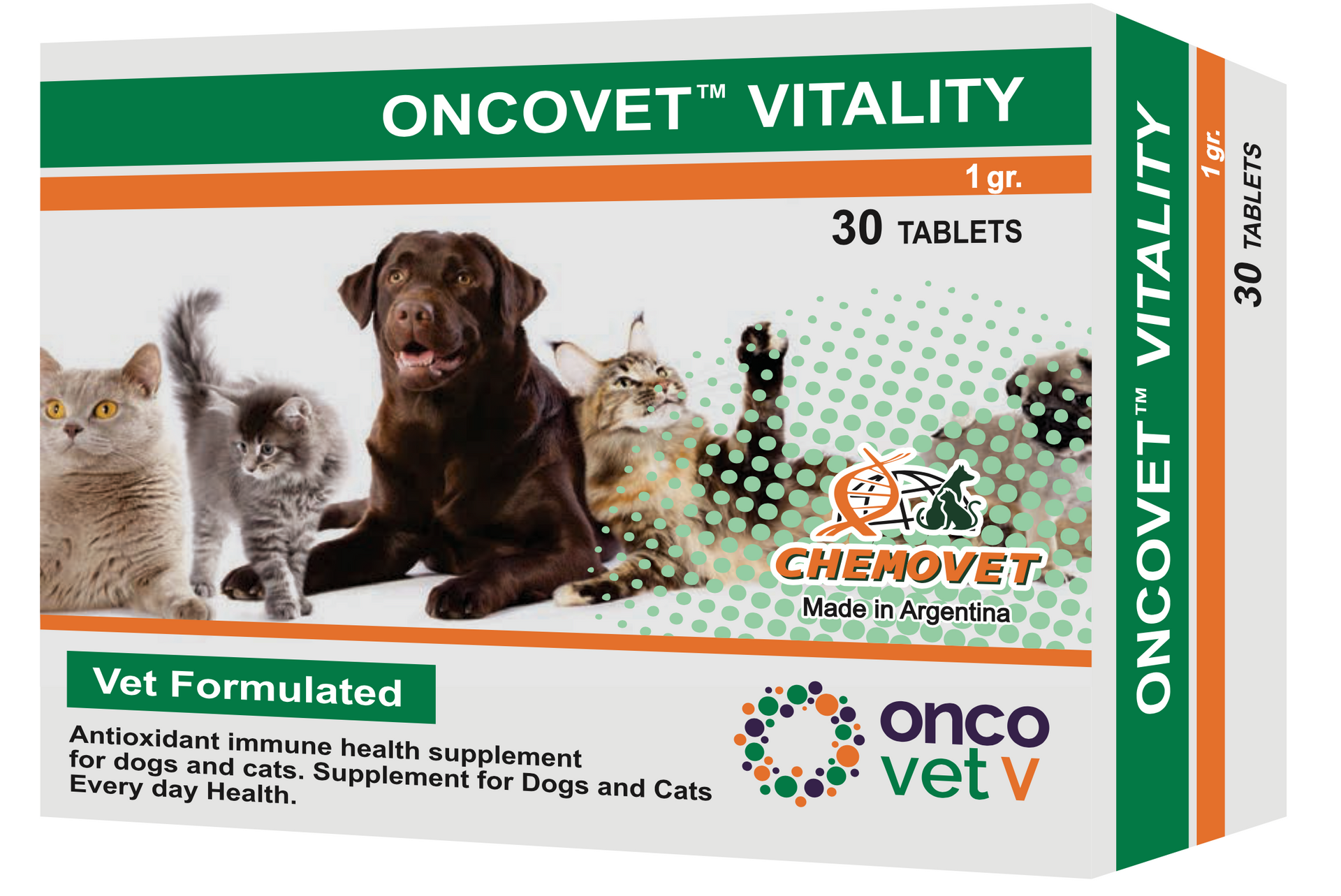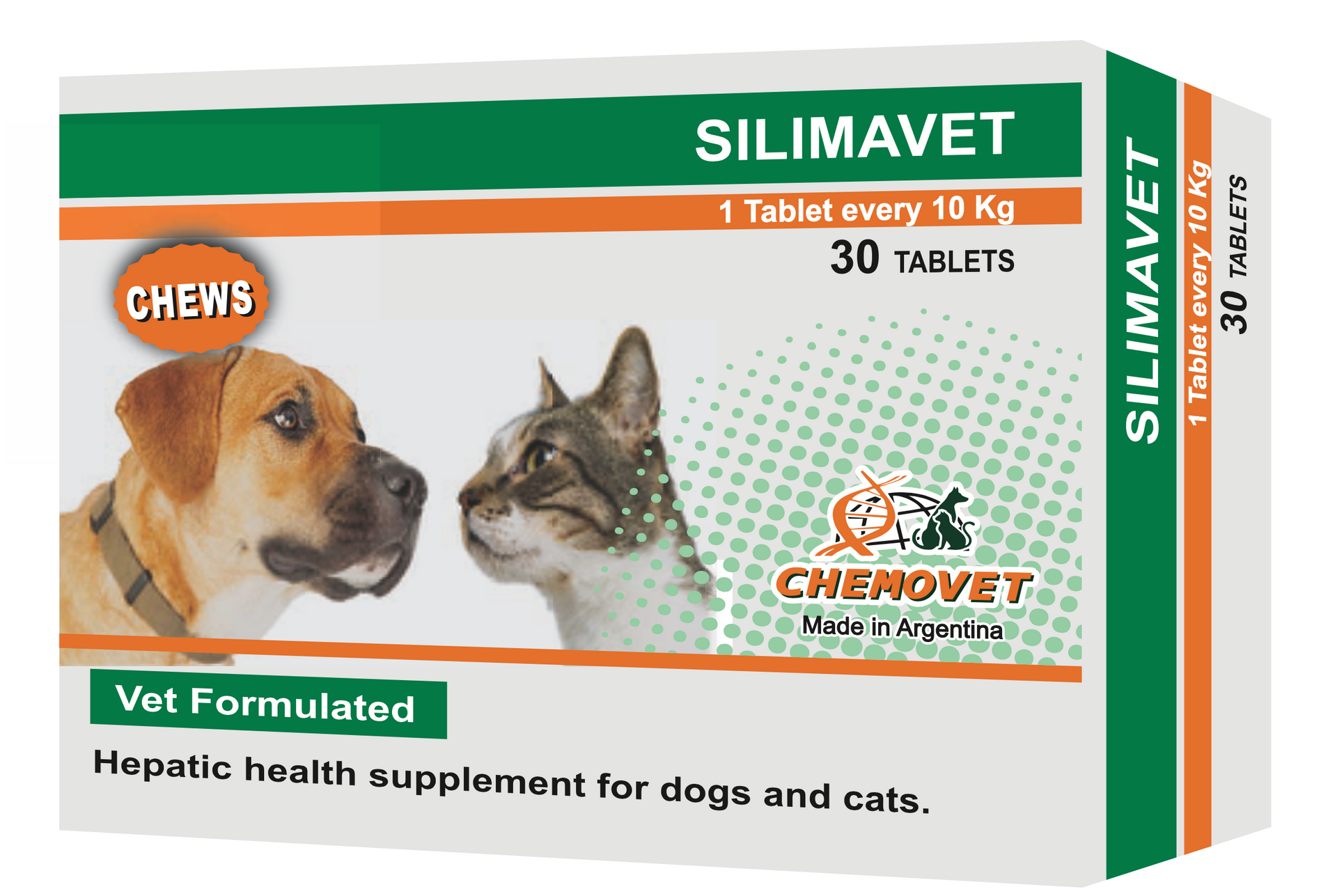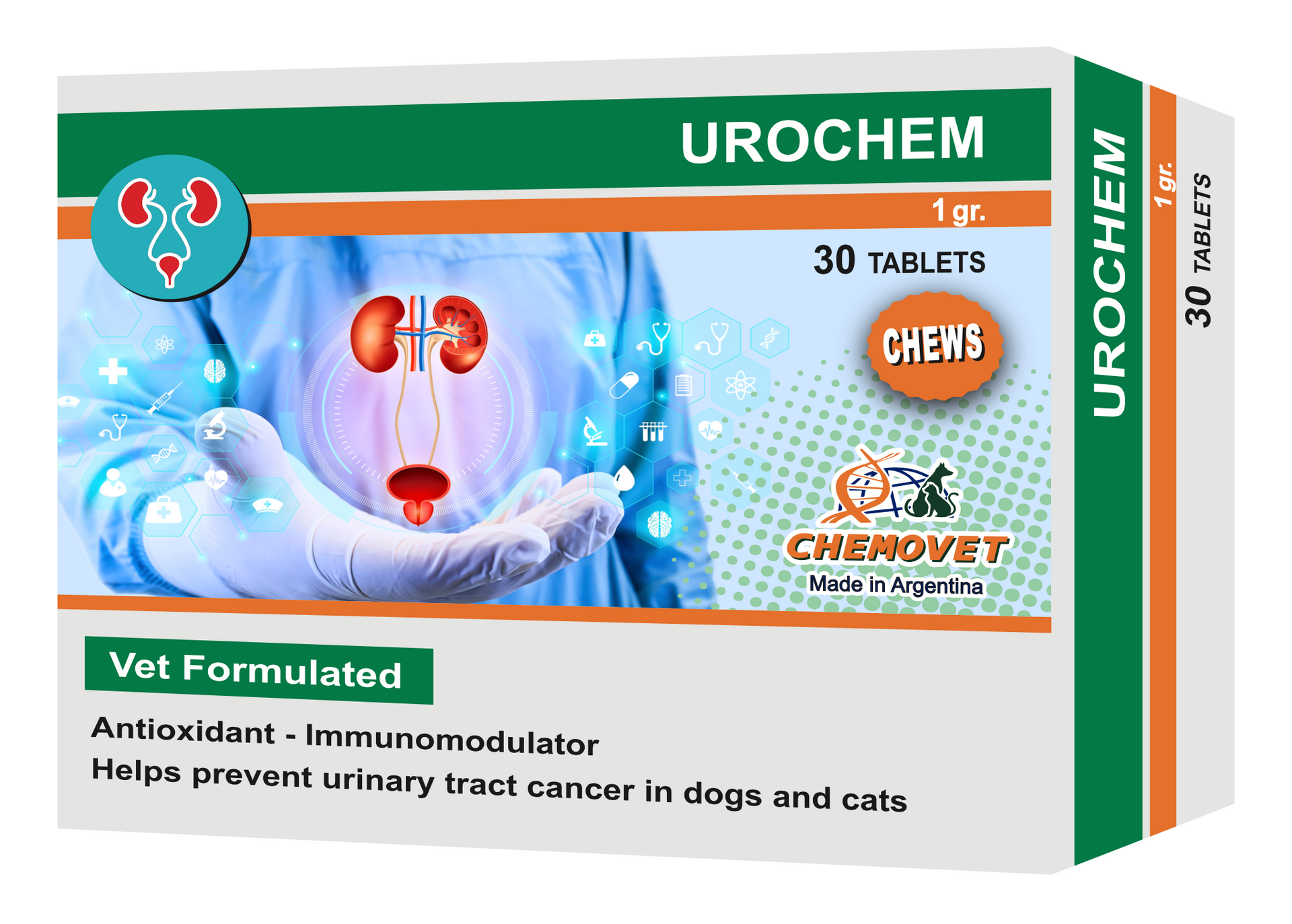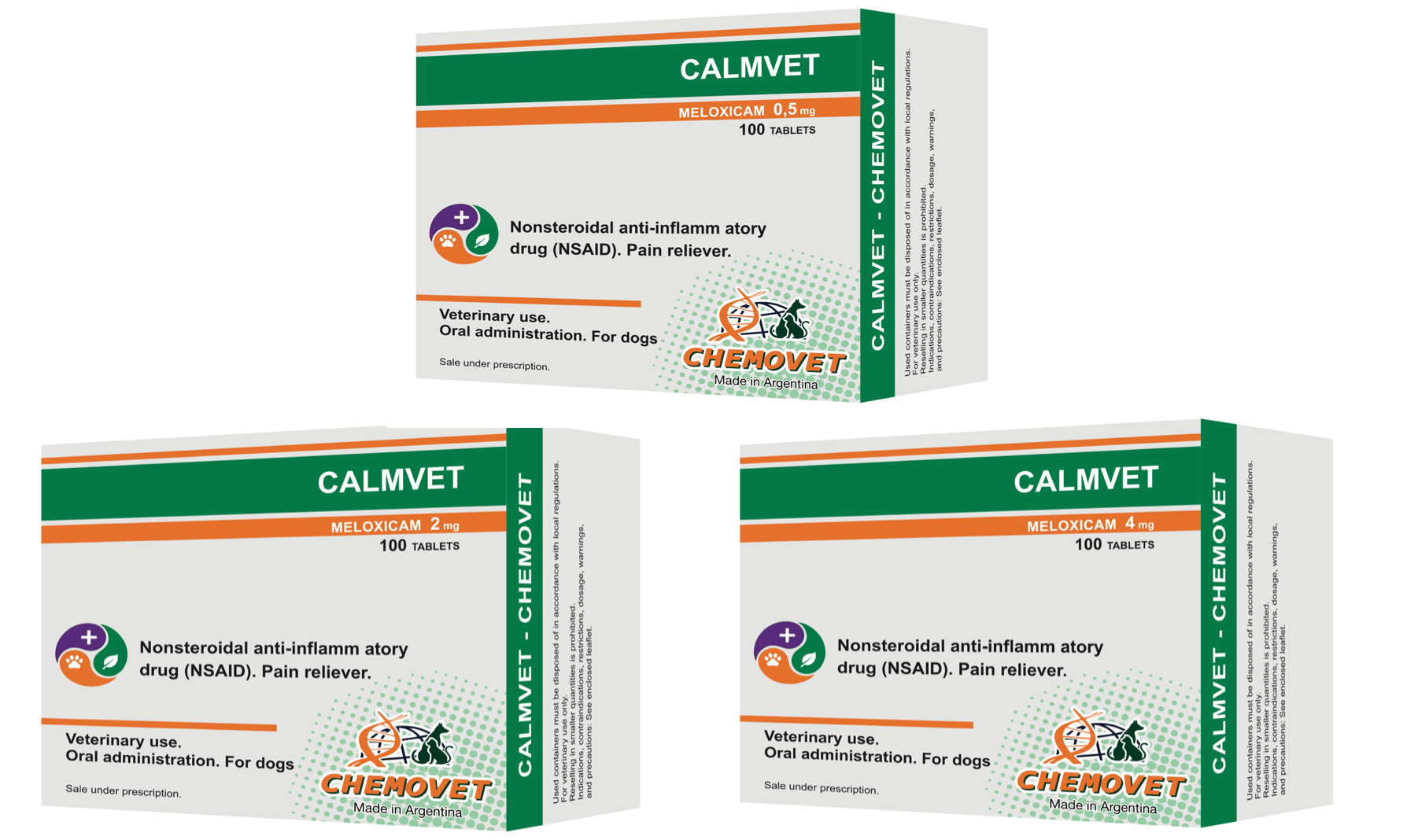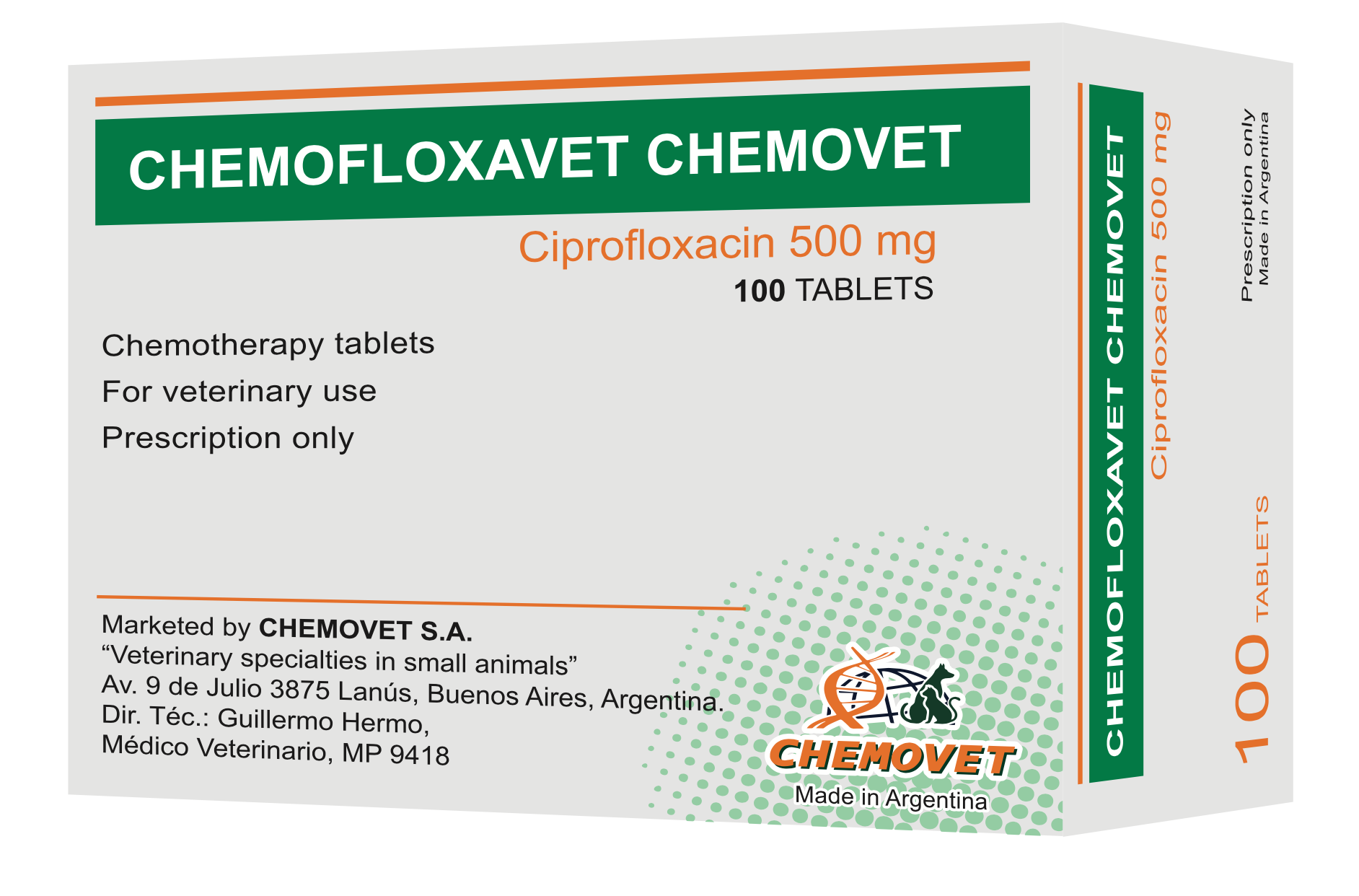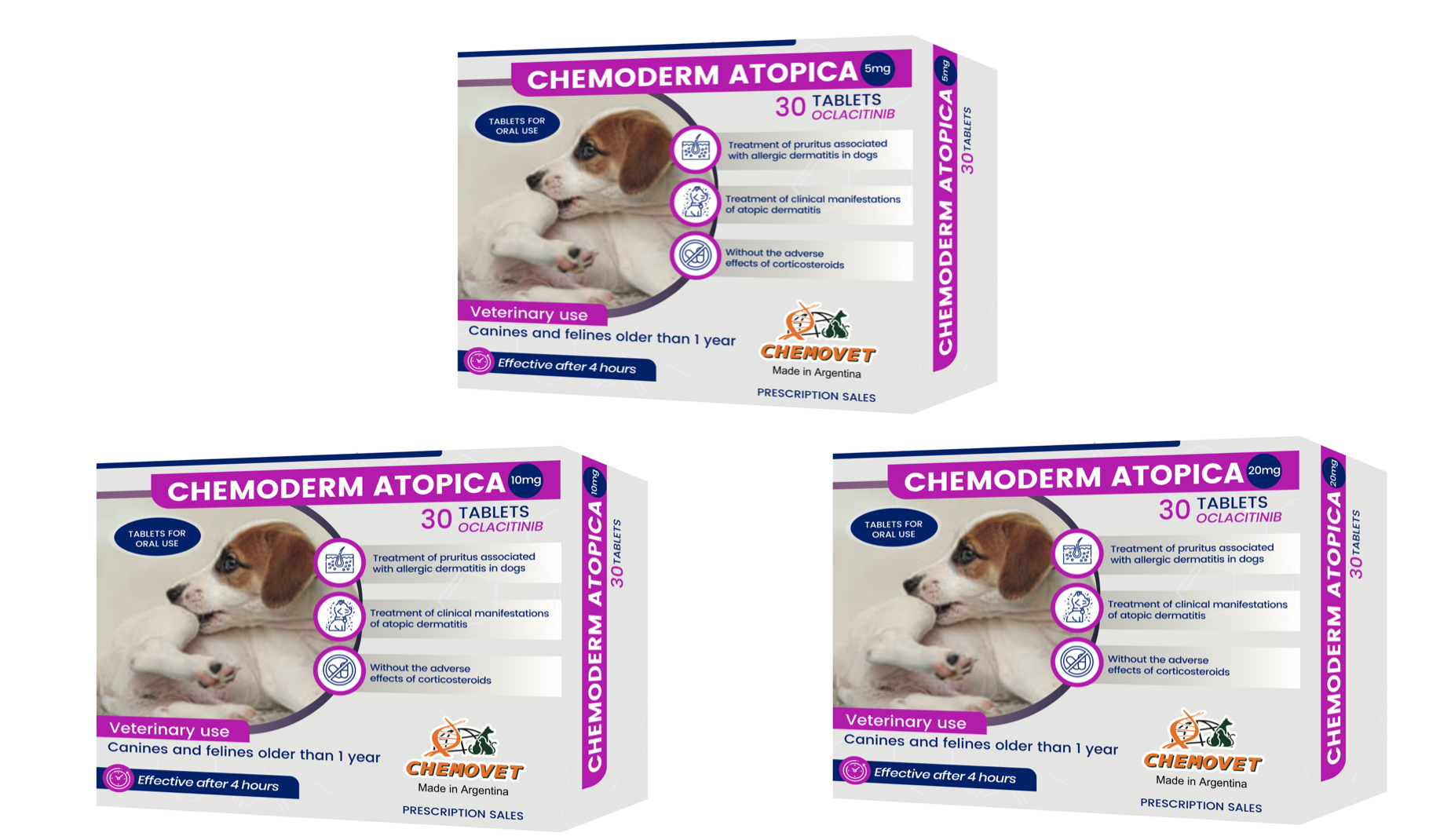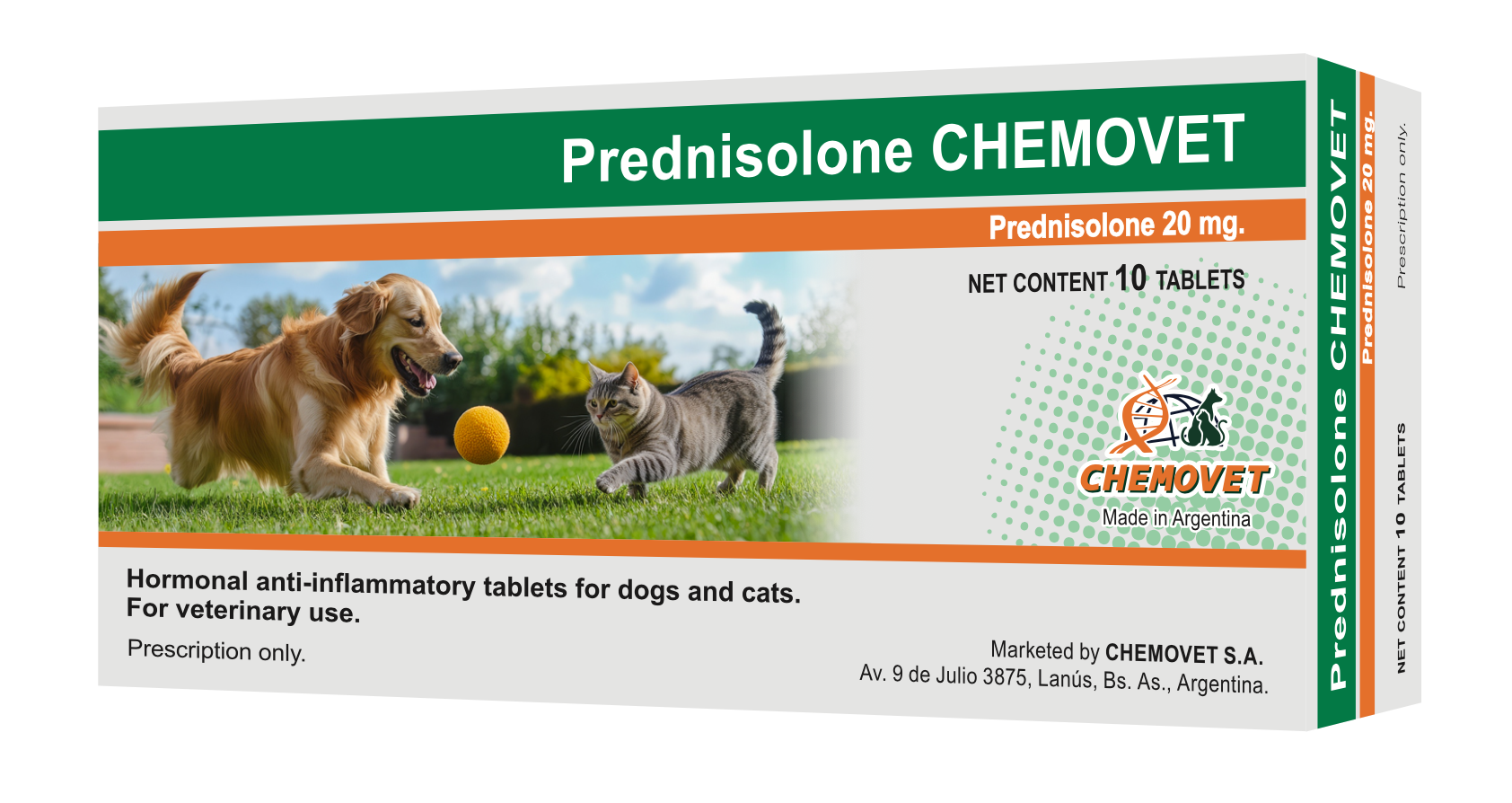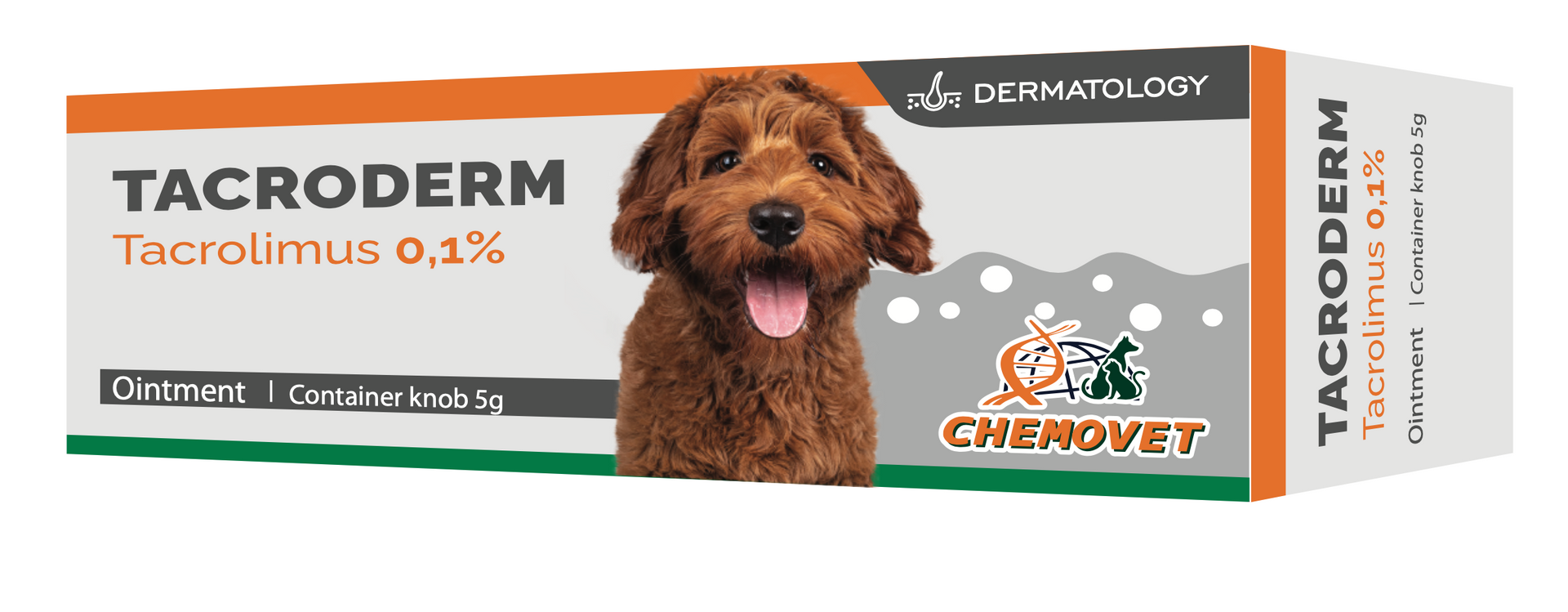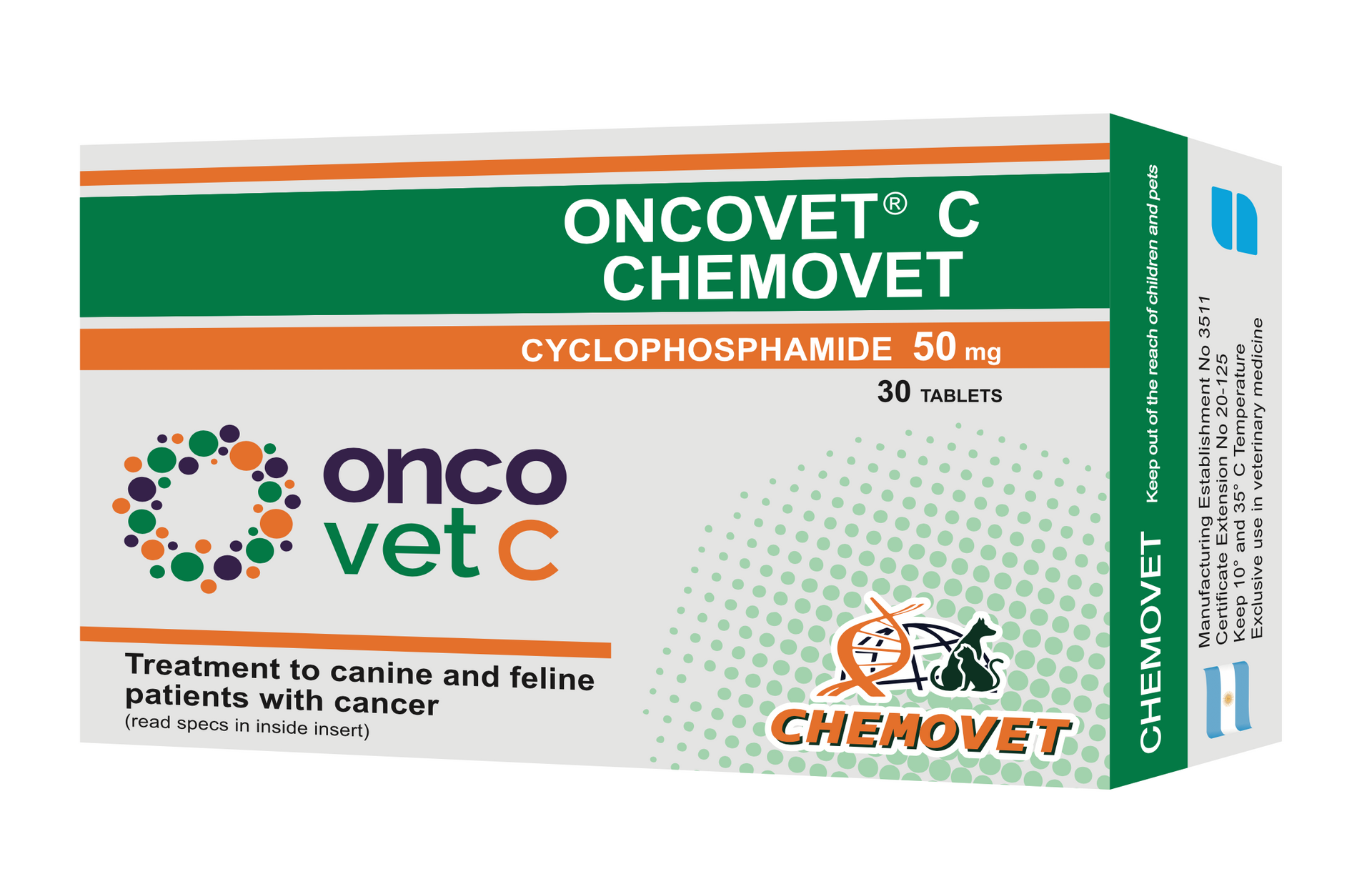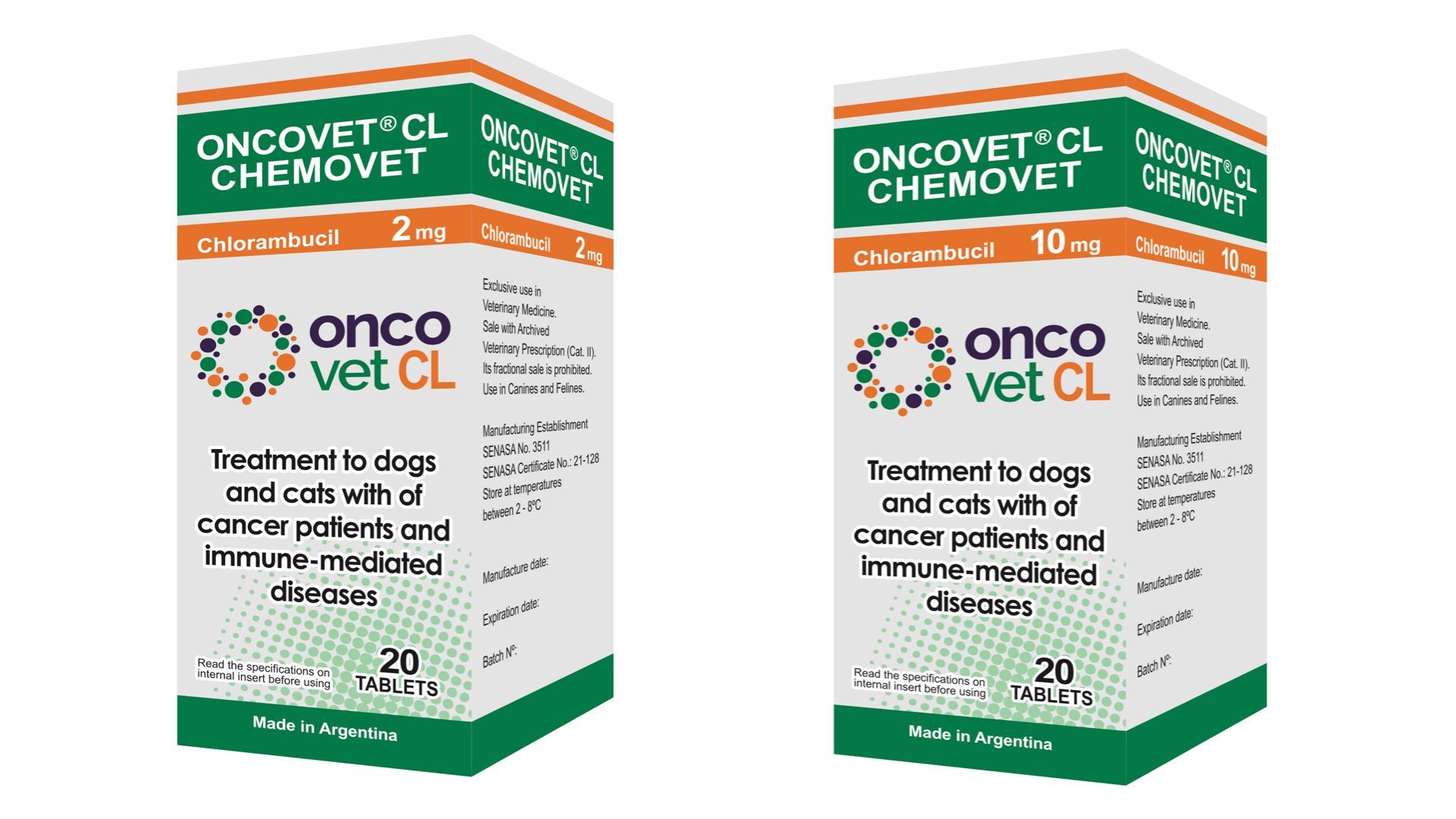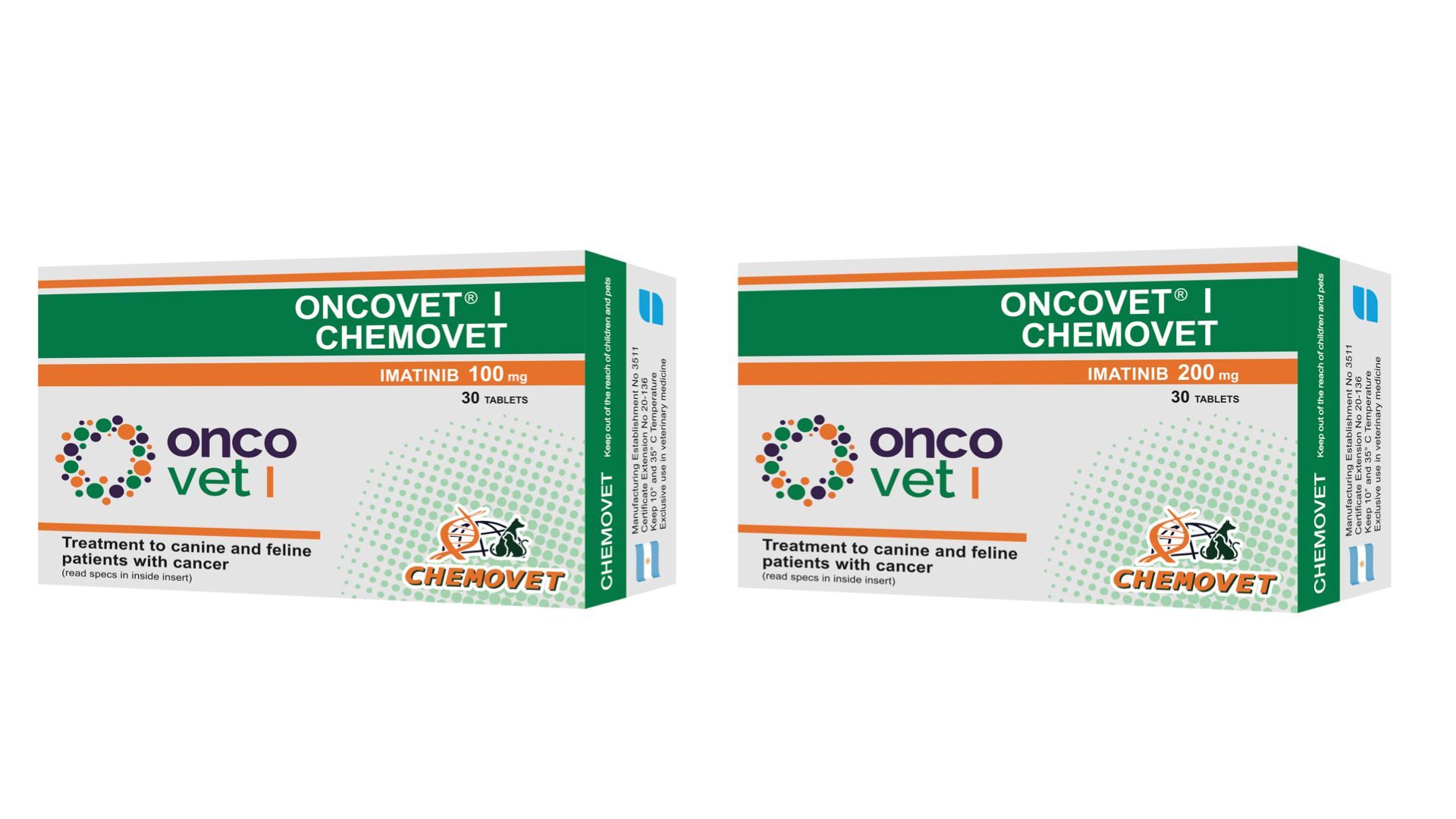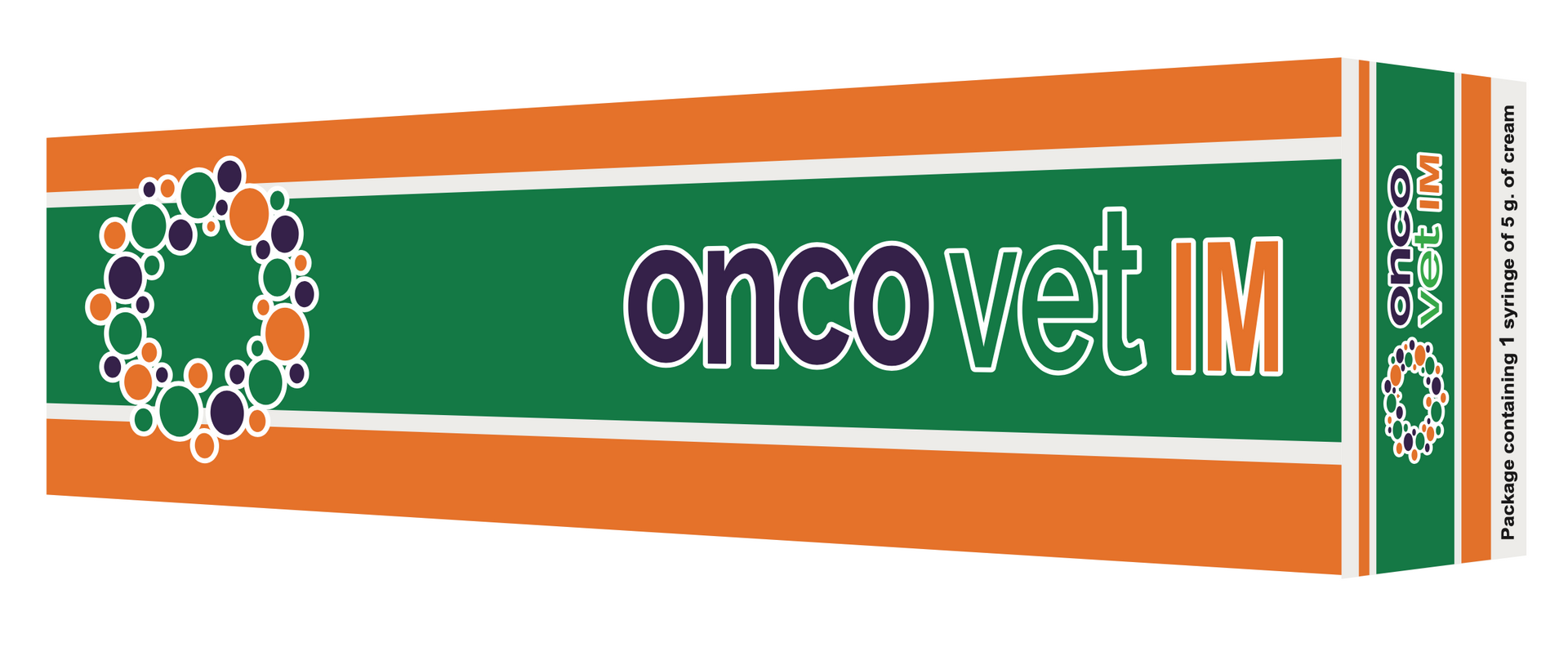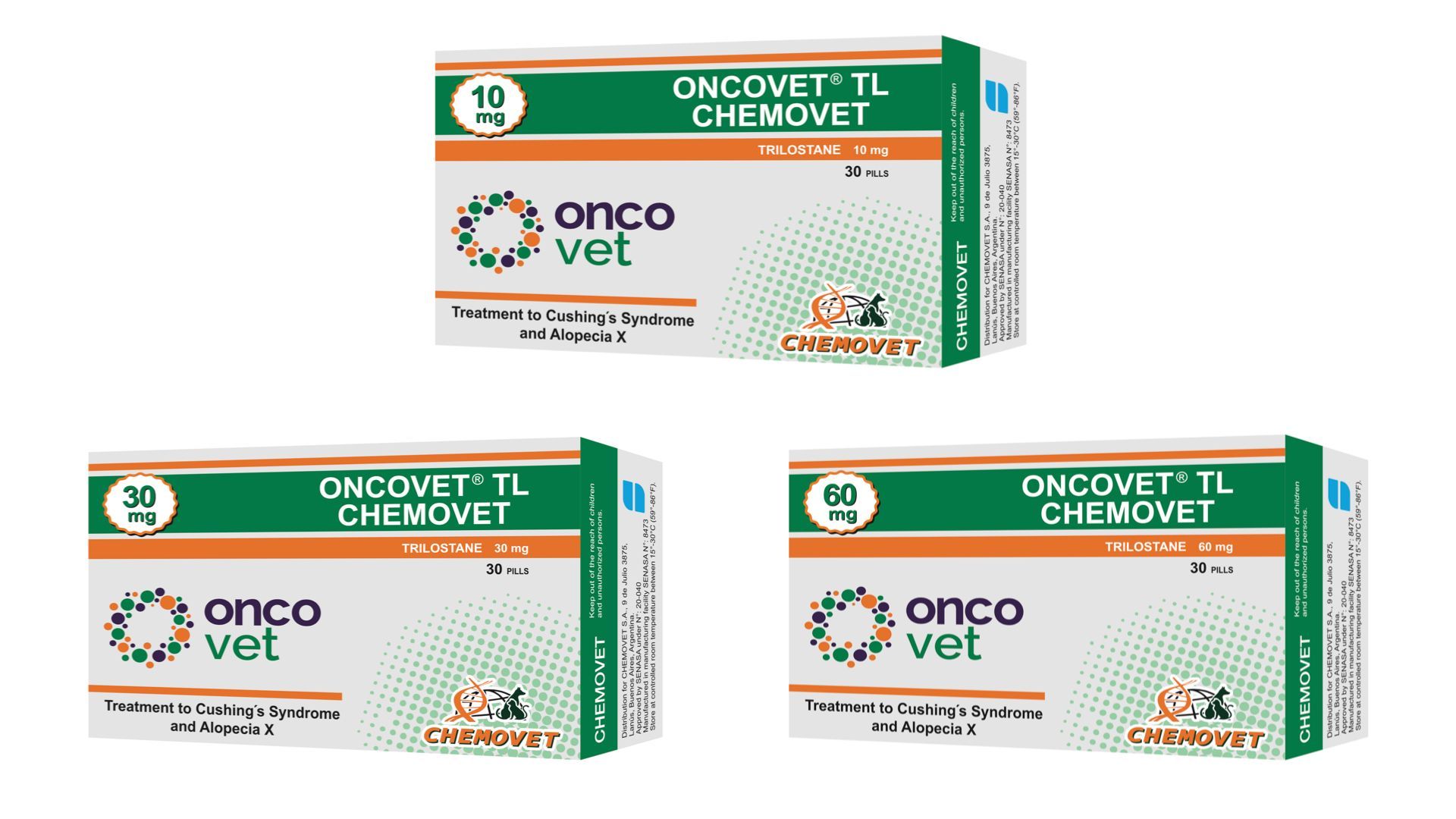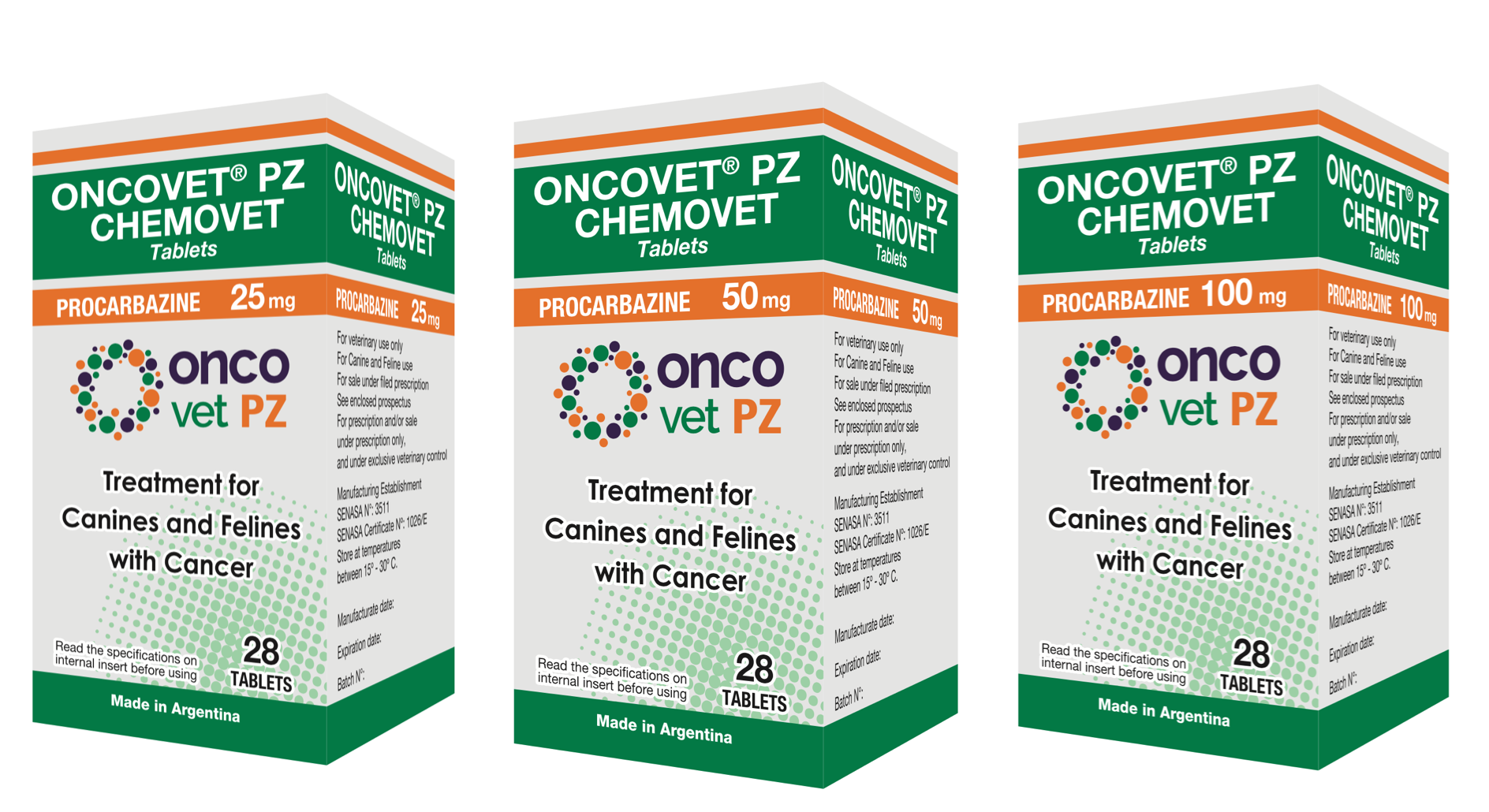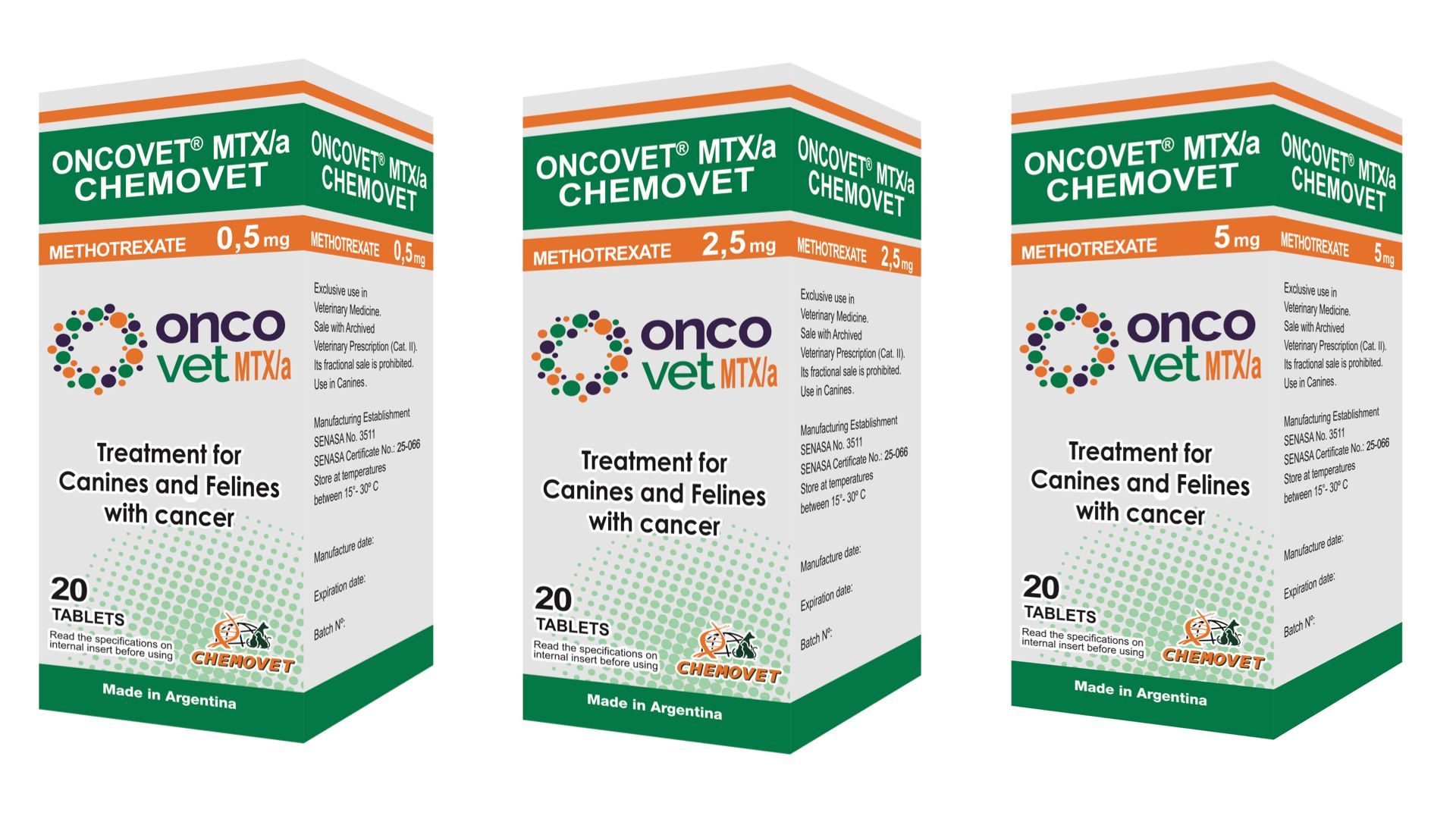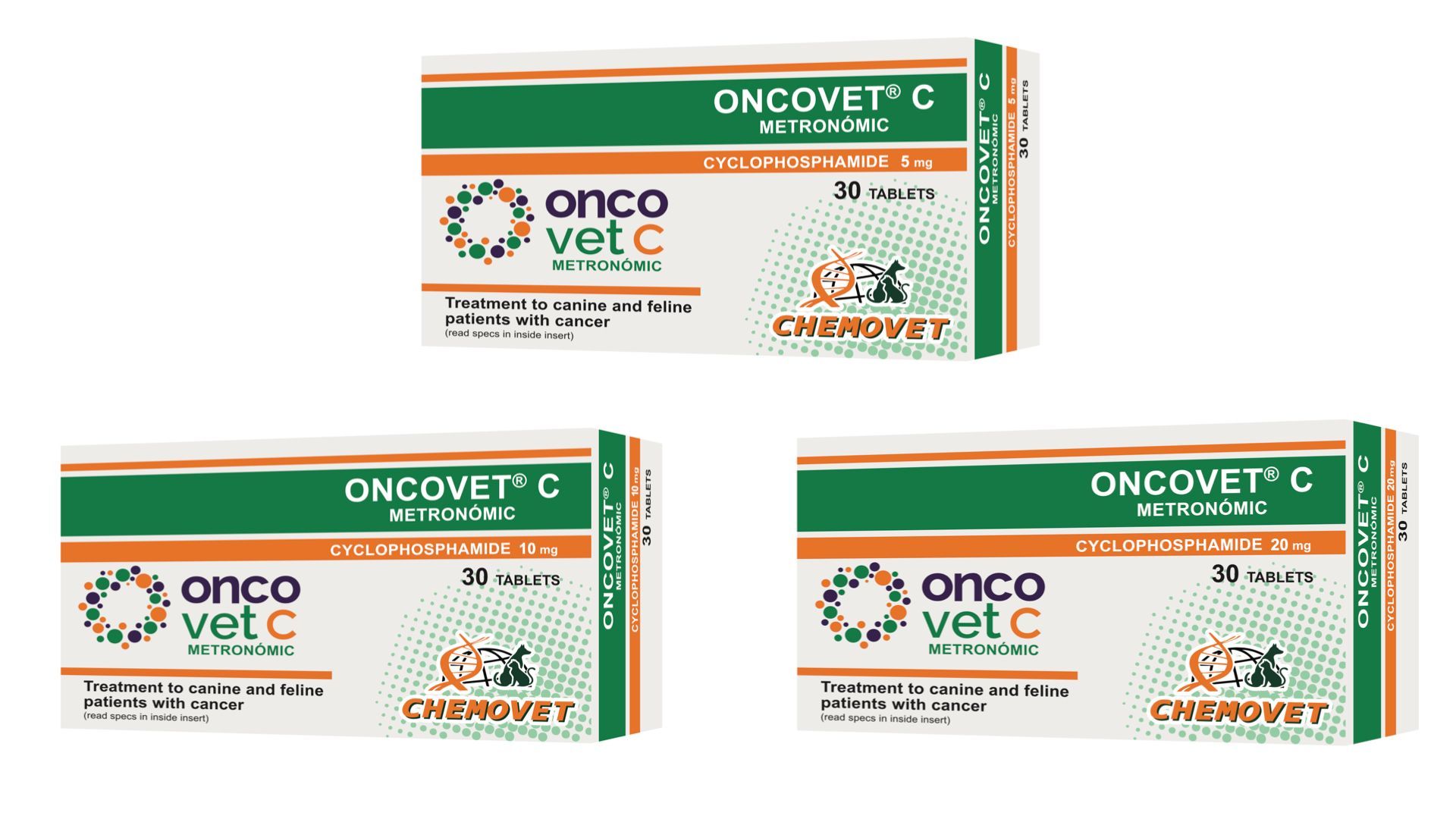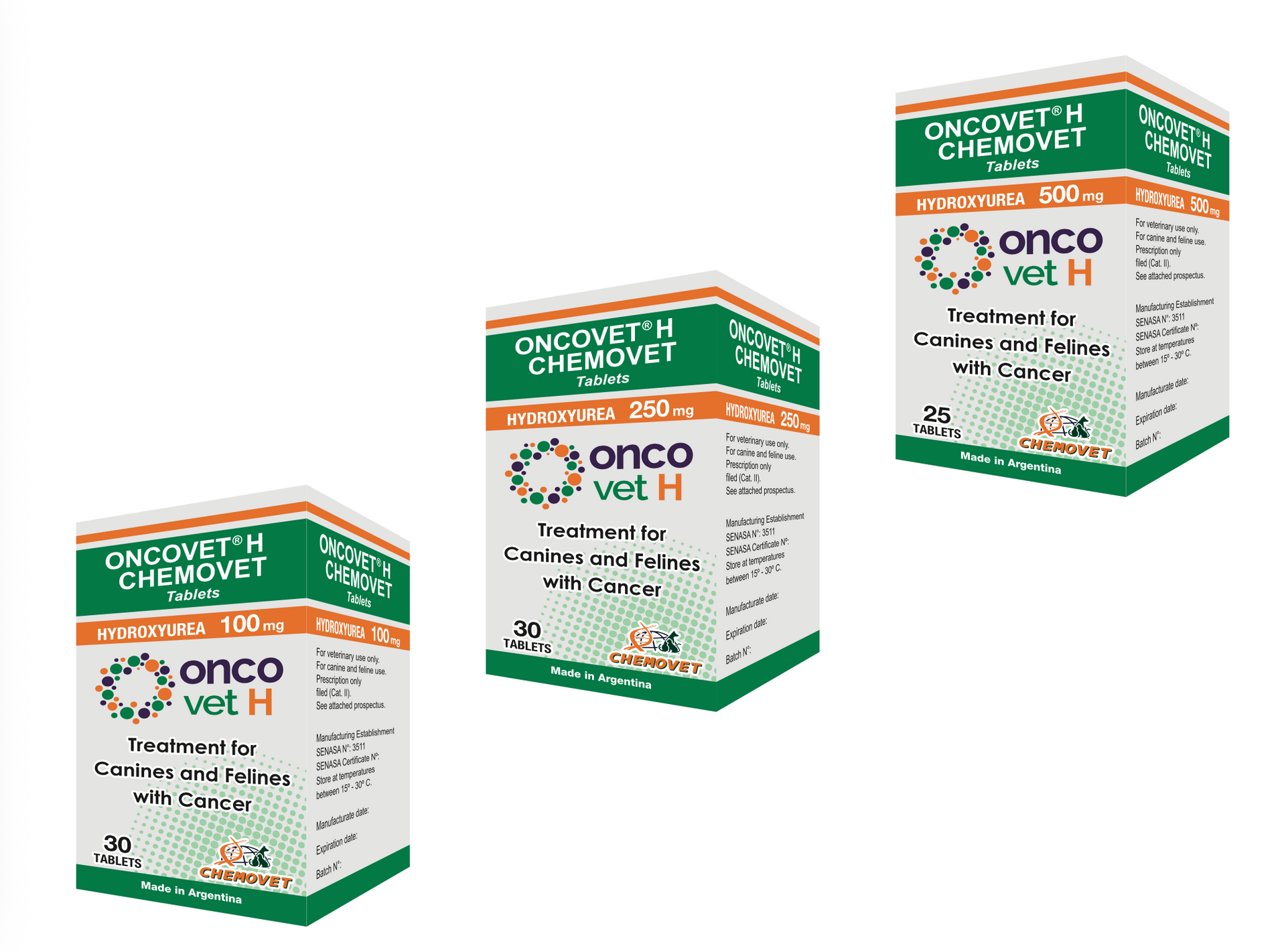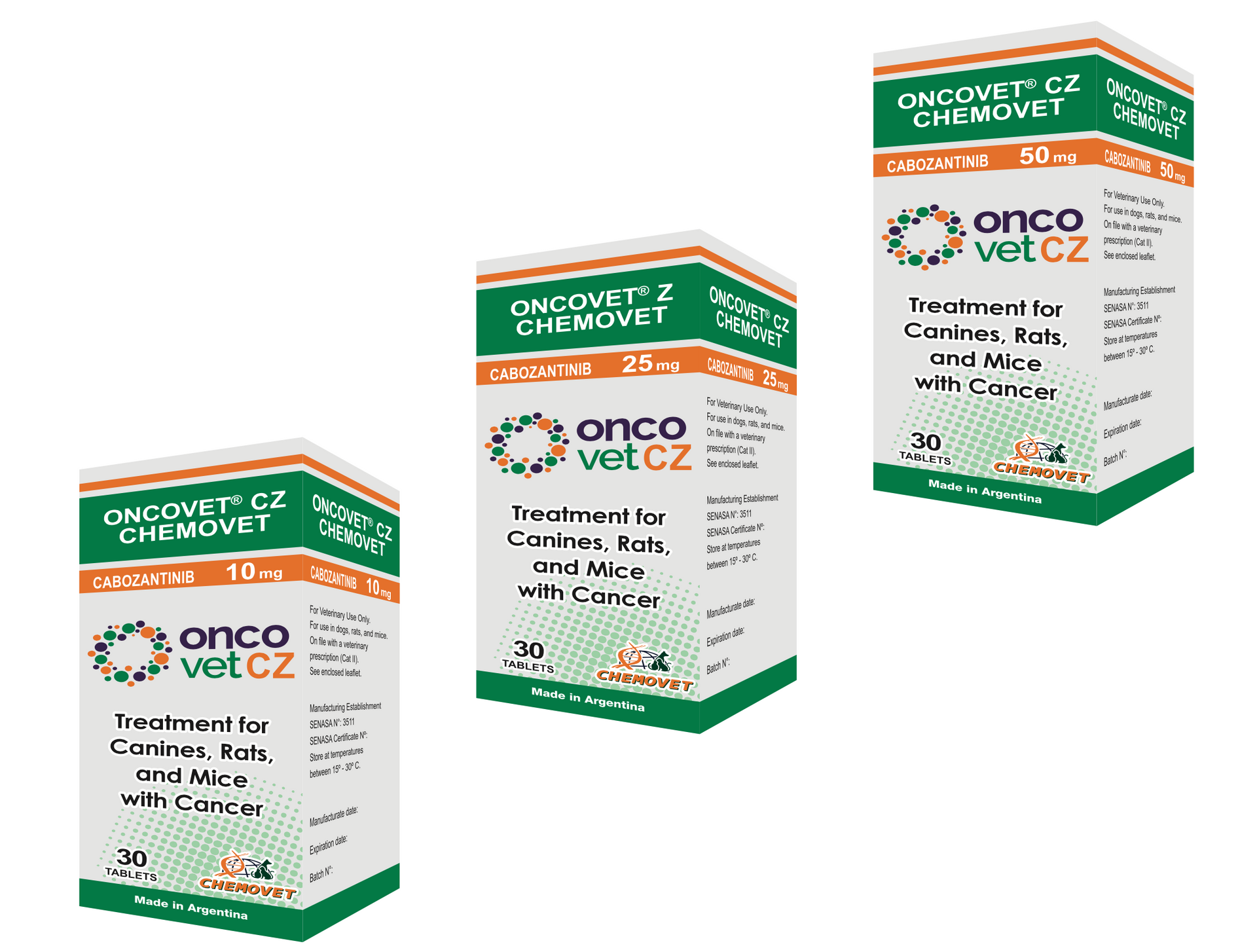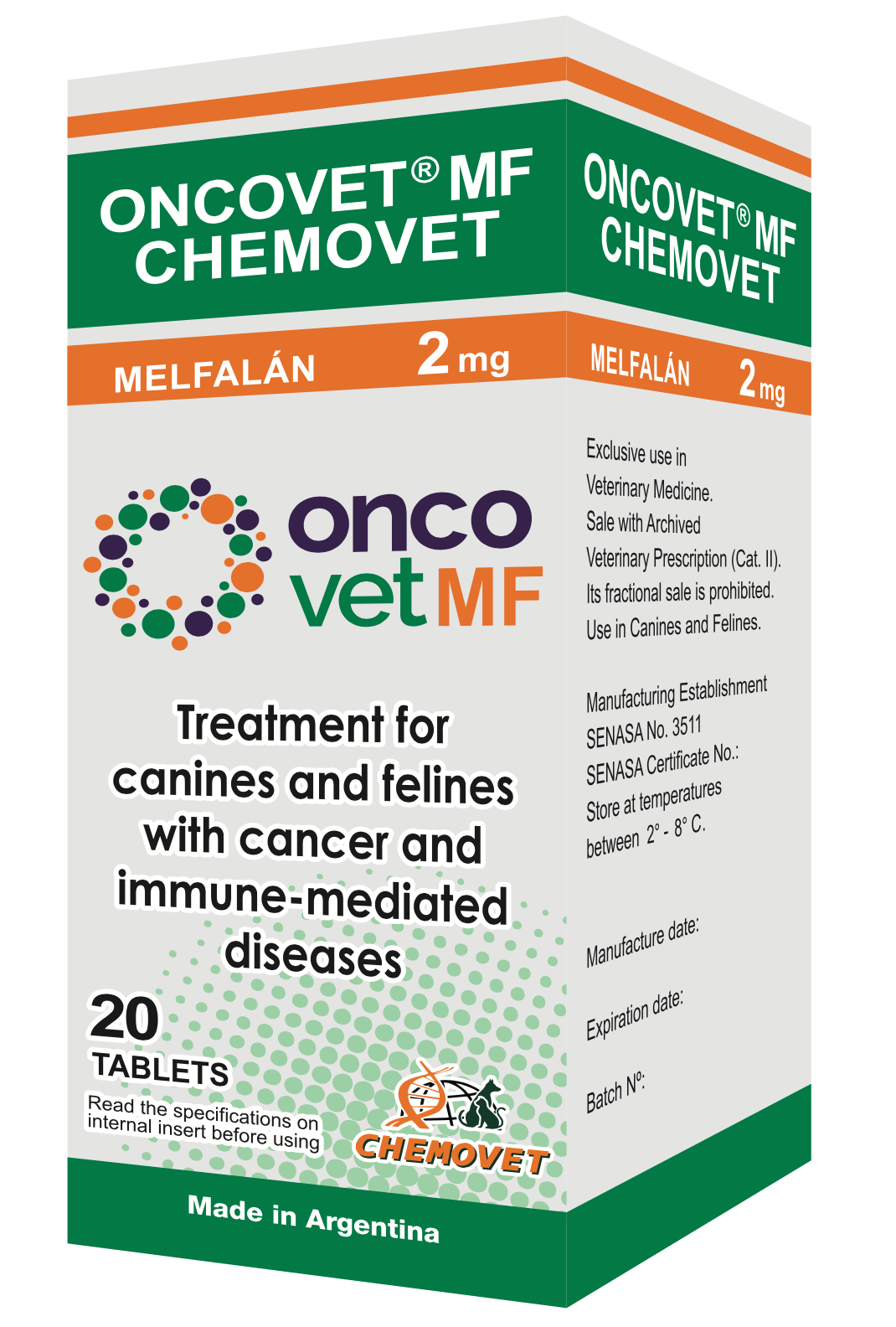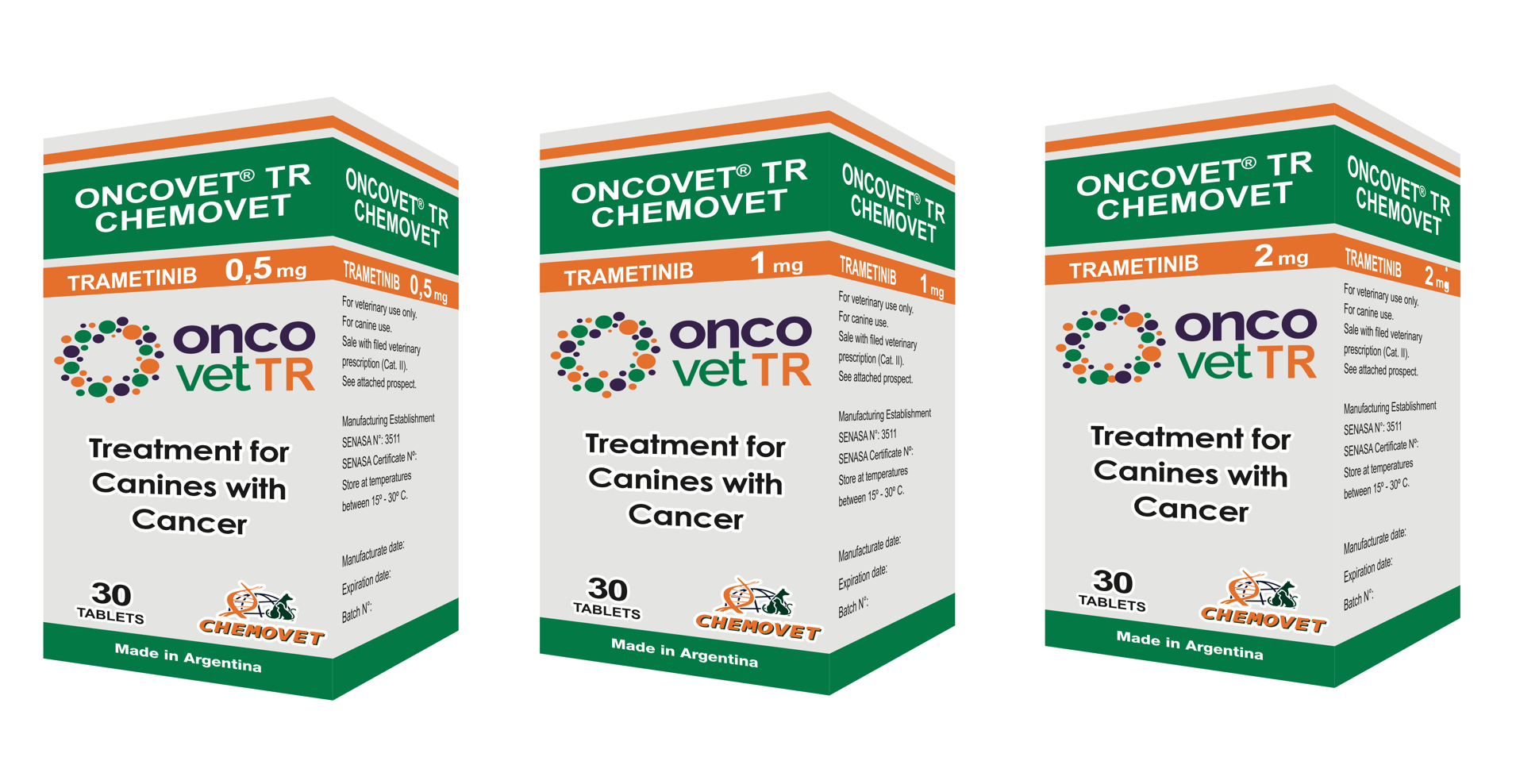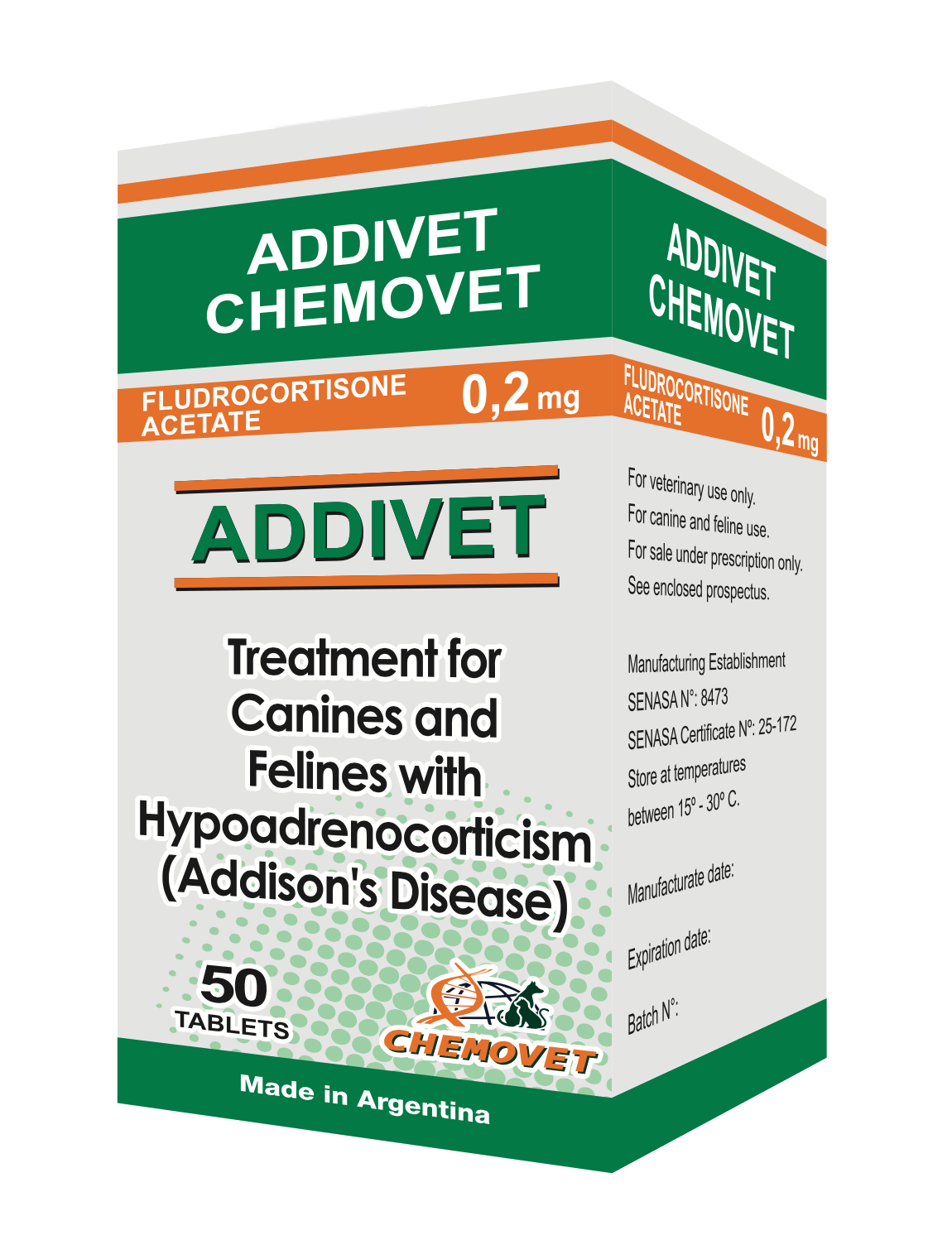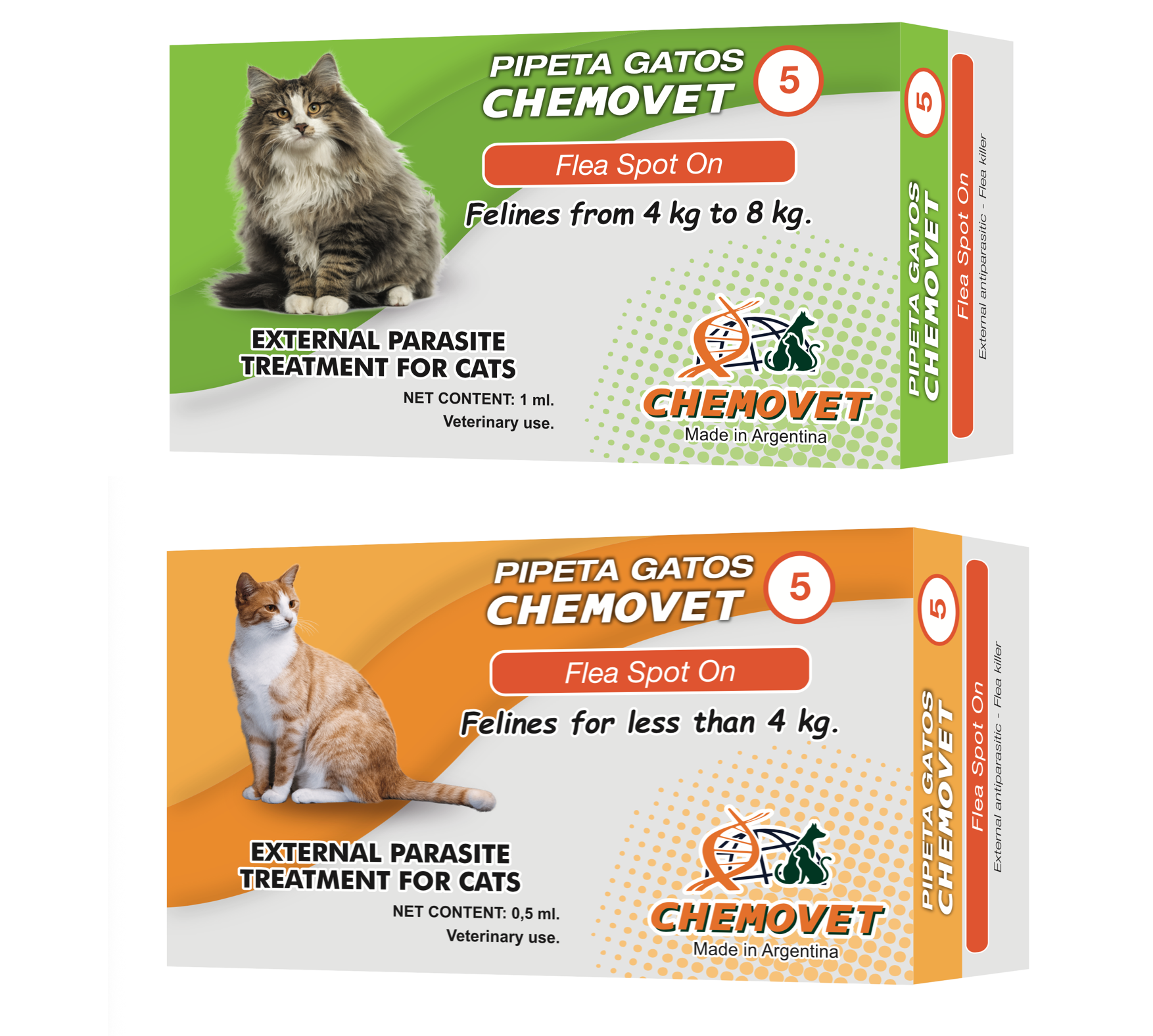LEADERS IN VETERINARY ONCOLOGY
Committed to the growth and development of veterinary oncology and endocrinology in the world
VETERINARY PET SUPPLEMENTS AND NUTRACEUTICALS
Veterinary Pet Supplements and Nutraceuticals are products that contain food ingredients intended to supplement the diet. These aren’t presented as a substitute for a conventional food, nor as the only component of a meal or of the diet.
Indications: Many applications of dietary supplements have scientifically based therapeutic indications.
CHEMODERM PLUS (1 gram and 2 grams)
-
Read more
Dietary supplement in animals that need to maintain healthy and healthy skin, hair and skin appendages. Patients recovering from different dermatopathies such as atopy, allergies, infections, parasitic infestations, otitis, dry and irritated skin and/or pruritus.
TARGET SPECIES: Dogs.
INDICATIONS FOR USE: Dietary supplement in animals that need to maintain healthy skin, hair and skin appendages. Patients recovering from different dermatopathies such as atopy, allergies, infections, parasitic infestations, otitis, dry and irritated skin and/or pruritus. Antioxidant. Its natural ingredients facilitate detoxification and elimination of free hydroxy radicals. Dietary supplement with vitamins, minerals and trace elements. Improves the activity and functionality of the immune system. Finally, it improves the quality of life of the patient with dermatopathies.
METHOD OF ADMINISTRATION: Orally.
COMPONENTS:
- Garlic dry extract (Allium Sativa)
- Dry extract of cat's claw (Uncaria tomentosa)
- Calendula dry extract (Calendula Officinales)
- Yucca dry extract (Yucca Schidigera)
- Avocado dry extract (American Persea)
- Vitamin E acetate 50% DC
- Vitamin C (ascorbic acid)
- Zinc Gluconate
- Cyanocobalamin (Vitamin B 12)
GENERAL CHARACTERISTICS OF COMPONENTS:
- Garlic dry extract (Allium Sativa): Allium sativa, garlic, is a species traditionally classified within the Liliaceae family but which is currently located in the Amaryllidaceae family, although this point is highly disputed. It is a sterile species with wide morphological and physiological variability and, in light of molecular studies, it is highly probable that it originates from western and middle Asia through its parent Allium longiscupis, and that it was introduced from there to the Mediterranean, and then to other areas, where it has been cultivated for more than 7,000 years. It is a perennial plant with flat, thin leaves, up to 30 cm long. Roots easily reach depths of 50 cm or more. The bulb, with white skin, forms a head divided into segments that are commonly called teeth. Each head can contain from 6 to 12 teeth, each of which is wrapped in a thin layer of white or reddish color. Each of the cloves can give rise to a new garlic plant, since these have a terminal bud at their base that is capable of germinating even without the need to plant it beforehand. This bud begins to appear after three months of harvesting, depending on the variety and storage conditions. Flowers are white, and in some species the stem also produces small bulbs or shoots.
Garlic dry extract provides anti-inflammatory benefits. One of the most well-known benefits of garlic is its ability to decrease inflammation. Although the body's inflammatory response is essential to keeping it healthy, chronic inflammation is linked to the progression of many diseases, including canine and feline skin diseases. The dry extract of garlic (Allium Sativum) can help treat external otitis in dogs and cats. Garlic contains potent anti-inflammatory plant compounds that can help inhibit pro-inflammatory proteins associated with chronic inflammation. These contain different types of anti-inflammatory organosulfur compounds such as:
S-allyl-L-cysteine sulfoxide (alliin), derivatives of γ-glutamyl cysteine and diallyl disulfide (DADS).
These can also reduce pro-inflammatory proteins such as: tumor necrosis factor alpha (TNF-α), interleukin-6 (IL-6) and high-sensitivity C-reactive protein (hs-CRP).
It may protect against cell damage from oxidative stress that occurs when there is an overload of reactive oxygen species (ROS) molecules. Additionally, it can promote a healthy immune response. Garlic dry extract has powerful antiviral and antimicrobial properties. Therefore, adding them to your diet can help keep your immune system healthy. Garlic contains compounds, such as allicin and diallyl sulfide, that may help enhance immune cell activity.
- Dry extract of Cat's Claw (Uncaria tomentosa): Uncaria tomentosa, popularly called cat's claw, is a climbing plant of the Rubiáceas family native to Ecuador, Colombia, Peru and Bolivia. It has a woody, thin and climbing trunk, which can exceed 40 meters in length and can reach 20 meters in height. Its leaves are opposite, oval and with an entire margin, with parallel veins. These leaves sit on the stem on a short petiole. Above its insertion, curved and reflex spines grow -directed in the opposite direction to the growth of the stem- that serve to anchor it. Its common name alludes to those thorns. Cat's claw contains several powerful compounds such as phenolic acids, alkaloids, flavonoids, quinovic acid, phytosterols that can promote health and well-being. Cat's claw contains 7 alkaloids, the most important and in the largest quantity is Isopteropodin, which contributes to improving the immune system and fighting free radicals that deteriorate cells. This makes cat's claw have an anti-inflammatory, antimutagenic, antiviral, antioxidant, immunostimulating, analgesic and diuretic action. Cat's claw may support your immune system, helping to fight infections more effectively. Its anti-inflammatory properties could be responsible for its immune benefits. Dried extracts of cat's claw are very useful for patients with problems related to all kinds of allergies. This is perhaps one of the most widespread uses, given the spread of allergies related to environmental changes in recent decades, as well as dietary changes and their reactions.
These extracts also have a powerful healing effect. Added to its anti-inflammatory effect, it is very useful for treating small wounds, such as scratches, scrapes, superficial burns, cuts, and more.
- Calendula dry extract (Calendula Officinales): Calendula (Calendula officinalis) is an annual, erect and aromatic bush that extends from 50 to 70 cm. The generic name calendula derives from the Latin calendula, which means "throughout the months", with which we wanted to underline the long flowering period of the plant, and the specific name officinalis expresses its medicinal character.
This flower is ornamental and grows near urban populations. For this reason, it has been widely used in homes, either as a yellow dye or as a substitute for saffron in the kitchen. It has antiseptic, anti-inflammatory and healing actions. Already more than 3,000 years ago, Egyptians considered the marigold a "miraculous" plant and, later, Greeks and Romans used it to cure many of their diseases or ailments, including insect bites, rubbing the flower against the area inflamed. Today, this yellow-orange plant, decorative in gardens and parks, has many medicinal uses. Helps reduce pain and inflammatory processes. It is regenerative and healing. It has properties that help heal wounds, burns, ulcers, various dermatoses and eczema faster. It increases the amount of blood that flows to injured parts of the body and provide assistance in the production of collagen, whose main function is to repair damaged skin tissues. It is a great stimulator of collagen production. Protector against free radicals due to its high content of antioxidants, which interrupt the normal growth of cells in the human body. Calendula extract possesses several powerful antioxidants, including triterpenes, flavonoids, polyphenols, and carotenoids. Among the most important and powerful antioxidants are flavonoids.
In addition, it has anti-inflammatory compounds, such as tumor necrosis factor alpha (TNFα). While inflammation is a normal bodily response, the chronic inflammation seen in different skin diseases in dogs and cats can be serious. Calendula extract is known for its natural antifungal and antimicrobial properties.
Calendula can help treat external otitis in dogs and cats, as well as oral conditions, such as gingivitis. Gingivitis, which is characterized by chronic inflammation of the gums, is one of the most common oral diseases in felines. Calendula extracts can reduce the number of microorganisms in the oral cavity and inflammation.
- Yucca dry extract (Yucca Schidigera): The Yucca Schidigera is a species of shrub belonging to the Agavaceae family popularly known as Spanish Dagger, Peruvian Chamagra. It is a plant that reaches 0.5-2.5 m in height, usually with several stems from the base, branched, with rhizome and leaves 0.3-0.5 m long and 2-3.5 cm wide, dark green or pale grayish green with entire or rarely denticulate margins, acuminate with a brown terminal thorn. Inflorescences in panicles 0.6-1.5 m tall, with numerous bell-shaped, stalked white flowers, sometimes tinged with purple or red, 3.5 cm long. The fruit is green and brown when ripe, indehiscent 5-8 cm long and 2.5 cm wide with black seeds. Yuccas are common garden plants with spiky leaves. There are many species of plants and fruits, seeds and flowers are often eaten. The yucca shouldn’t be confused with cassava, which is a tuber. Cassava offers numerous health benefits and is often used medicinally. Some parts of the cassava plant can be incorporated into your diet. Boosts Immunity: Cassava contains high amounts of vitamin C and antioxidants, both of which can benefit the immune system and overall health. Vitamin C stimulates the production and activity of white blood cells, which fight infections and viruses. Antioxidants that cassava contains protect us from cell mutations and damage from destructive molecules called free radicals. Benefits skin health: Cassava provides multiple benefits for the skin. Studies have shown that cassava has photoprotective properties and may protect against sun damage. The folic acid found in cassava can help improve the overall health of the skin and eyes. High amounts of vitamin C also aid in the production of collagen, the main protein in the skin. Inhibits oxidative stress: Oxidative stress can cause serious damage to our bodies. There is evidence that cassava compounds, including antioxidants, help protect our bodies from oxidative stress.
- Avocado dry extract (American Persea): The American Persea, popularly called avocado (Argentina, Bolivia, Chile, Peru and Uruguay) or avocado tree (Dominican Republic, Puerto Rico and Venezuela), is an arboreal species of the genus Persea belonging to the Lauraceae family, whose fruit, the avocado is an edible berry. It is a species native to Mesoamerica, specifically from the high parts of central and eastern Mexico, Guatemala and El Salvador. The oldest evidence of its use was found in Coaxcatlán (Mexico) and dates back about 10,000 years. Currently, the species is cultivated in places with tropical and Mediterranean climates throughout the world. The great demand for avocado has made its plantations transform large extensions of native ecosystems. In the wild, the tree can reach heights of around 20 m, most commonly 8-12 m, and a diameter at breast height of 30-60 cm, with an erect or twisted trunk. Trees in plantation, generally derived from grafts and subjected to formative pruning, show a very different appearance. Crown: spreading, globular or bell-shaped, with low branches, young branches at first, yellowish-green, later becoming dull and with prominent leaf scars. Bark: rough, sometimes furrowed longitudinally. This fruit is prized for its high nutritional value and is added to various dishes due to its good flavor and rich texture. Avocado is a high-fat food. In fact, 77% of its calories come from fat, making it one of the fattiest plant foods out there. Most of the fat in avocado is oleic acid, a monounsaturated fatty acid that is also the main component of olive oil and is believed to be responsible for some of its health benefits. Oleic acid has been associated with a reduction in inflammation. Avocado fats are also quite resistant to heat-induced oxidation. Avocados are very nutritious and contain a wide variety of nutrients, including 20 different vitamins and minerals such as vitamins A, B1 (thiamine), B2 (riboflavin), B3 (niacin), B5 (pantothenic acid), B6 (pyridoxine) , Vitamin C, Vitamin E and Vitamin K. It also contains small amounts of folate, potassium, magnesium, manganese, selenium, copper, iron, zinc, phosphorus and calcium, essential to keep the skin, hair and skin attachments in the best state of health. But when it comes to nutrients, its intake isn't the only thing that matters, it also need to be able to absorb these nutrients – move them from its digestive tract into its body, where it can be used. It has been shown that avocado dry extract can increase the absorption of antioxidants from 2.6 to 15 times. Therefore, avocado is not only highly nutritious, but it can drastically increase the nutritional value of other foods you eat. Furthermore, these not only increase the absorption of antioxidants from other foods, but are also rich in antioxidants. This includes the carotenoids lutein and zeaxanthin, which are incredibly important for the health of all skin.
- Vitamin E: Vitamin E is called a group of eight fat-soluble compounds that include four tocopherols and four tocotrienols. These tocopherols and tocotrienols exist as α (alpha), β (beta), γ (gamma) and δ (delta) homologues. Due to their lipid antioxidant function, these vitamin E compounds are found in plant foods rich in fats, especially unsaturated, such as oilseeds, and to a lesser degree in cereal grains. Its concentration in these foods is highly variable and its stability, due to its antioxidant action, is very low. Each of these compounds has a different activity in the body. Most active vitamin E compounds in the body are those related to the α-tocopherol form.
Vitamin E has a fundamental role in the normal metabolism of all cells. It is the most important fat-soluble antioxidant in human and animal tissues. It is found in lipid-rich parts of cells, such as cell membranes, and fat-rich tissues. The main and most studied role of vitamin E is the protection of lipid polyunsaturated fatty acids against oxidative damage. That is why its deficiency can affect several important vital functions. Vitamin E belongs to the family of polyprenoid compounds. In its natural state it has eight different forms of isomers: four tocopherols and four tocotrienols. All of these have an aromatic ring, called chroman, with a hydroxyl group and a saturated polypronoid chain. If said chain is saturated, isomers are tocopherols, and if it is unsaturated, those are tocotrienols. Alpha α, beta β, gamma γ, and delta δ forms exist for both isomers, and is determined by the number of methyl groups on the aromatic ring. Each of the forms has its own biological activity. All actions of tocopherols seem to be determined by their character as an antioxidant agent, and that, in particular, prevents lipid peroxidation reactions (rancidity). The rancidity of unsaturated lipids consists of a complex series of reactions. In the end, oxygenated radicals in turn give rise to a series of compounds (aldehydes, acids and ketones) that are responsible for the unpleasant characteristics of rancid products, such as bad smell. In addition, these induce alterations in other structures (membrane proteins, for example) that seriously compromise their function. Tocopherols act by breaking the chain of reactions, acting in such a way that these offer an easily subtractable hydrogen to oxygen radicals, thus preventing it from being subtracted from lipids and membrane.
- Vitamin C (Ascorbic Acid): Sodium Ascorbate is a sodium salt of ascorbic acid (vitamin C) and has the molecular formula: C6H7NaO6. It is used in the food industry for its antiseptic, antioxidant, and preservative functions.
Vitamin C is useful in the prevention and treatment of different dermatopathies. It acts as an antioxidant, neutralizing free radicals, and as an immunomodulator. It improves the activity of leukocytes and protects them from oxidative damage derived from its cytolytic activity. Vitamin C is also essential in the formation of collagen: together with proline and lysine, it reinforces the extracellular matrix. Vitamin C protects extracellular environment by neutralizing the radical its peroxide, hydroxyl, and peroxynitrite. Vitamin C has been reported to improve the clinical appearance of photodamaged skin and increase the synthesis of elastin and collagen fibers.
- Zinc Gluconate: Zinc gluconate is the salt that is formed by the combination of zinc with gluconic acid and has the chemical formula C12H22O14Zn. Zinc gluconate is used as a way to supply zinc due to its good assimilation, since zinc gluconate is an organic complex that is easier to absorb than elemental zinc. Zinc gluconate is one of the most popular and widely used forms of dietary zinc and is made from an industrial manufacturing process in which glucose is fermented.
Among functions of zinc, its antioxidant capacity stands out, it is involved in protein synthesis, cell growth or wound healing. Physical-Chemical Data: White or almost white powder or granules. Soluble in water, very slightly soluble in ethanol.
Properties and uses: Zinc is an essential element of nutrition, presenting itself as traces in a large number of foods. It is a constituent of numerous enzymatic systems, being found in all tissues.
Zinc is incompletely absorbed in the digestive tract, with a bioavailability of 20-30%. It is distributed mainly in bone, muscle, skin, and prostatic fluid. It is mainly excreted in feces. Zinc gluconate brings vitality to the hair, protects your skin. Zinc helps stop hair loss and strengthen the hair fiber; It also helps to stimulate its growth, protects the hair bulb and prevents its subsequent fall. By promoting the synthesis of keratin and collagen, it prevents premature aging of the hair and protects its pigmentation. Since it participates in the constitution of keratin, an essential protein also of the nails, it favors their strengthening. Some studies relate zinc deficiency to skin problems such as atopic dermatitis, making it a very important trace element in the recovery of canine and feline patients with atopy. In addition, it is used as a supplement in cases of zinc deficiency, for example, alopecia, malabsorption syndrome, in conditions with high weight loss, and in enteropathic acrodermatitis, usually administered orally. Zinc Gluconate accelerates wound healing and helps the body transform essential fatty acids used by the skin for healing. It has the ability to inhibit bacterial proliferation. Zinc improves functions of cellular immunity, as well as the activity of natural killer cells. It acts as an antioxidant, induces anti-inflammatory cytokines. Zinc is also involved with the physiological processes of senses of taste and smell. The deficiency of this trace element can cause health problems such as skin diseases, impaired growth rate, delayed sexual maturation, hypogonadism, oligospermia, dysgeusia (taste disturbance), immune system dysfunction, and poor wound healing. It is a zinc chelated with EDTA (ethylenediaminetetraacetic) acid.
- Cyanocobalamin (Vitamin B12): Vitamin B12 has a key role in the metabolism of folic acid. Its essential function is the demethylation of methyltetrahydrofolate and the methylation of Hcy. This step is essential for the regulation of THF, which is involved in DNA synthesis. In the absence of demethylation, signs of folate deficiency occur. Furthermore, vitamin B12 is required for myelin synthesis, as demonstrated by the severe neuronal abnormalities experienced in pernicious anemia. Several milligrams of vitamin B12 can be stored in the body and prevent deficiency for several years. Vitamin B12 plays an important role in the synthesis of cellular DNA and RNA, acting as an enzymatic cofactor. Its deficiency usually manifests itself subacutely from the extinction of body reserves. It may be due to a nutritional problem, absence of intrinsic factor, achlorhydria, ileal disease, malnutrition, malabsorptive syndromes, among others. Both diagnosis and treatment are of great clinical relevance, mainly due to the progressive hematological and neurological compromise. Within the cutaneous manifestations due to its deficiency, the following have been described: generalized hyperpigmentation and nail alterations mainly. There is still controversy regarding the pathophysiology of hyperpigmentation.
ADMINISTRATION SCHEME
Presentation of 1 g:
Recommended dose: 1 tablet every 15 kg of b.w. every 24 hours
Minimum dose: 1 tablet every 20 kg of b.w. every 24 hours
Maximum dose: 1 tablet every 10 kg of b.w. every 24 hours
Presentation of 2 g:
Recommended dose: 1 tablet every 30 kg of b.w. every 24 hours
Minimum dose: 1 tablet every 40 kg of b.w. every 24 hours
Maximum dose: 1 tablet every 20 kg of b.w. every 24 hours
STRENGTH:
CHEMODERM PLUS (30 tablets) - 1 gram tablets in a non-breakable cardboard box with 3 blister packs and a leaflet. Each blister contains 10 tablets.
CHEMODERM PLUS (30 tablets) - 2-gram tablets in a non-breakable cardboard box with 5 blisters and a leaflet. Each blister contains 6 tablets.
CARDIOCHEM (1 gram and 2 grams)
-
Read more
TARGET SPECIES: Dogs.
INDICATIONS FOR USE:
Primary Indications: CARDIOCHEM is a dietary supplement formulated with a unique blend of plant extracts, vitamins, and polyunsaturated fatty acids for canines that require a healthy cardiovascular system. CARDIOCHEM contains ingredients based on natural products that facilitate detoxification and the elimination of free hydroxy radicals. CARDIOCHEM compensates for nutritional deficiencies (mainly vitamins, minerals, and trace elements). CARDIOCHEM supports the functionality of the cardiovascular system, the immune system, and nutritional deficiencies. CARDIOCHEM is a dietary supplement that contains a rich source of Omega 3 and Omega 6 fatty acids, which are very important for maintaining good cardiovascular health and a healthy immune system.
Ultimately, CARDIOCHEM improves the quality of life of patients with cardiovascular system conditions. Adjuvant supplement to complement the diet of animals predisposed to cardiovascular disease. Indicated for deficiency states and/or metabolic disorders that affect cardiac function.
ADMINISTRATION METHODS: Oral.
Components: Garlic dry extract (Allium Sativa), Black seed dry extract (Nigella Sativa), Hawthorn dry extract (Crataegus monogyna), Pomegranate extract (Punica granatum), DHA (Docosahexaenoic Acid) + EPA (Eicosapentaenoic Acid) - (fish oil powder), Grape Seed dry extract, Vitamin E acetate 50% DC, Vitamin C (ascorbic acid), Coenzyme Q10, Cyanocobalamin (Vitamin B 12).
Use in Canines.
Made in Argentina.
Keep out of the reach of children and pets.
The containers used must be discarded in accordance with current local legislation.
Store at temperatures between 15° and 25ºC.
ONCOVET FUNGI (1 GRAM AND 2 GRAMS)
-
Read more
ONCOVET FUNGI
INDICATIONS FOR USE: ONCOVET FUNGI is a dietary supplement for cancer patients. It is formulated with a unique blend of extracts, vitamins, and naturally occurring compounds that facilitate detoxification and elimination of free hydroxy radicals in patients undergoing chemotherapy and/or radiation therapy. It compensates for nutritional deficiencies. It improves immune system activity. It contains substances with anticancer, adaptogenic, and hepatoprotective properties that help improve energy and endurance, and promote health and longevity. Ultimately, it improves the quality of life of cancer patients.
TARGET SPECIES: Dogs and Cats.
CHARACTERISTICS OF THE INGREDIENTS: General Considerations
Dried edible mushroom extracts are powdered concentrates obtained from fresh or dried mushrooms, using various extraction and drying processes. These extracts are valued for their high concentration of nutrients and bioactive compounds, making them popular in dietary supplements and health products. The following are the general characteristics of dried edible mushroom extracts:
High Concentration of Nutrients and Bioactive Compounds:
Dried mushroom extracts contain a high concentration of nutrients and bioactive compounds present in fresh mushrooms, such as polysaccharides (including β-glucans), triterpenes, antioxidants, B vitamins, vitamin D, and minerals such as selenium. These compounds are responsible for many of the health benefits associated with mushrooms.
Convenient and Stable Format:
Being a dry powder, mushroom extracts are easy to store and have a long shelf life compared to fresh mushrooms. They are less susceptible to spoilage and nutrient loss, making them a convenient option for use in tablet dietary supplements.
Enhanced Effects:
Due to their concentrated nature, dried extracts can provide the benefits of mushrooms in smaller doses without the need to consume large quantities of fresh mushrooms.
Easy Incorporation into Dietary Supplements:
Dried mushroom extracts are versatile and can be easily incorporated into a variety of products, such as tablet dietary supplements. Their tablet format allows for precise dosing and seamless integration.
Produced Using Specialized Extraction Methods
Dried extracts are obtained through extraction processes that may include the use of water, alcohol, or a combination of both, followed by spray drying or freeze-drying. These methods allow the bioactive compounds to be concentrated without damaging their integrity, ensuring maximum potency and efficacy of the extract.
Health and Wellness Applications:
Dried edible mushroom extracts are widely used in natural medicine and the healthcare industry to support various bodily functions. Depending on the mushroom, extracts may support the immune system, act as antioxidants, anticancer agents, adaptogens, hepatoprotective agents, improve energy and stamina, or promote health and longevity.
Safety Profile and Side Effects:
Generally, dried mushroom extracts are safe for animals when used at the recommended doses. However, since they are concentrated, it is important to follow the dosage instructions, especially to avoid potential side effects such as digestive upset or allergic reactions.
Conclusion: Dried edible mushroom extracts represent a concentrated and convenient way to take advantage of the nutritional and therapeutic benefits of mushrooms. With their high concentration of bioactive compounds, easy incorporation into supplements and foods, and long-term stability, these extracts are a valuable tool in the field of health and wellness.
Mushrooms offer a promising approach as a complement to cancer treatment, thanks to their immunomodulatory, antioxidant, and anticancer properties. However, it is crucial that their use be part of an integrated approach supervised by a veterinarian.
General Characteristics of the Ingredients:
- Turkey Tail Dry Extract (Trametes Versicolor): Also known as Coriolus versicolor or Yunzhi in traditional Chinese medicine, this mushroom is widely recognized for its potent immunomodulatory and antioxidant properties.
This mushroom has been the subject of numerous scientific research studies, especially in cancer prevention.
Distinctive Appearance:
The name "Turkey Tail" is derived from its unique appearance. The mushroom's fruiting bodies feature concentric bands of different colors, ranging from shades of brown, gray, white, black, and blue, resembling the feathers of a turkey tail. Its shape is semicircular or fan-shaped, with a soft, velvety texture.
Bioactive Composition:
Trametes versicolor is rich in polysaccharides, particularly PSK (Krestin) and PSP (polysaccharide-peptide), which are the main bioactive compounds responsible for its properties. It also contains antioxidants, triterpenes, sterols, and other phenolic compounds that contribute to the nutrition and well-being of cancer patients.
Potent Immunomodulator:
This mushroom is known for its ability to strengthen the immune system. The polysaccharides PSK and PSP stimulate the activity of immune cells, such as macrophages, T lymphocytes, and NK (natural killer) cells, which play a crucial role in defending against infections and in the antitumor response.
Use in patients undergoing cancer therapy:
Turkey tail has been widely studied for its potential in patients undergoing cancer treatment. In Japan and China, PSK and PSP have been used as adjuvants in cancer treatment, in combination with chemotherapy and radiotherapy. These compounds have shown adjuvant effects in inhibiting tumor growth, reducing metastasis, and improving survival in cancer patients.
Antioxidant Properties:
Trametes versicolor has strong antioxidant properties, which help combat oxidative damage in cells. This antioxidant effect is essential for cell protection and the prevention of chronic diseases, such as cancer. Digestive Health Support:
This mushroom is also known for its digestive health benefits. The prebiotic compounds present in Turkey Tail promote the growth of beneficial bacteria in the gut, contributing to a healthy gut microbiome and improving overall digestive function.
- Maitake (Grifola Frondosa) Dry Extract: Maitake (Grifola frondosa) is an edible mushroom known for its immunomodulatory properties and potential health benefits, especially for cancer patients. The name "Maitake" means "dancing mushroom" in Japanese, due to the legend that those who found it in the wild would begin to dance with joy, given its high medicinal value. This mushroom grows in clusters, with a fan-shaped structure, and is brown or grayish in color. It can reach a considerable size, often weighing several kilograms.
Nutrient Richness:
Maitake is low in calories and fat, but is a good source of dietary fiber, protein, and several essential micronutrients such as B vitamins (B1, B2, B3, B5), vitamin D, copper, potassium, and selenium. It also contains a large amount of polysaccharides, particularly β-glucans, which are responsible for many of its health benefits.
Potent Immunomodulatory Properties:
The polysaccharides, especially the D-fraction, present in maitake are known for their ability to stimulate the immune system. These compounds activate various immune cells, such as macrophages, T lymphocytes, and NK (natural killer) cells, which improves the body's response to infections and diseases, including cancer.
Anticancer Effects:
Maitake has been studied for its potential anticancer effects. Research indicates that its compounds can
inhibit the growth of certain types of cancer, promote apoptosis (programmed cell death) in tumor cells,
and reduce the side effects of chemotherapy.
Antioxidant and Anti-inflammatory Properties:
This mushroom is rich in antioxidants that help neutralize free radicals, protecting cells from oxidative damage.
Additionally, its anti-inflammatory properties contribute to the reduction of chronic inflammation, which is associated with
various degenerative diseases.
Propiedades hepatoprotectoras:
Posee potentes propiedades hepatoprotectoras, que incluyen la protección contra el daño oxidativo y la inflamación, la
mejora de la función hepática, la promoción de la regeneración celular, y la prevención de daños por toxinas. Estos
beneficios hacen que Maitake sea un valioso recurso en el apoyo a la salud del hígado, especialmente en la prevención y en
animales que estan en tratamiento con drogas oncológicas de metabolización hepática.
- Extracto seco de Shiitake (Lentinula Edodes): Shiitake (Lentinula edodes) es uno de los hongos comestibles más conocidos
y utilizados en todo el mundo, especialmente en la cocina asiática. Además de su valor culinario, el shiitake es también
apreciado por sus propiedades en la salud, lo que lo convierte en un ingrediente importante en la alimentación y nutrición.
Perfil Nutricional:
Shiitake es bajo en calorías y rico en fibra, proteínas, y varios micronutrientes esenciales. Es una fuente excelente de
vitaminas del grupo B, como B2 (riboflavina), B3 (niacina), B5 (ácido pantoténico), y B6. También es una fuente significativa
de vitamina D, especialmente cuando se expone a la luz solar durante su crecimiento. Contiene minerales como selenio,
cobre, y zinc, que son importantes para la salud inmunológica y antioxidante.
Composición Bioactiva:
El shiitake es rico en compuestos bioactivos, incluyendo lentinano (un polisacárido β-glucano con potentes efectos
inmunomoduladores), eritadenina (un compuesto que puede ayudar a reducir los niveles de colesterol), y antioxidantes
como los polifenoles y los triterpenos. Estos compuestos contribuyen a sus beneficios para la salud.
Propiedades Inmunomoduladoras:
Shiitake es conocido por su capacidad para fortalecer el sistema inmunológico. El lentinano, en particular, ha sido estudiado
por su capacidad para estimular la actividad de las células inmunitarias, como los macrófagos y las células NK (natural killer),
que juegan un papel crucial en la defensa contra infecciones y en la respuesta antitumoral.
Propiedades Anticancerígenas:
Estudios han mostrado que los compuestos bioactivos del shiitake, como el lentinano, tienen propiedades anticancerígenas.
Se cree que estos compuestos pueden inhibir el crecimiento tumoral, mejorar la respuesta inmunológica del cuerpo frente
a las células cancerosas, y potenciar los efectos de los tratamientos contra el cáncer.
- Extracto seco de Reishi (Ganoderma Lucidum): Reishi (Ganoderma lucidum), también conocido como el "hongo de la
inmortalidad" o "Lingzhi" en la medicina tradicional china, es uno de los hongos más venerados en Asia y en todo el mundo.
Es conocido por sus amplias propiedades, que incluyen efectos inmunomoduladores, antioxidantes y adaptógenos.
Composición Bioactiva:
Reishi es rico en compuestos bioactivos, incluyendo triterpenos (ácidos ganodéricos), polisacáridos (especialmente
β-glucanos), esteroles, peptidoglucanos, y antioxidantes. Estos compuestos son los responsables de sus efectos en la salud.
Los triterpenos, en particular, le otorgan un sabor amargo característico y son conocidos por sus propiedades antiinflamato-
rias y anticancerígenas.
Immunomodulatory Properties:
Reishi is widely recognized for its ability to strengthen the immune system. The polysaccharides present in this mushroom, especially β-glucans, stimulate the activity of immune cells, such as macrophages, T lymphocytes, and NK (natural killer) cells, which improves the body's response to infections and cancer.
Adaptogenic Effects:
As an adaptogen, reishi helps the body adapt to stress by balancing and regulating body systems to improve resistance to physical, emotional, and environmental stress. This can include improving mood, reducing fatigue, and promoting overall well-being.
Anti-inflammatory and Antioxidant Properties:
Reishi contains triterpenes and other antioxidants that help reduce chronic inflammation and combat oxidative damage in cells, which is crucial in the prevention of chronic diseases, including diseases such as cancer. These
antioxidant effects may also contribute to longevity and protection against premature aging.
Anticancer Properties:
Reishi has been studied for its anticancer effects. The mushroom's bioactive compounds, such as
polysaccharides and triterpenes, have shown potential in inhibiting tumor growth, inducing apoptosis
(programmed cell death) in cancer cells, and enhancing the immune response against cancer. It is also
used as an adjuvant in chemotherapy to reduce side effects.
Hepatoprotective:
Reishi has hepatoprotective properties, which may help protect the liver from damage caused by toxins,
medications, and diseases. It promotes liver cell regeneration and improves liver function.
- Sun Mushroom (Agaricus Blazei) Dry Extract: Sun Mushroom (Agaricus blazei), also known as Agaricus blazei Murill or Agaricus subrufescens, is a mushroom that has gained recognition for its potential health benefits, especially in the context of immunology and oncology.
Bioactive Composition:
Agaricus blazei contains several bioactive compounds, including polysaccharides such as β-glucans, proteoglycans, and triterpenes. These components are responsible for many of its therapeutic properties, including its ability to modulate the immune system, combat oxidative damage, and promote overall health.
Immunomodulatory Properties:
One of the main benefits of Sun Mushroom is its ability to strengthen the immune system. The β-glucans present in this mushroom stimulate the activity of immune cells, such as macrophages, T lymphocytes, and NK (natural killer) cells, improving the body's response to infections and diseases and boosting immune defenses.
Anticancer Benefits:
Agaricus blazei has been the subject of studies indicating its potential in cancer prevention and treatment.
Bioactive compounds, such as β-glucans, may inhibit cancer cell growth, induce apoptosis (programmed cell death), and enhance the effectiveness of cancer treatments such as chemotherapy and radiation therapy.
Antioxidant Properties:
This mushroom is rich in antioxidants, which help neutralize free radicals in the body, protecting cells from oxidative damage and reducing the risk of chronic diseases. The antioxidants in Agaricus blazei may also support cardiovascular and overall health.
Anti-inflammatory Properties:
Agaricus blazei exhibits anti-inflammatory effects, which may be beneficial in reducing inflammation in the body and treating chronic inflammatory diseases. This may include conditions such as arthritis and other autoimmune diseases.
Digestive Health Support:
The prebiotic compounds in Sun Mushroom may promote a healthy gut microbiome by encouraging the growth of beneficial bacteria in the digestive tract. This may contribute to better digestion and absorption of nutrients in cancer patients.
- Vitamin C (Ascorbic Acid): Sodium ascorbate is a sodium salt of ascorbic acid (vitamin C) with the molecular formula: C6H7NaO6. It is used in the food industry for its antiseptic, antioxidant, and preservative properties.
IUPAC Name: Sodium 2,3-Didehydro-L-threo-hexono-1,4-lactone enolate
Other Names: Monosodium ascorbate-Sodium L-ascorbate
Vitamin C is useful in the prevention and treatment of cancer. It acts as an antioxidant, neutralizing free radicals, and as an immunomodulator. It improves leukocyte activity and protects them from oxidative damage resulting from their cytolytic activity. Vitamin C is also essential for collagen formation: along with proline and lysine, it strengthens the extracellular matrix, thus hindering tumor cell invasion into surrounding tissues.
Made in Argentina.
Keep out of the reach of children and pets.
The containers used must be discarded in accordance with current local legislation.
Store at temperatures between 15° and 25ºC.
CHEMO FLORA (1 gram and 2 grams)
-
Read more
Therapeutic indications: CHEMO FLORA is a dietary supplement formulated with a unique mixture of probiotics, plant extracts, vitamins and minerals that help improve the correct balance of intestinal flora, so necessary for the functioning and health of the animal's gastrointestinal tract.
CHEMO FLORA is indicated for dogs and cats that are recovering from various gastrointestinal conditions and/or disorders, under stress, hospitalization, unbalanced diets, antibiotic treatment and/or intensive training, improving and maintaining the integrity of the intestinal ecosystem through balance in the composition of the intestinal flora. In this way, it collaborates with the strengthening of the activity and functionality of the immune system at the intestinal level and in the absorption and digestion of proteins, carbohydrates and fats.
Components: Dry extract of Milk Thistle (Cardus Marianus), Enterococcus Faeium, Saccharomyces boulardii, Dry extract of Mistletoe (Viscum Album), Dry extract of Dandelion (Taraxacum Officinale), Dry extract of Rosemary (Rosmarius Officinalis), Zinc Gluconate, Cyanocobalamin, Vitamin C (ascorbic acid).
Use in Canines and Felines.
Made in Argentina.
Keep out of the reach of children and pets.
The containers used must be discarded in accordance with current local legislation.
Store at temperatures between 15° and 25ºC.
ENDOCRINOPET (1 GRAM AND 2 GRAMS)
-
Read more
Dietary supplement in patients with diabetes, patients who require weight control and/or obesity prevention. Antioxidant. Hepatoprotective. Improves the activity and functionality of the immune system.
TARGET SPECIES: Dogs and cats.
INDICATIONS FOR USE
Primary Indications: Dietary supplement in patients with diabetes, patients who require weight control and/or obesity prevention. Antioxidant. Helps improve proper metabolism of carbohydrates, triglycerides and cholesterol. Natural anti-inflammatory (bearing in mind that obesity is a state of chronic inflammation). Its natural ingredients facilitate detoxification and elimination of free hydroxy radicals. Hepatoprotective. Improves the activity and functionality of the immune system. Finally, it improves the quality of life of patients with diabetes and/or overweight.
FORMS OF ADMINISTRATION: Orally.
FORMULATION:
ENDOCRINOPET for 15 Kg
Component:
- Turmeric dry extract (Turmeric Long): 100 mg
- Dandelion dry extract: 150 mg
- (Taraxacum Officinale): 50 mg
- Ginseng dry extract (Panax Ginseng): 100 mg
- Cinnamon dry extract (Cinnamomun Verum): 50 mg
- Solidago dry extract (Solidago Virgaurea): 50 mg
- Galega dry extract (Galega Officinalis): 100 mg
- L-carnitine: 100 mg
- Vitamin C (ascorbic acid): 50 mg
- Zinc gluconate: 10 mg
- Excipients c.s.p: 1000 mg
ENDOCRINOPET for 15 Kg
Component:
- Turmeric dry extract (Turmeric Long): 200 mg
- Dandelion dry extract (Taraxacum Officinale): 300 mg
- Ginseng dry extract (Panax Ginseng): 100 mg
- Cinnamon dry extract (Cinnamomun Verum): 200 mg
- Solidago dry extract (Solidago Virgaurea): 100 mg
- Galega dry extract (Galega Officinalis): 200 mg
- L-carnitine: 200 mg
- Vitamin C (ascorbic acid): 100 mg
- Zinc gluconate: 20 mg
- Excipients c.s.p: 2000 mg
GENERAL CHARACTERISTICS OF COMPONENTS:
-Turmeric dry extract (Turmeric Long): Turmeric, also called sulfur from the Indies, is a highly appreciated plant because it offers great gastronomic versatility and medicinal properties against cancer, high cholesterol or osteoarthritis, among other diseases, are attributed to it. It is native to southwestern India and belongs to the same family as ginger.
By grating and drying its rhizome -a stem that grows underground and horizontally- a yellow or orange powder is obtained that contains between 2 and 5% curcumin, a compound to which its health benefits are attributed. Curcumin reduces the production of inflammatory mediators and free radicals, which means that antioxidant and anti-inflammatory properties are popularly attributed to it, which would have beneficial effects in the treatment of diseases such as osteoarthritis, skin diseases, gastric ulcers, diabetes and even, cancer. Curcumin helps patients with diabetes as curcumin has been shown in various studies to lower blood glucose and cholesterol levels. Curcumin can prevent hepatic lipidosis. Curcumin suppressed activities of macrophages that cause chronic inflammation, the pathophysiological mechanism by which patients with diabetes and obesity progress with their disease. Curcumin improves the functionality of insulin. It reduces insulin resistance by helping insulin to enter cells, perhaps in the adenosine monophosphate kinase (AMP) pathway that exercise also opens. Curcumin protects beta cells, which produce insulin. There are studies that found that beta cells grew faster and lived longer in animals that consumed curcumin.
-Dandelion dry extract (Taraxacum Officinale): The dandelion is a family of flowering plants that grows in many parts of the world. These are also known as Taraxacum spp., although Taraxacum officinale is the most common species. In the practice of traditional herbal medicine, dandelion is revered for its wide range of medicinal properties. For centuries, these have been used to treat a wide variety of physical ailments, including diabetes, cancer, liver disease, and digestive disorders. In terms of nutritional content, dandelion extends to all parts of the plant (from root to flower). It is a very nutritious plant, loaded with vitamins, minerals and fiber. Dandelion greens serve as an excellent source of vitamins A, C, and K. These also contain vitamin E, folate, and small amounts of other B vitamins. Additionally, dandelion greens provide a substantial amount of various minerals, including iron, calcium, magnesium, and potassium. Dandelion root is rich in the carbohydrate inulin, which is a type of soluble fiber found in plants that supports the growth and maintenance of a healthy bacterial flora in your intestinal tract. Dandelion is full of powerful antioxidants, which may explain why this plant has such wide applications for health. Antioxidants are molecules that help neutralize or prevent the negative effects of free radicals in their bodies. Free radicals are products of normal metabolism, but these can be very destructive. The presence of too many free radicals contributes to the development of diseases and accelerated aging. Therefore, antioxidants are essential to keep the body healthy. Dandelion contains high levels of the antioxidant beta-carotene, which is known to provide strong protection against cell damage and oxidative stress. These are also rich in another category of antioxidants called polyphenols, which are found in the highest concentration in the flower, but are also present in the roots, leaves, and stems. Chicoric and chlorogenic acid are two bioactive compounds in dandelion. Those are found in all parts of the plant and can help lower blood sugar. Studies show that these compounds can improve insulin secretion from the pancreas while improving glucose uptake in muscle tissue. This process leads to improved insulin sensitivity and reduced blood glucose levels. Additionally, some of the bioactive compounds in dandelion may lower cholesterol, which may lower the risk of heart disease. Animal studies showed a drastic reduction in cholesterol and triglyceride levels treated with dandelion extract. Dandelion has a protective effect on liver tissue in the presence of toxic substances and stress. Dandelion extract may reduce levels of excess lipids stored in the liver and protect against oxidative stress in liver tissue. Some research indicates that dandelion and its bioactive components may support weight loss and maintenance. Dandelion to improve carbohydrate metabolism and reduce fat absorption can lead to weight loss and obesity prevention. Chlorogenic acid, a compound found in dandelions, was able to reduce body weight and levels of some fat storage hormones.
-Ginseng dry extract (Panax Ginseng): Ginseng, a plant from traditional Chinese medicine, is perhaps one of the most benefits attributed to it. It is known as "the king of plants", due to the amazing properties of ginseng, it has spread throughout the world. This perennial plant, which grows in humid and shady areas of the mountains, has been credited for more than 5,000 years with properties to improve very diverse functions. Its leaves are similar to those of rose bushes, although these are larger than those of rose bushes, and it has small reddish flowers that sprout in clusters at the end of the stem. The part of ginseng for medical use is its bulbous and anthropomorphic root, which reminds us of the figure of a little man, and can reach up to one meter in length, although the plant does not usually exceed 50 cm. Ginseng is the quintessential adaptogenic plant. Given its ability to adapt to difficult environments where other plants do not proliferate. With which for its survival it contains a high density of nutrients that favor its functioning. When consumed, it acts as a natural dietary supplement. Ginseng has the ability to increase physical and psychological resistance to adverse conditions such as stress, restoring balance and normalizing many metabolic functions of the body. The active ingredients responsible for the main actions of Panax ginseng are saponosides, better known as ginsenosides, as well as a group of polysaccharides called panaxosides. Ginseng root also contains other amounts, although to a lesser extent, of B vitamins, amino acids, essential oils, enzymes, and minerals. Ginseng is beneficial for blood glucose control in animals with and without diabetes. American and Asian ginseng have been shown to improve pancreatic cell function, increase insulin production, and improve tissue uptake of blood glucose. In addition, it has natural anti-inflammatory properties and provides antioxidant protection that reduces free radicals in the cells of animals with diabetes and obesity. Asian Ginseng (Panax ginseng) strengthens and improves the functionality of the immune system, which is also involved in the pathophysiology of diabetes and obesity. Taking into account that obesity is a state of chronic inflammation, Asian Ginseng (Panax ginseng) finally improves the quality of life of diabetic and obese patients.
- Cinnamon dry extract (Cinnamomun Verum): The cinnamon tree, known as cinnamon, (Cinnamomum zeylanicum or Cinnamomum verum J.Presl) is an evergreen tree, 10 to 15 meters tall, from Sri Lanka. Its inner bark is used as a spice, which is obtained by peeling and rubbing the branches. It requires a warm and humid climate, with an average annual temperature between 24 and 30 °C and a rainfall between 2,000 and 4,000 mm well distributed throughout the year, conditions that only occur between 0 and 600 mm. The best plants grow in rainy climates, in deep, sandy loam soils with a high organic matter content and excellent drainage. A very muddy soil would limit the growth of the plant and it would produce a poor quality bark. Regarding its chemical composition of Cinnamomun Verum, its aroma is due to the aromatic essential oil that constitutes 0.5-2.5% of its composition. The major component is cinnamic aldehyde, also eugenol and cinnamic alcohol. With less proportion we find trans-cinnamic acid, hydroxycinnamic aldehyde, o-methoxycinnamic aldehyde, cinnamic acetate, terpenes (linalool, diterpene), tannins, mucilage, oligomeric and polymeric proanthocyanidins, carbohydrates and traces of coumarin. Reduces blood sugar, cholesterol and the risk of diabetes. Cinnamon can improve insulin resistance. Insulin is a hormone that transports glucose from the bloodstream to the cells. Insulin resistance occurs when cells become insensitive to insulin, which means that the body produces more and more insulin to keep glucose levels within the normal range. Over time, the body cannot cope, and diabetes appears. In that sense, cinnamon extracts stimulate insulin signaling pathways in skeletal muscle and fat cells, so these cells absorb more glucose from the circulation. In addition to its positive impact on insulin resistance, cinnamon lowers blood sugar levels through other means as well. Cinnamon lowers lipid levels. Cinnamon is effective in lowering lipids in the blood and body tissues, such as cholesterol. Cinnamon is known to inhibit the enzyme HMG co-A reductase, the key enzyme needed in the liver to synthesize cholesterol. It can also increase levels of adiponectin, a protein produced by fat cells, which has a role in sensitizing our cells to insulin and helps counteract insulin resistance. Cinnamon showed statistically significant improvements in maintaining proper blood glucose levels, blood triglycerides, weight, and body fat.
- Solidago dry extract (Solidago Virgaurea): The Goldenrod is a yellow wild flower. The herb's Latin name is Solidago, which means "to cure or heal" and reflects its use in traditional herbal medicine. Goldenrod is most often used as a supplement to improve urinary health and reduce inflammation. Goldenrod grows in Europe, Asia, and North and South America. It flourishes in ditches and roadside fields and is often considered a weed. The plant's yellow flowers bloom in late summer and early fall. It easily pollinates with other plants, which is why there are over 100 different species of Goldenrod. Many of these are believed to have similar health properties. Solidago Virgaurea, sometimes called European Goldenrod, is probably the best-studied species in terms of its health benefits. It has uses in both traditional Chinese medicine and herbal medicine in some European countries. Goldenrod provides many beneficial plant compounds, including saponins, polyphenols, and flavonoid antioxidants such as quercetin and kaempferol. Saponins are plant compounds associated with many health benefits. Saponins have also been shown to possess anti-inflammatory effects. The antioxidant flavonoids quercetin and kaempferol in Goldenrod help protect your cells from damage caused by free radicals. Free radical damage is a factor in many chronic conditions, including heart disease, cancer, diabetes, and obesity. It also has natural anti-inflammatory properties. Weight control: Goldenrod can combat obesity given that some of its components can regulate genes involved in synthesis of lipids and the size of fat cells.
- Galega dry extract (Galega Officinalis): Popularly called Galician or Ruda Cabruna, it is a herbaceous species belonging to the Fabaceae family. It is a perennial herbaceous plant that reaches 70-100 cm in height. Erect stem. Leaves arising from the root, alternate, compound, pea-like, with short petiole and bright green. The leaflets are lanceolate and end in a point. Flowers are very beautiful lilac-pink or purple in color and grow axillary in long clusters. The calyx has five lobes, stamens are attached to each other. The fruit is a dry legume with 3-5 shiny seeds. It is native to central and southern Europe, Asia Minor and Iran, in Spain it is found from from the Guadiana river to the Guadiaro. It grows in wet fields, flooded sandy habitats near streams or ditches. It is a perennial plant and lives throughout the year, although in winter all vestiges of life disappear and at the arrival of April, it resumes its vital process with the birth of new plants from which new leaves and reproductive organs emerge again. Its main active ingredients are: guanidine derivatives such as galegin, d-peganin and hydroxygalegin, flavonoids (galuteolin), tannins, saponosides. Useful in patients with diabetes mellitus, it already contains galegin, an antihyperglycemic substance. Useful in overweight and obese patients since diuresis increases and with fluid retention.
- L-carnitine: Carnitine or 3-hydroxy-4-trimethylaminobutyrate (also known as L-carnitine or levocarnitine, since it is an L stereoisomer in its natural state) is a quaternary amine synthesized in the liver, kidneys, and brain from two essential amino acids, lysine and methionine. Carnitine is responsible for transporting fatty acids into the mitochondria, cellular organelles responsible for energy production. Although it was discovered in 1905, it was not until the mid-1950s that carnitine's main role was shown to be to speed up the process of fatty acid oxidation (and thus the subsequent production of energy). Carnitine deficiency leads to a substantial decrease in energy production and an increase in the mass of adipose tissue.
-Vitamin C (ascorbic acid): Sodium Ascorbate is a sodium salt of ascorbic acid (vitamin C) and has the molecular formula: C6H7NaO6. It is used in the food industry for its antiseptic, antioxidant, and preservative functions. Vitamin C is useful in the prevention and treatment of cancer. It acts as an antioxidant, neutralizing free radicals, and as an immunomodulator. It improves the activity of leukocytes and protects them from oxidative damage derived from its cytolytic activity. Vitamin C is also essential in the formation of collagen: together with proline and lysine, it reinforces the extracellular matrix, thus making it difficult for tumor cells to invade surrounding tissues.
- Zinc gluconate: Zinc gluconate is the salt that is formed by the combination of zinc with gluconic acid and has the chemical formula C12H22O14Zn. Zinc gluconate is used as a way to supply zinc due to its good assimilation, since zinc gluconate is an organic complex that is easier to absorb than elemental zinc. Zinc gluconate is one of the most popular and widely used forms of dietary zinc and is made from an industrial manufacturing process in which glucose is fermented. Among functions of zinc, its antioxidant capacity stands out, it is involved in protein synthesis, cell growth or wound healing. Properties and uses: Zinc is an essential element of nutrition, presenting itself as traces in a large number of foods. It is a constituent of numerous enzymatic systems, being found in all tissues.
ADMINISTRATION SCHEDULE - 1 gram ENDOCRINOPET:
In dogs:
Recommended dose: 1 tablet every 15 kg of b.w. every 24 hours
Minimum dose: 1 tablet every 20 kg of b.w. every 24 hours
Maximum dose: 1 tablet every 10 kg of b.w. every 24 hours
In cats:
-1/4 to 1/2 tablets each cat every 24 hours.
Supply time: The suggested supply time is 3 months. However, its duration will be subject to the criteria of the acting veterinarian.
STRENGTH:
ENDOCRINO - m tablets in a non-breakable cardboard box with 3 blister packs and a leaflet. Each blister contains 10 tablets.ENDOCRINOPET® - 1 gram tablets in a non-breakable cardboard box with 3 blister packs and a leaflet. Each blister contains 10 tablets.
ADMINISTRATION SCHEME - ENDOCRINOPET 2 grams:
In dogs:
Recommended dose: 1 tablet every 30 kg of b.w. every 24 hours
Minimum dose: 1 tablet every 40 kg of b.w. every 24 hours
Maximum dose: 1 Tablet every 20 kg of b.w. every 24 hours
STRENGTH:
ENDOCRINOPET® - 2-gram tablets in a non-breakable cardboard box with 6 blisters and a leaflet. Each blister contains 5 tablets.ENDOCRINOPET® - 2-gram tablets in a non-breakable cardboard box with 6 blisters and a leaflet. Each blister contains 5 tablets.
Flexovetr Ultra Power (1 gram)
-
Read more
Flexovet Ultra Power
Canines and Felines
VETERINARY USE – FREE SALE
(in premises with veterinary advice)
Argentina industry
FORMULA:
Each tablet contains:
Glucosamine Sulfate ……………….. 250 mg
Chondroitin sulfate …………………… 150mg
Vitamin C ……………………………… 100mg
Lactose …………………………………… 480mg
Magnesium stearate …………… 20 mg
Sulfated glycosaminoglycans (Chondroitin Sulfate and Glucosamine Sulfate) are important constituents of articular cartilage, forming part of the proteoglycans, molecules that due to their three-dimensional disposition and their hydrophilic, provide cartilage with its property of selective permeation, retention ofwater, elasticity and resistance to compression. It has been widely demonstrated that by exogenous supply of chondroitin sulfate and glucosamine sulfate as a therapy for joint and tendon pathologies yields excellent results thanks to its anti-inflammatory, analgesic, chondroprotective, chondroreparative properties and the ability to stimulate cartilage metabolism of vitamin C.
Therapeutic action: The joint contribution of these biological molecules restores qualitative-quantitative losses of chondroitin sulfates in articular cartilage (characteristic lesion of osteoarthritis).
Indications: Osteoarthritis, primary or secondary osteoarthritis (arthropathies degenerative). Coxarthrosis due to dysplasia, spondyloarthrosis, chondroprotection (prolonged use of systemic corticosteroids). Growing animals: stimulates formation of cartilage and acts as an adjuvant in the fracture repair and post-osteoarticular surgery. Improves the hydrophilicity and viscosity of the cartilage.
Orientative dose: 1 tablet every 20 kg per day in one dose. The duration of the treatment will be a minimum of 60 days. Continue according to the professional indication based on the results obtained and the patient's condition.
Warnings and contraindications: Do not administer to allergic patients or sensitive to components of the formula. Do not use in pregnant or lactating females.
Precautions: Keep out of reach of children.
Presentation: Blister pack of 10 tablets.
STORAGE: Keep between 15° - 25°C.
National Poison Center tel: 0800-333-0160
SENASA Cert. N°: 05-284
Established Elab N°.: 8248
Glycoflex (1 gram)
-
Read more
CHONDROPROTECTOR
Preventive - Therapeutic - Restorative Supplement
Sale under Prescription - Argentine Industry - Veterinary Use
Net content: 50 tablets
Formula:
Each tablet contains:
D-Glucosamine 250.00mg
Chondroitin Sulfate A 150.00 mg
Copper Gluconate 3.00 mg
Zinc gluconate 10.00 mg
Vitamin E (alpha tocopherol acetate) 50.00 mg
Indications: Dietary supplement. Preventive and curative of joint conditions in which the articular cartilage is compromised. Hip and elbow dysplasia, osteoarthritis.
Administration and dosage:
Oral route. Orientative dose: 1 tablet every 20 kg of weight. The acting veterinarian may modify the dose depending on the case and the response to treatment.
According to the clinical case, the duration of the treatment can vary between seven and thirty days, according to the indication of the acting veterinarian.
It has no contraindications or restrictions on use.
Keep out of the reach of children and pets. Containers used must be discarded in accordance with current local legislation.
Store between 15 and 25º C in a dry place.
SENASACertificate N°12-154
Laxachem (1 GRAM AND 2 GRAMS)
-
Read more
INDICATIONS OF USE:
Dietary supplement with natural extracts, with a laxative effect by contributing to the stimulation and hydration of the intestine and in this way helps to improve the quality of life of those animals that suffer from constipation, reduced peristalsis, intestinal atony, dyspepsia, colic, liver disease, gastrointestinal dysbacteriosis . Acts as a preventative in the formation of fecal boluses
The inclusion of live microorganisms (Bacillus and Lactobacillus) in adequate quantities confers a benefit to the animal's intestinal health and modulates its immune response.
Vitamin C is useful as an antioxidant, neutralizing free radicals, and as an immunomodulator.
TARGET SPECIES: Dogs and Cats.
FORMS OF ADMINISTRATION: Orally.
ADMINISTRATION SCHEME PRESENTATION OF 1 GRAME TABLETS
In dogs:
Presentation of 1 g:
Recommended dose: 1 Tablet every 15 kg of body weight. every 12 - 24 hours.
Minimum dose: 1 tablet every 20 kg of body weight. every 12 - 24 hours.
Maximum dose: 1 tablet every 10 kg of body weight. every 12-24 hours.
Presentation of 2 g:
Recommended dose: 1 Tablet every 30 kg of body weight. every 12-24 hours.
Minimum dose: 1 tablet every 40 kg of body weight. every 12 - 24 hours.
Maximum dose: 1 tablet every 20 kg of body weight. every 12 - 24 hours.
In cats:
Presentation of 1 g:
Recommended dose: 1/4 to 1/2 tablet per cat every 12 - 24 hours.
SUPPLY TIME:
The suggested supply time is 3 months. However, its duration will be subject to the discretion of the acting veterinarian.
GENERAL CHARACTERISTICS OF THE COMPONENTS:
-Dry extract of Remania (Rehmannia glutinosa Libosch): Remania has other names such as: Chinese foxglove, di huang, sheng di huang (raw rehmannia root), shu di huang (cured rehmannia root), shojio (Japanese) , saengjihwang (Korean)
Family: Scrophulariaceae
It has bitter constituents (iridoids, including ajugol, rehmaniosides), phenylethanoid glycosides (verbascoside, echinacoside), sugars, sterols, etc.
History and Traditional Use: This herb was primarily used in Eastern medicine and its traditional use should be described in the language of that system. It is used as a dietary supplement in patients who suffer from constipation.
- Dry extract of Cascara Sagrada (Rhamnus Prusiana): Rhamnus Prusiana, or cascara, is a plant native to the temperate zones of North America from the Midwest to California, it grows in coniferous forests and is cultivated in central Africa. It is a tree 6-12 meters high. The leaves are 4-8 cm long and are covered with fluff at birth, turning bright green. They are elliptical, entire and slightly toothed. The flowers are small, greenish-white and grouped in umbels; It has five petals. The fruit is a black drupe the size of a large pea containing two or three shiny seeds.
History and Traditional Use: Native American tribes used the bark as a laxative and emetic; It was also used topically for cuts and sores. In addition to its use as a laxative, cascara was used in patients suffering from gallbladder conditions, liver diseases, dyspepsia, and indigestion.
Cascara is one of the mildest laxatives of the class of laxatives containing anthraquinone glycosides. Anthraquinone glycosides stimulate the secretion of water and electrolytes in the large intestine and inhibit their absorption, possibly through mechanisms mediated by prostaglandin E2 or nitric oxide. The result is an increase in intestinal motility. Some anthrones are not converted to active forms until they are metabolized by intestinal bacteria. Different anthraquinone precursors lead to various absorbed versus retained moieties. Cascara and buckthorn anthraquinones are not absorbed, which may suggest that they are preferred in cats, as some of the anthraquinones absorbed in other species require glucuronidation for elimination from the body.
Dandelion Dry Extract (Taraxacum Officinale): Dandelion is a family of flowering plants that grows in many parts of the world. They are also known as Taraxacum spp., although Taraxacum officinale is the most common species. In the practice of traditional herbal medicine, dandelion is revered for its wide range of medicinal properties.
For centuries, they have been used to treat a wide variety of ailments, patients with liver diseases and digestive disorders.
In terms of nutritional content, dandelion extends to all parts of the plant (from root to flower). It is a very nutritious plant, loaded with vitamins, minerals and fiber. Dandelion leaves serve as an excellent source of vitamins A, C, and K. They also contain vitamin E, folic acid, and small amounts of other B vitamins. Additionally, dandelion leaves provide a substantial amount of several minerals, including iron, calcium, magnesium and potassium.
Dandelion root is rich in the carbohydrate inulin, which is a type of soluble fiber found in plants that supports the growth and maintenance of healthy bacterial flora in your intestinal tract.
Dandelion is packed with powerful antioxidants, which may explain why this plant has such broad health applications. Antioxidants are molecules that help neutralize or prevent the negative effects of free radicals on your body. Free radicals are a product of normal metabolism, but they can be very destructive. The presence of too many free radicals contributes to the development of diseases and accelerated aging. Therefore, antioxidants are essential to keep the body healthy. Dandelion contains high levels of the antioxidant beta-carotene, which is known to provide strong protection against cellular damage and oxidative stress.
They are also rich in another category of antioxidants called polyphenols, which are found in the highest concentration in the flower, but are also present in the roots, leaves and stems.
Dandelion has a protective effect on liver tissue in the presence of toxic substances and stress. Dandelion extract may reduce levels of excess lipids stored in the liver and protect against oxidative stress in liver tissue.
Dandelion to improve carbohydrate metabolism and reduce fat absorption.
Licorice (Glycyrrhiza glabra) dry extract: Licorice (Glycyrrhiza glabra), also called licorice, licorice, orozuz or orosús, is a member of the Fabaceae family native to northern Africa, eastern and southern Europe, and tropical and temperate Asia. It is widely cultivated in many countries, where it has also become naturalized in humid areas, such as river beds, ravines, valleys, etc. The root of this plant is one of the oldest condiments. It has an aniseed and bittersweet flavor. It has a characteristic and pleasant flavor and its properties to eliminate bad breath. It is a herbaceous perennial with stoloniferous roots that reaches 1 m in height, with pinnate leaves about 7 to 15 cm long, composed of 9 to 17 leaflets. The flowers, 8 to 12 cm long, are purple or pale blue, and arise in small inflorescences. The fruit is an oblong legume of about 2 to 3 cm with several seeds.5 The roots are stoloniferous, that is, they extend horizontally and sprout, thus propagating the plant. The main components of this plant are: acids (salicylic, malic, betulinic, glycyrrhetic), amino acids (asparagine), sugars (glycyrrhizin, glucose and sucrose), beta-carotene, flavonoids (licoflavonol, licoricone, glycyrol, glizarin, formononetin, propenylanylose , isoliquiritigenin, glabrol, glabrone), minerals (calcium, chromium, cobalt, phosphorus, magnesium, potassium, silicon and sodium), proteins (saponin), tannin, vitamins (vitamin C and vitamin B1). Licorice root extract is often used to relieve indigestion symptoms such as acid reflux, upset stomach, and heartburn.
Ginger dry extract (Zingiber Officinale): Also called Ginger. Ginger (Zingiber officinale). It is a plant from the Zingiberaceae family, whose underground stem is a horizontal rhizome highly appreciated for its spicy aroma and flavor. The plant reaches 90 cm in height, with 20 cm long leaves. They are herbs that reach a size of up to 2 m high. Leaves linear, 5-25 cm long and 1-3 cm wide, acute apex, cuneate base, glabrous; ligule 1-10 mm long; petiole absent. The inflorescence is a basal raceme. The fruit is a subglobose to ellipsoid capsule; with black glossy seeds, white, lacerated aril.
Nutritional properties: The rhizome of the plant, in its natural state, is composed of 79% water, 18% carbohydrate and, in a lesser amount, protein (2%) and fat (1%). A 100-gram serving of ginger contains approximately 334 calories, vitamin C (5 mg), vitamin B9 (11 mcg), magnesium (43 mg), and potassium (415 mg). Other vitamins and minerals present in fresh ginger are vitamin E, vitamins B1, B2, B3, B5 and B6, calcium, iron, manganese, zinc, phosphorus and sodium.
Its extracts are useful for patients with gastrointestinal conditions such as colic, indigestion, flatulence, nausea. Ginger has powerful anti-inflammatory and antioxidant effects. Chronic indigestion is characterized by recurring pain and discomfort in the upper part of the stomach. Delayed emptying of the stomach is one of the main causes of indigestion. Ginger has been shown to speed up stomach emptying.
Probiotics (general): The World Health Organization defines probiotics as "live microorganisms that, when administered in adequate quantities, confer a health benefit to the host and modulate the host's immune response." Studies on the use of probiotics in dogs and cats have focused mainly on gastrointestinal diseases, but probiotics have also been found to have positive effects in oncology patients and other conditions who receive this type of dietary supplements. Because many veterinary cancer patients experience gastrointestinal dysfunction either primary or secondary to their cancer and/or cancer treatment, the use of probiotics for these patients seems logical. Some of the general characteristics of LAXACHEM probiotics are: Highly Stable: Resistant to harsh manufacturing conditions such as temperature variations , shearing, pasteurization, etc. Versatile: It can be incorporated into various applications. It does not alter the sensory properties of the product. Stable at room temperature: It does not need to be refrigerated and is stable in storage. Others: Helps regulate metabolism by collaborating in the digestion of proteins, carbohydrates and fats, modulates intestinal microbiota composition, produces bacteriocin as substances (broad muicrobial activity against pathogenic bacteria), competitive exclusion action against pathogens, maintains intestinal integrity, optimizes The absorption and digestion of nutrients produces short-chain fatty acids such as lactic acid, butyric acid, etc. and anti-inflammatory and immunomodulatory.
LAXACHEM contains 3 probiotics: Bacilus Subtilis Blend, Lactobacillus Acidophilus, Lactobacillus Plantarum.
Bacillus Subtilis Blend:
Domain: Bacteria
Phylum: Firmicutes
Class: Bacilli
Order: Bacillales
Family: Bacillaceae
Genus: Bacillus
Species: Bacillus Blend
Function: Active ingredient.
Lactobacillus Acidophilus:
Domain: Bacteria
Division: Firmicutes
Class: Bacilli
Order: Lactobacillales
Family: Lactobacillaceae
Genus: Lactobacillus
Species: L. acidophilus
Function: Active ingredient.
Lactobacillus Plantarum:
Domain: Bacteria
Division: Firmicutes
Class: Bacilli
Order: Lactobacillales
Family: Lactobacillaceae
Genus: Lactiplantibacillus
Species: L. plantarum
Function: Active ingredient.
Vitamin C (Ascorbic Acid):
Sodium ascorbate is a sodium salt of ascorbic acid (vitamin C) and has the molecular formula: C6H7NaO6. It is used in the food industry for its antiseptic, antioxidant, and preservative functions.
IUPAC Name: Sodium 2,3-Didehydro-L-threo-hexone-1,4-lactone enolate
Other names: Monosodium ascorbate-L-Sodium ascorbate
CAS number: 134-03-22
Physical properties:
Appearance: white powder
Molar mass: 198.11 g/mol
Chemical properties:
Water solubility: water
Family: ascorbates
Vitamin C is useful in the prevention and treatment of different dermatopathies due to ectoparasites. It acts as an antioxidant, neutralizing free radicals, and as an immunomodulator. It improves the activity of leukocytes and protects them from oxidative damage derived from their cytolytic activity. Vitamin C is also essential in the formation of collagen: together with proline and lysine, it reinforces the extracellular matrix. Vitamin C protects the extracellular environment by neutralizing superoxide, hydroxyl and peroxynitrite radicals. Vitamin C has been reported to improve the clinical appearance of damaged skin and increase the synthesis of elastin and collagen fibers.
Function: Active ingredient.
PRESENTATIONS:
LAXACHEM (30 tablets) - 1 gram tablets in a non-breakable cardboard box with 3 blister packs and a leaflet. Each blister contains 10 tablets.
LAXACHEM (30 tablets) - 2 gram tablets in a non-breakable cardboard box with 5 blisters and a leaflet. Each blister contains 6 tablets.
NATURES PROTECTION (1 GRAM AND 2 GRAMS)
-
Read more
TARGET SPECIES: For canines of any age.
INDICATIONS OF USE:
NATURE'S PROTECTION is a dietary supplement for animals that need to maintain healthy skin, hair and skin appendages. Patients recovering from different dermatopathies such as dermatopathies due to ectoparasitosis (fleas, ticks, steelheads), atopy, allergies, infections, otitis, dry and irritated skin and/or itching. NATURE'S PROTECTION helps keep annoying arthropods such as fleas, ticks, flies, mosquitoes and mites away. NATURE'S PROTECTION builds longer-term daily resistance when administered every day. Contributes to the prevention of inflammation and pain associated with arthropod bites. Antioxidant. Its natural ingredients facilitate detoxification and elimination of free hydroxyradicals. Dietary supplement with vitamins, minerals and trace elements. Improves the activity and functionality of the immune system. Finally, it improves the quality of life of patients with dermatopathies and ectoparasitosis.
FORMS OF ADMINISTRATION: Orally.
GENERAL CHARACTERISTICS OF THE COMPONENTS
- Garlic dry extract (Allium Sativa): Allium sativa, garlic, is a species traditionally classified within the Liliaceae family but is currently located in the Amaryllidaceae family, although this extreme is highly debated. It is a sterile species of wide morphological and physiological variability and, in light of molecular studies, it is highly probable that it originated in western and middle Asia through its progenitor Allium longiscupis, and that it was introduced from there to the Mediterranean, and then to other areas, where it has been cultivated for more than 7,000 years. Dry garlic extract provides anti-inflammatory benefits. One of the best-known benefits of garlic is its ability to reduce inflammation. Although the body's inflammatory response is essential to keeping it healthy, chronic inflammation is linked to the progression of many diseases, including canine and feline ectoparasitic dermatopathies. The dry extract of garlic (Allium Sativum) can help keep annoying arthropods away and/or recover after external otitis treatments in dogs and cats caused by ectoparasitosis. Garlic contains potent anti-inflammatory plant compounds that may help inhibit pro-inflammatory proteins associated with chronic inflammation. They contain different types of anti-inflammatory organosulfur compounds such as: S-allyl-L-cysteine sulfoxide (allyin), derivatives of γ-glutamyl cysteine and diallyl disulfide (DADS). They can also reduce pro-inflammatory proteins such as: tumor necrosis factor alpha (TNF-α), interleukin-6 (IL-6) and high-sensitivity C-reactive protein (hs-CRP).
It can protect and prevent against cellular damage from oxidative stress that occurs when there is an overload of reactive oxygen species (ROS) molecules. It can also promote a healthy immune response. Garlic dry extract has powerful antiviral and antimicrobial properties that impact healthy skin, hair, and skin appendages. Therefore, adding them to your diet can help keep your immune system healthy. Garlic contains compounds, such as allicin and diallyl sulfide, that may help improve immune cell activity.
- Sofora dry extract (Sophora flavescens): Sofora, includes about 70 tree and shrub species with deciduous or evergreen foliage, native to temperate and subtropical regions of the United States, Mexico, Chile, Japan and China, has alternate, compound imparipinnate leaves. , papilionaceous flowers only gathered in a cluster or panicle, white, light or blue-violet in color, cylindrical or flattened legume fruits. Sophora flavescens is a rustic species native to China, a small shrub up to 15 cm tall, with long leaves of 15 to 25 cm, with oval leaflets up to 6 cm, summer flowers, creamy-white in color, in cylindrical clusters of up to 3 dm.
The components of Sophora (Sophora flavescens) have many functions in nature, it helps keep annoying arthropods such as fleas, ticks, flies, and mosquitoes away. One of its most important compounds is matrine. The Matrina helps keep some insects away. It can also decompose quickly in nature, and the final product is carbon dioxide and water (not impacting the environment like many flea/tickicides from chemical synthesis). Matrina is an alkaloid found in plants of the genus Sophora. It has a variety of effects including analgesic action through κ-opioid receptor agonist and μ receptor.
Function: Active ingredient.
- Basil dry extract (Ocimum Basilicum): Basil is an annual aromatic herb of the Lamiaceae family native to the tropical regions of Central Africa and Southeast Asia, which has been cultivated for millennia. It is a tender plant and is used in cuisines around the world. Basil also provides beneficial plant compounds that have antioxidant, anti-inflammatory, and other health properties. Additionally, these compounds give basil its “essence,” or aroma. Helps keep annoying insects such as mosquitoes away. The dry basil extract also provides vitamins and minerals such as vitamin A, vitamin K, calcium, iron and manganese.
Function: Active ingredient.
- Dry extract of Cat's Claw (Uncaria Tormentosa): Uncaria tomentosa, popularly called cat's claw, is a climbing plant of the Rubiaceae family native to Ecuador, Colombia, Peru and Bolivia. It has a woody, thin and climbing trunk, which can exceed 40 meters in length and reach 20 meters in height. Its leaves are opposite, oval and with an entire margin, with parallel veins. They sit on the stem by a short petiole. Above its insertion, curved and reflex spines grow - directed in the opposite direction to the growth of the stem - that serve to anchor themselves. Its common name alludes to these thorns. Cat's claw contains several powerful compounds, such as phenolic acids, alkaloids, flavonoids, quinovic acid, phytosterols that can promote health and well-being. Cat's claw contains 7 alkaloids, the most important and in greatest quantity is Isopteropodin, which contributes to improving the immune system and fighting free radicals that damage cells. This makes cat's claw collaborate as an anti-inflammatory, antioxidant, immunostimulant and analgesic. Dry extracts of cat's claw are very useful for patients recovering from ectoparasitosis. These extracts also have a healing effect on the skin after damage from ectoparasites. Added to its anti-inflammatory effect, it is very useful for treating arthropod bites.
Function: Active ingredient.
Dry extract of Indian Nimbus (Azadirachta indica): The Indian neem or Indian neem, also known as neem or neem in Latin America, and Indian lilac, is a tree belonging to the family. Meliaceae, native to India and Burma, 2 that only lives in tropical and subtropical regions.
It contains numerous terpenic compounds, especially diterpenes derived from abietane, and more than fifty tetranortriterpenoids, among which are azadirachtin, salanin, nimbin, and gedunine. Azadirachtin, the compound that gives it its main uses since it behaves as an antinutrient for insects in nature.
There is scientific evidence that shows that Neem extracts help keep annoying arthropods such as fleas, ticks, flies, mosquitoes and mites away.
Function: Active ingredient.
- Rosemary dry extract (Rosmarius Officinalis): Popularly known as rosemary, it is a perennial woody herb, with evergreen foliage and white, pink, purple or blue flowers, belonging to the Lamiaceae family, native to the Mediterranean region. Until 2017 the species was known by the scientific name Rosmarinus officinalis, now a synonym. It helps keep annoying arthropods such as mosquitoes away, because it contains geraniol, a substance that these insects usually avoid.
Rosemary contains phenolic acids (caffeic, chlorogenic, rosmarinic), flavonoids (derived from luteol and epigenol), essential oil (pinene, camphene, borneol, cineol, camphor, limonene), diterpenes (carnosol, rosmanol, rosmadial), triterpenic acids (ursolic acid) and alcohols (alpha and beta-amyrin, betuloside, geraniol).
Function: Active ingredient.
Dry extract of Chaste Tree (Vitex Angus-Castus): Vitex agnus-castus, or also called chaste tree, willow willow, willow trigger, is a species native to the Mediterranean, of the Lamiaceae family, which grows in cool copses and on the banks of the rivers. It is also found in Asia. It contains flavonoids, alkaloids, diterpenoids, vitexin, casticin and steroid hormone precursors which help in the recovery of animals that are suffering from ectoparasitosis. They can help keep pesky arthropods away from ticks, especially the Ixodes ricinus and Rhipicephalus sanguineus animal ticks. Additionally, they help keep away insects such as flies and mosquitoes.
Function: Active ingredient.
- Vitamin E acetate 50% DC: Vitamin E is called a group of eight fat-soluble compounds that include four tocopherols and four tocotrienols. These tocopherols and tocotrienols exist as homologs α (alpha), β (beta), γ (gamma) and δ (delta). Due to their lipid antioxidant function, these vitamin E compounds are found in plant foods rich in fats, especially unsaturated, such as oilseeds and to a lesser extent in cereal grains. Its concentration in these foods is very variable and its stability, due to its antioxidant action, is very low. Each of these compounds has a different activity in the body. The most active vitamin E compounds in the body are those related to the α-tocopherol form.
Vitamin E plays a fundamental role in the normal metabolism of all cells. It is the most important fat-soluble antioxidant in human and animal tissues. It is found in lipid-rich parts of cells, such as cell membranes, and fat-rich tissues. The main and most studied role of vitamin E is the protection of polyunsaturated fatty acids in lipids against oxidative damage. That is why its deficiency can affect several important vital functions. Vitamin E belongs to the family of polyprenoid compounds. In its natural state it has eight different forms of isomers: four tocopherols and four tocotrienols. All of them have an aromatic ring, called chromane, with a hydroxyl group and a saturated polypronoid chain. If said chain is saturated, the isomers are tocopherols, and if it is unsaturated, they are tocotrienols.
Alpha α, beta β, gamma γ, and delta δ forms exist for both isomers, and are determined by the number of methyl groups on the aromatic ring. Each of the forms has its own biological activity.
All the actions of tocopherols seem to be determined by their character as antioxidant agents, and that, in particular, they prevent lipid peroxidation reactions (rancidity).
The rancidity of unsaturated lipids consists of a complex series of reactions. In the end, the oxygenated radicals in turn give rise to a series of compounds (aldehydes, acids and ketones) that are responsible for the unpleasant characteristics of rancid products, such as bad odor. Furthermore, they induce alterations in other structures (membrane proteins, for example) that seriously compromise their function. Tocopherols act by breaking the chain of reactions, acting in a way that offers hydrogen that is easily extractable from oxygenated radicals, thus preventing it from being removed from the lipids and membrane.
- Vitamin C (Ascorbic Acid):
Sodium ascorbate is a sodium salt of ascorbic acid (vitamin C) and has the molecular formula: C6H7NaO6. It is used in the food industry for its antiseptic, antioxidant, and preservative functions.
Vitamin C is useful in the prevention and treatment of different dermatopathies due to ectoparasites. It acts as an antioxidant, neutralizing free radicals, and as an immunomodulator. It improves the activity of leukocytes and protects them from oxidative damage derived from their cytolytic activity. Vitamin C is also essential in the formation of collagen: together with proline and lysine, it reinforces the extracellular matrix. Vitamin C protects the extracellular environment by neutralizing superoxide, hydroxyl and peroxynitrite radicals. Vitamin C has been reported to improve the clinical appearance of damaged skin and increase the synthesis of elastin and collagen fibers.
Function: Active ingredient.
- Zinc Gluconate: Zinc gluconate is the salt that is formed by the combination of zinc with gluconic acid and has the chemical formula C12H22O14Zn. Zinc gluconate is used as a way to supply zinc due to its good assimilation, since zinc gluconate is an organic complex that is easier to absorb than elemental zinc. Zinc gluconate is one of the most popular and used forms of dietary zinc and is made from an industrial manufacturing process in which the fermentation of glucose occurs.
Among the functions of zinc, its antioxidant capacity stands out; it intervenes in protein synthesis, cell growth or wound healing.
Physical-Chemical Data: White or almost white powder or granules. Soluble in water, very poorly soluble in ethanol.
Properties and uses: Zinc is an essential element of nutrition, occurring in trace form in a large number of foods. It is a constituent of numerous enzyme systems, found in all tissues.
Zinc is incompletely absorbed from the digestive tract, with bioavailability being 20 – 30%. It is distributed mainly in bone, muscle, skin, and prostatic fluid. It is excreted mainly through feces.
Zinc gluconate provides vitality to your hair and protects your skin. Some studies link zinc deficiency with skin problems such as atopic dermatitis, making it a very important trace element in the recovery of canine and feline patients with atopy. Zinc Gluconate accelerates wound healing and helps the body transform the essential fatty acids used by the skin for healing. It has the ability to inhibit bacterial proliferation. Zinc improves the functions of cellular immunity as well as the activity of natural killer cells. Acts as an antioxidant, induces anti-inflammatory cytokines. Deficiency of this trace element can cause health problems such as dermatopathies, immune system dysfunction and poor wound healing. It is a zinc chelated with EDTA (ethylenediaminetetraacetic acid).
Function: Active ingredient.
ADMINISTRATION SCHEME PRESENTATION OF 1 GRAME TABLETS
Recommended dose: 1 Tablet every 15 kg of body weight. every 24 hours.
Minimum dose: 1 tablet every 20 kg of body weight. every 24 hours.
Maximum dose: 1 tablet every 10 kg of body weight. every 24 hours.
ADMINISTRATION SCHEME PRESENTATION OF 2 GRAME TABLETS
Recommended dose: 1 Tablet every 30 kg of body weight. every 24 hours.
Minimum dose: 1 tablet every 40 kg of body weight. every 24 hours.
Maximum dose: 1 tablet every 20 kg of body weight. every 24 hours.
SUPPLY TIME: The suggested supply time is 3 months. However, its duration will be subject to the discretion of the acting veterinarian.
PRESENTATIONS:
NATURE'S PROTECTION (30 tablets) - 1 gram tablets in a non-breakable cardboard box with 3 blister packs and a leaflet. Each blister contains 10 tablets.
NATURE'S PROTECTION (100 tablets) - 1 gram tablets in a hospital cardboard box with 10 blisters and 10 leaflets. Each blister contains 10 tablets.
NATURE'S PROTECTION (30 tablets) - 2 gram tablets in a non-breakable cardboard box with 5 blisters and a leaflet. Each blister contains 6 tablets.
NATURE'S PROTECTION (120 tablets) - 2 gram tablets in a hospital cardboard box with 20 blisters and 20 leaflets. Each blister contains 6 tablets.
OMEGACHEM (1 GRAM AND 2 GRAMS)
-
Read more
INDICATIONS OF USE:
Dietary Supplement that contains a rich source of Omega 3 and Omega 6 fatty acids, also known as “healthy fats”, which are very important for having healthy and strong skin and coat, maintaining good cardiovascular health, nervous system health, joint system and an immune system in perfect condition and healthy. In addition, its natural ingredients facilitate the detoxification and elimination of hydroxyradicals as an aid or adjuvant in the prevention of oncological diseases. Adjuvant in nutritional deficiencies. Finally, the quality of life of animals that take OMEGACHEM daily improves.
OMEGACHEM incorporates high levels of vitamin E to fulfill this mission and get the most out of the supplement, as well as to protect it against oxidation. Without it, all the nutrients provided by this supplement cannot be optimally absorbed by the body.
Of the Omega-3 Fatty Acids found in fish, the most beneficial for the animal's health are: EPA or eicosapentaenoic acid (important for proper brain functioning, intervening in neuronal blood flow, in optimal brain development and vision and in the synthesis of prostaglandins) and DHA or docosahexaenoic acid (ideal for inflammatory problems and fulfills structural functions as part of cell membranes and of vital importance in visual development during pregnancy and the growth stage)
Benefits of fatty acids for the animal's body:
1. Adjuvant in strengthening the immune system.
2. Helps in strengthening the integumentary system. Improves the health and appearance of their coat and skin, reducing the risk of allergies and skin problems.
It can also be administered to patients recovering from different dermatopathies such as atopy, dermatological infections, parasitic skin infestations, otitis, dry and irritated skin and/or pruritus.
3. Adjuvant to the nervous system. Collaborates with the development of cognitive functions, especially in puppies and elderly dogs 4. Helps or adjuvants in the prevention of strokes and cognitive dysfunction syndrome (the so-called “canine Alzheimer's”).
5. It has anti-inflammatory properties, helping to prevent joint wear and relieve pain associated with inflammatory and degenerative processes, such as osteoarthritis and osteoarthritis in dogs.
6. Helps or adjuvants in regulating triglyceride and cholesterol levels, protecting the arteries and reducing the risk of cardiovascular diseases and diabetes in dogs.
7. Helps or adjuvants in the regulation against depression in dogs, improving their quality of life on a physical, emotional, social and cognitive level.
8. Help or adjuvant in the prevention of oncological diseases.
9. Help or adjuvant for the proper functioning of your kidneys, reducing the risk of kidney failure.
10. It is a good natural supplement in the diet of pregnant animals, helping in the physical and mental development of the fetuses.
ROUTE OF APPLICATION: Orally.
DOSAGE:
Canines:
Recommended dose: 1 Tablet every 15 kg of body weight. - Minimum dose: 1 Tablet every 20 kg of body weight.
Maximum dose: 1 tablet every 10 kg of body weight. Felines:
Felines of less than 2.5 kg: 1/4 tablet Felines of 2.51 to 5 kg: 1/2 tablet Felines of 5.1 to 10 kg: 3/4 tablet Felines of more than 10 kg: 1 tablet
Supply interval: Administer every 24 hours
Duration of treatment: The suggested supply time is 3 months. However, its duration will be subject to the criteria of the acting veterinary doctor.
STRENGTH: 1 and 2 grams.
ONCOVET VITALITY (1 GRAM AND 2 GRAMS)
-
Read more
TARGET SPECIES: Dogs and Cats.
INDICATIONS FOR USE: Support supplement in the diet of patients with cancer. Its natural ingredients facilitate the detoxification and elimination of free hydroxyradicals in patients undergoing chemo and/or radiotherapy regimen. Stimulates appetite. Compensate for nutritional deficiencies. Improves the activity of the immune system. It helps in the inhibition of inflammation, angiogenesis, and metastasis processes and reduces the risk of relapses. Finally, it increases the quality of life of the cancer patient.
FORMS OF ADMINISTRATION: Orally.
GENERAL CHARACTERISTICS OF THE COMPONENTS:
Artemisia Annua Extract: Artemisia Annua is a plant that belongs to the Asteraceae family, also commonly called sweet wormwood or Chinese wormwood. It is believed to be native to Asia although today it can be found in various regions around the planet including Europe, the United States and Canada. Artemisia Annua has the following medicinal properties: It is immunoregulatory, strengthening the animal's defenses. It helps regulate the nervous system, relieves irritability and anxiety. Improves physical and mental fatigue. Stimulates kidney and gallbladder function. It contains terpenoids, flavonoids, phenolic acids and coumarins and is of special interest for the treatment of a variety of pathologies. Acts as antioxidants, stimulating the immune system and stimulating appetite.
Milk Thistle Extract (Silybum marianum): is a brownish amorphous powder dispersible in water, obtained from the Milk Thistle plant. Its main component is Silymarin (>80%), a complex of flavonoids such as silybin, silychristin and silydianin that act as antioxidants and protectors of liver cells. It also increases endogenous antioxidant capacity by increasing glutathione concentration and superoxide dismutase activity. Silymarin has antimetastatic, antiangiogenic and anti-inflammatory activity, inhibits cell proliferation and induces apoptosis.
Curcumin (Curcuma longa): Turmeric, also called Indian sulfur, is a highly appreciated plant because it offers great gastronomic versatility and is attributed with medicinal properties against cancer, high cholesterol or osteoarthritis, among other diseases. It is native to southwestern India and belongs to the same family as ginger. By grating and drying its rhizome - a stem that grows below the ground and horizontally - a yellow or orange powder is obtained that contains between 2 and 5% of curcumin, a compound to which the health benefits are attributed. Curcumin reduces, in the words of Robles, “the production of mediators of inflammation and free radicals, which means that it is popularly attributed with antioxidant and anti-inflammatory properties that would have beneficial effects in the treatment of diseases such as osteoarthritis, skin diseases. , gastric ulcers, diabetes and even cancer.” Turmeric is a substance found in the species of the same name. Turmeric has long been used in Asian medicine to treat a variety of diseases. Turmeric is thought to have antioxidant properties, meaning it can reduce swelling and inflammation. It is being explored as an adjuvant to cancer treatment in part because inflammation appears to play a role in cancer. Laboratory and animal research suggests that turmeric may be useful in treating cancer, slowing its spread, making chemotherapy more effective, and protecting healthy cells from damage by radiation therapy.
Green Tea Extract (Camellia sinensis): Camellia (Camellia sinensis) is a herbaceous plant native to China and Southeast Asia. It is the plant most used for preparing infusions, and we usually refer to it as “green tea.” Tea is the most consumed beverage in the world, therefore it is not surprising that we can find this plant in practically any region of the world. It generally grows best in tropical or subtropical climate zones. It is one of the most used plants in traditional Chinese medicine. Its most common way of use is as a tea or infusion, although there are other types of preparations. There are two varieties that are currently used, Camellia Siennsis Sinensis, called Chinese tea; and Camellia Sinensis Assamica, called Indian tea. Camellia sinensis is a perennial plant that can become a tree, but it is usually kept in the form of a bush to facilitate the harvesting of its leaves and shoots. It grows in regions with a tropical and subtropical climate (warm and humid), but it also adapts to other climatic conditions with harsh winters. It helps fight cardiovascular diseases due to its antioxidant content. Due to the flavonoids it contains, it is a natural anti-inflammatory. It contains minerals such as calcium, magnesium, iron and fluoride. It has high antioxidant power due to its high polyphenol content. With immunomodulatory and anticancer properties, it is capable of inhibiting proliferation, metastasis, angiogenesis and inducing apoptosis. It contains an antioxidant called catechin, known for its strengthening effect on the immune system that reduces cholesterol, prevents arthritis and helps fight cancer.
Graviola Extract (Annona muricata): Graviola, or annona muricata, is an evergreen tree found in the rainforests of Central and South America, usually around 5 to 7 meters tall. In modern times, graviola extracts are sometimes used to aid cancer treatment, especially in South American countries. Graviola has an extremely wide range of medicinal properties, which are distributed in the different parts of the plant. Cancer-Fighting Properties of Graviola: One study noted that certain phytochemicals within graviola leaves are 100 times more toxic to cancer cells than a common chemotherapy drug: ammonaceous acetogenins in graviola leaves and fruit They are effective in killing cancer cells that are resistant to chemotherapy agents and show strong potential as a cancer treatment. Some of the acetogenins in graviola extract were found to be more potent than the anticancer chemotherapy drug (adriamycin), and therefore may have chemotherapeutic potential, especially with regard to multidrug-resistant tumors. It has antioxidant properties, stimulating the immune system; enhances the cytotoxic effect in cancer patients undergoing chemotherapy treatment.
Mistletoe Extract (Viscum album): Viscum album, commonly called white mistletoe, garter or visco, is a semi-parasitic plant belonging to the Santalácea family. It is native to Europe and western and southern Asia, also to America. The plant has medicinal properties, its active substance is viscotoxin. It is diuretic and hypotensive, although at high doses it is toxic. The specific galactose lectin is also extracted from this plant and achieves an improvement in the quality of life of patients undergoing chemotherapy and radiotherapy, since it increases the response of the immune system and the levels of endorphins in plasma B. Improvement in quality of life of patients undergoing chemotherapy and radiotherapy, as it increases the immune system response and plasma B endorphin levels.
There is sufficient scientific evidence accumulated over the years on its effectiveness, especially in improving the quality of life of patients with advanced oncological disease, and more recently, greater evidence of the immunomodulatory and antitumor mechanisms of action: stimulation of the maturation of dendritic cells. (DC) fundamental in antitumor immune activation, increased release of certain cytokines such as INF gamma, essential for the activation of CD4 lymphocytes active against tumor cells, modification of the immunosuppressive cytokine environment of the tumor microenvironment, and stimulation of apoptosis and death of tumor cells by direct cytotoxicity of viscotoxins. Furthermore, the stimulation of the release of hyopthalamic beta endorphins by mistletoe produces an effect of improving general condition, reducing fatigue and oncological pain, which translates into an improvement in the self-objectified quality of life of patients. A Phase III clinical study has recently been published in patients with advanced-stage pancreatic cancer in which the administration of viscum album has shown a significant increase in survival compared to standard supportive treatment in patients not eligible for chemotherapy treatment. Mistletoe Therapy (Viscum Album) favors and complements chemotherapy and radiotherapy before and after this treatment. Mistletoe is a modulator of the immune system, generating greater tolerance to the effect of treatments, pain, mood and greater survival from the disease. It helps improve the quality of life and quantity of leukocytes (white blood cells) and red blood cells (red blood cells), also promoting liver function and reducing the side effects of chemotherapy and radiotherapy.
Vitamin C (Ascorbic Acid): Sodium Ascorbate is a sodium salt of ascorbic acid (vitamin C) and has the molecular formula: C6H7NaO6. It is used in the food industry for its antiseptic, antioxidant, and preservative functions. Vitamin C is useful in the prevention and treatment of cancer. It acts as an antioxidant, neutralizing free radicals, and as an immunomodulator. It improves the activity of leukocytes and protects them from oxidative damage derived from their cytolytic activity. Vitamin C is also essential in the formation of collagen: together with proline and lysine, it reinforces the extracellular matrix, thus making it difficult for tumor cells to invade surrounding tissues.
Zinc Gluconate: Zinc gluconate is the salt that is formed by the combination of zinc with gluconic acid and has the chemical formula C12H22O14Zn. Zinc gluconate is used as a way to supply zinc due to its good assimilation, since zinc gluconate is an organic complex that is easier to absorb than elemental zinc. Zinc gluconate is one of the most popular and used forms of dietary zinc and is made from an industrial manufacturing process in which the fermentation of glucose occurs. Among the functions of zinc, its antioxidant capacity stands out; it intervenes in protein synthesis, cell growth or wound healing. Properties and uses: Zinc is an essential element of nutrition, occurring in trace form in a large number of foods. It is a constituent of numerous enzyme systems, found in all tissues. Zinc is incompletely absorbed from the digestive tract, with bioavailability being 20 – 30%. It is distributed mainly in bone, muscle, skin, and prostatic fluid. It is excreted mainly through feces. It is used as a supplement in cases of zinc deficiency (for example, malabsorption syndrome, in conditions with high weight loss, and in acrodermatitis enteropathica), usually administered orally. It has been observed that Zinc deficiencies are very common in cancer patients and in fact it is a good indicator of the patient's nutritional status. Zinc improves the functions of cellular immunity, as well as the activity of killer cells. It acts as an antioxidant, induces anti-inflammatory cytokines and promotes the apoptosis of malignant cells. It is a zinc chelated with EDTA (ethylenediaminetetraacetic acid).
ADMINISTRATION SCHEME:
ONCOVET VITALITY
(1 gram tablets)
Indicated for dogs and cats at a rate of 1 tablet every 10 kg as a maximum dose, and up to 20 kg using a minimum dose.
Therapeutic regimen: 1 tablet per day
Box Contents: 30 palatable tablets.
ONCOVET VITALITY
(2 gram tablets)
Indicated for dogs and cats at a rate of 1 tablet every 20 kg as a maximum dose, and up to 40 kg using a minimum dose.
Case with 6 blisters of 5 tablets each - 30 total tablets.
Therapeutic regimen: 1 tablet per day
Box Contents: 30 palatable tablets.
STRENGTH:
ONCOVET VITALITY - 1 gram tablets in a non-breakable cardboard box with 3 blister packs and a leaflet. Each blister contains 10 tablets.ONCOVET VITALITY - 1 gram tablets in a non-breakable cardboard box with 3 blister packs and a leaflet. Each blister contains 10 tablets.
ONCOVET VITALITY - 2 gram tablets in a non-breakable cardboard box with 6 blisters and a leaflet. Each blister contains 5 tablets.
SENASA-Certificate No.: 21-110
Renal VET (640 mg)
-
Read more
TARGET SPECIES: Dogs and cats
FORMS OF ADMINISTRATION: Orally.
INDICATIONS FOR USE: RENAL VET tablets is a dietary supplement for cats and dogs with potassium deficiency, especially in cats with renal disease and/or primary hyperaldosteronism. Antioxidant. Helps improve proper metabolism of carbohydrates, lipids, amino acids and purines. Compensates for nutritional deficiencies (mainly vitamins and minerals). Improves the activity and functionality of the immune system. Finally, it improves the quality of life of patients with primary hyperaldosteronism chronic renal failure.
During chronic renal failure (CRF) metabolic, biochemical and hormonal changes occur that are frequently accompanied by states of malnutrition. In patients with CRF, it is very important to know the nutritional status of water-soluble vitamins such as Biotin (Vitamin B 7), Cyanocobalamin (Vitamin B 12), Ac. Folic (Vitamin B 9), Ascorbic Acid (Vitamin C), Pyridoxine (Vitamin B 6), Riboflavin (Vitamin B 2), Thiamin (Vitamin B1). This is becoming increasingly relevant, since some of the manifestations of CRF could be due to the deficiency of some of these water-soluble vitamins. Metabolic pathways in which most of them participate are interrelated. In addition to CRF (Chronic Renal Failure), it is common to find deficiencies or alterations in vitamin metabolism due to the effect of uremic toxins, dietary restrictions, catabolic processes, losses during dialysis treatment, and drug interactions.
Silimavet (600 mg)
-
Read more
TARGET SPECIES: dogs and cats
INDICATIONS FOR USE: Antioxidant and Hepatoprotective. Choleretic and cholagogue. Indicated for the prevention of acute and chronic liver disorders of different origin: -Metabolic, due to overfeeding or intake of high energy value. -Toxicological, due to contamination of food with toxins of vegetable or fungal origin. -Infectious, produced by viral or bacterial agents. -Iatrogenic, as a result of treatment with hepatotoxic drugs. Also when there are biochemical alterations of the hepatogram.
Composed of SILYMARIN with antihepatotoxic activity and is a powerful antioxidant from thistle (Silybium marianum), it absorbs free radicals that destroy healthy cells in the body. METHIONINE, an essential, lipotropic amino acid, which is also a powerful antioxidant and a good source of sulfur for the body, and CHOLINE, essential for the liver and brain, a precursor molecule for acetylcholine, involved in many body functions such as the synthesis of components that are part of cell membranes as well as in the use of fats and their transport outside the liver, it acts as a liver detoxifier. ZINC GLUCONATE is an essential element of nutrition, appearing in the form of traces in a large number of foods. It is a constituent of numerous enzymatic systems, being found in all tissues. It acts as an antioxidant.
FORMS OF ADMINISTRATION: Orally.
UROCHEM
(1 GRAM AND 2 GRAMS)
-
Read more
TARGET SPECIES: Dogs and cats
FORMS OF ADMINISTRATION: Orally.
INDICATIONS FOR USE:
UROCHEM is a dietary supplement formulated with a unique blend of plant extracts, vitamins, and naturally occurring compounds that help improve the proper functioning of the urinary tract in animals. Its components protect against chronic inflammation, possess immunomodulatory, hepatoprotective, depurative, and antioxidant activity, and promote diuresis. This promotes proper metabolism and the elimination of toxic substances from the body. The plant extracts in UROCHEM are derived from herbs that produce metabolites that are excreted in the urine, where they exert their protective effects on the urinary tract. Compared to antibiotics, this effect is expected to be mild, but it plays an important role in the proper functioning of the urinary tract and prevents various harmful effects that can affect the body. This is because infections and chronic inflammation predispose to urinary tract cancer. UROCHEM helps prevent urinary tract cancer in canines and felines. UROCHEM also provides components that protect the urinary mucosa, such as the formation of the Tamm-Horsfall glycoprotein, a major component of urinary mucus, which binds bacteria and contributes to a non-immunological anti-infective mechanism in the lower urinary tract.
INGREDIENTS:
Dry extract of Galega (Galega Officinalis)
Dry extract of Cat's Claw (Uncaria Tormentosa)
Dry extract of Doggrass (Elytrigia Repens)
Dry extract of Cauliflower (Brassica Oleracea Botrytis)
Dry extract of Broccoli (Brassica Oleracea Italica)
Dry extract of Cranberry (Vaccinium Macrocarpa)
Dry extract of Pomegranate (Punica granatum)
Vitamin E acetate 50% DC
Vitamin C (ascorbic acid)
Silimavet (600 mg)
-
Read more
TARGET SPECIES: dogs and cats
INDICATIONS FOR USE: Antioxidant and Hepatoprotective. Choleretic and cholagogue. Indicated for the prevention of acute and chronic liver disorders of different origin: -Metabolic, due to overfeeding or intake of high energy value. -Toxicological, due to contamination of food with toxins of vegetable or fungal origin. -Infectious, produced by viral or bacterial agents. -Iatrogenic, as a result of treatment with hepatotoxic drugs. Also when there are biochemical alterations of the hepatogram.
Composed of SILYMARIN with antihepatotoxic activity and is a powerful antioxidant from thistle (Silybium marianum), it absorbs free radicals that destroy healthy cells in the body. METHIONINE, an essential, lipotropic amino acid, which is also a powerful antioxidant and a good source of sulfur for the body, and CHOLINE, essential for the liver and brain, a precursor molecule for acetylcholine, involved in many body functions such as the synthesis of components that are part of cell membranes as well as in the use of fats and their transport outside the liver, it acts as a liver detoxifier. ZINC GLUCONATE is an essential element of nutrition, appearing in the form of traces in a large number of foods. It is a constituent of numerous enzymatic systems, being found in all tissues. It acts as an antioxidant.
FORMS OF ADMINISTRATION: Orally.
GENERAL LINE
CALMVET (meloxicam 0,5 mg - 2 mg - 4 mg)
-
Read more
Product Registered in SENASA Nº: 20-033
Nonsteroidal Anti-Inflammatory - Analgesic
CALMVET
Orally for dogs
Composition: Each tablet of 100 mg, 400 mg and 800 mg respectively contains:
Meloxicam 0.5 mg q.s.s 100 mg
Meloxicam 2 mg q.s.s 400 mg
Meloxicam 4 mg q.s.s 800 mg
Indications: Meloxicam is a potent non-steroidal anti-inflammatory and COX 2 preferential analgesic that is indicated for the treatment of both acute and chronic musculoskeletal processes, mainly osteoarticular. It is also used in the control of associated post-surgical pain and inflammation.
Side Effects: Possible side effects include anorexia, vomiting, diarrhea, loose and/or bloody stools, and jaundice.
Upon the appearance of any of these signs, it is recommended to suspend the administration of Meloxican.
Precautions: Extreme caution is required in dehydrated, hypovolemic, or hypotensive animals as there is a potential risk of renal toxicity. Co-administration with anticoagulants, aminoglycoside antibiotics, diuretics and substances with high affinity to proteins that can compete for binding to them and thus produce toxic effects is not convenient.
Contraindications: Meloxicam is contraindicated in dogs hypersensitive to the drug.
In animals with ulcers or gastrointestinal bleeding.
Patients with impaired liver, heart or kidney function.
It should not be administered concomitantly with other NSAIDs or with Corticosteroids.
Pregnant and lactating females.
Dogs less than 6 weeks old.
Dosage
Dogs: Oral route. Can be administered with or without food.
Dogs:
Loading dose: 0.2 mg//kg
Maintenance dose: 0.1 mg//kg
0.5 mg tablet (Meloxican)
1 tablet every 2.5 Kg to 5 Kg
2 mg tablet (Meloxican)
1 tablet every 10 to 20 kg
4 mg tablet (Meloxican)
1 tablet every 20 to 40 kg
In acute cases, 5 to 7 days is recommended. In chronic cases, it is recommended up to 30 days
The duration of the treatment is at the discretion of the acting Veterinary Doctor, who will evaluate the symptomatic evolution of the condition and decide if it should be short, prolonged or with rest intervals.
Strength:
For 0.5 mg:
box with 1 blister x 10 tablets and 1 leaflet
box of 25 blister x 10 tablets and 25 leaflets
For 2 mg:
box with 1 blister x 10 tablets and 1 leaflet
box of 25 blister x 10 tablets and 25 leaflets
For 4 mg:
box with 1 blister x 10 tablets and 1 leaflet
box of 25 blister x 10 tablets and 25 leaflets
Store between 15º and 30º C
CHEMOFLOXAVET (ciprofloxacine 500 mg)
-
Read more
Composition: Ciprofloxacin 500 mg tablets.
Presentation: Blister for 10 tablets - 10 blisters.
The active principle of CHEMOFLOXAVET is Ciprofloxacin, a bactericidal antimicrobial, indicated for the treatment of various infectious diseases in dogs, caused by gram-positive and gram-negative bacteria, spirochetes, chlamydia and mycoplasmas sensitive to ciprofloxacin.
Ciprofloxacin is an antibiotic that belongs to the group of second generation quinolones, which are antimicrobial chemical substances with a broad spectrum of action, with wide application in Veterinary Medicine.
It is an antimicrobial, indicated for the treatment of various infectious diseases in pets, caused by gram positive and gram negative bacteria, spirochetes, chlamydia and mycoplasmas sensitive to ciprofloxacin. It is also useful in multi-resistant infections to other antimicrobials such as beta-lactams, aminoglycosides, tetracyclines and trimethoprim/sulfas.
Indications:
Respiratory system infections: pneumonia, bronchopneumonia and bronchitis (acute, subacute and chronic), caused by Bordetella bronchiseptica, Escherichia coli, Pasteurella spp, Streptococcus spp, Staphylococcus spp, Pseudomonas spp, Klebsiella spp and Mycoplasma spp.
Digestive system infections: enteritis (acute, subacute and chronic), gastroenteritis, diarrhea and other digestive system conditions of infectious etiology, caused by Escherichia coli and Salmonella spp.
Skin infections: pyodermatitis, caused by Staphylococcus aureus, Staphylococcus epidermidis, Staphylococcus intermedius, Escherichia coli, Pseudomonas spp and Proteus miriabilis.
Infections of the genitourinary system: nephritis, pyelonephritis, cystitis, orchitis and prostatitis, caused by Escherichia coli, Staphylococcus spp, Proteus spp, Streptococcus spp, Pseudomonas spp, Enterobacter spp, Klebsiella spp and Mycoplasma spp.
Otitis caused by Staphylococcus spp, Streptococcus spp, Pseudomonas spp and Proteus spp.
Bone: osteomyelitis caused by Escherichia coli, Staphylococcus spp, Streptococcus spp, Prophylaxis in post-surgical infections.
Exclusive use in Veterinary Medicine.
Use in Canines.
Sale Under Prescription.
Made in Argentina.
Expiration: 2 years from the date of manufacturation date.
Keep out of the reach of children and pets.
Containers used must be discarded in accordance with current local legislation.
Store at temperatures between 15° and 30ºC.
CHEMODERM ATOPICA (OCLACITINIB 5 MG - 10 MG - 20 MG)
-
Read more
Therapeutic indications: Treatment of pruritus associated with allergic dermatitis in dogs and cats. Treatment of clinical manifestations of atopic dermatitis in dogs and cats. Treatment of pruritus in sarcoptic mange, erythema multiforme, and cutaneous lymphoma in dogs. Treatment of itching in pemphigus in cats.
Pharmacological properties: Oclacitinib is a novel targeted therapy that selectively inhibits key pathways involved in allergy-associated itch and inflammation. Oclacitinib selectively inhibits Janus kinase-dependent cytokines (IJK) in cellular assays with minimal effects against Janus kinase-dependent cytokines. Janus kinase involved in hematopoiesis. Janus kinase enzyme activities play a central role in cytokine signaling and are involved in the signal transduction of many proinflammatory, proallergic, and pruritogenic cytokines implicated in atopic dermatitis, including interleukin (IL)-2, IL-4, IL-6 and IL-13. Janus kinases are also involved in signaling IL-31, a recently identified cytokine that has been shown to play a key role in canine pruritus. Oclacitinib has been shown to inhibit the cytokine IL-31, which is strongly implicated in the aetiopathogenesis of pruritus in dogs and cats, and may therefore significantly reduce pruritus. Effectiveness has been demonstrated 4 hours after its administration.
Strength:
CHEMODERM ATOPICA: Oclacitinib maleate 5 mg - 2 blisters of 15 tablets each per box and 1 leaflet.
CHEMODERM ATOPICA: Oclacitinib maleate 10 mg - 3 blisters of 10 tablets each per case and 1 leaflet.
CHEMODERM ATOPICA: Oclacitinib maleate 20 mg - 3 blisters of 10 tablets each per box and 1 leaflet.
Exclusive use in Veterinary Medicine.
Use in Canines and Felines.
Made in Argentina.
Keep out of the reach of children and pets.
Containers used must be discarded in accordance with current local legislation.
Store at temperatures between 15 and 30ºC
OTIC CHEMODErm (0.5 ml and 1 ml)
-
Read more
New ear drops in single-dose presentation
- For Canines and Felines.
- Easy administration.
- Avoid secondary bacterial contamination problems.
- Correct dose according to the size of the animal.
- Different treatment schemes for mild, moderate and severe otitis (according to the acting professional's criteria).
Sale under prescription
External antiparasitic, antibiotic, antifungal
Veterinary Use--Argentine Industry
Presentations:
12 pipettes of 0.5 ml
12 pipettes of 1.0 ml
Formula:
Each 100 ml contains:
Florfenicol 50.00 mg
Betamethasone (as Valerate) 10.00 mg
Clotrimazole 100.00 mg
Amitraz 10.00 mg
Benzocaine 100.00 mg
DMSO 20.00 ml
Formulation agents c.s.p. 100.00 ml
Indications:
Treatment of skin or ear lesions of fungal, parasitic or bacterial origin in dogs and cats, caused by microorganisms and mites sensitive to Florfenicol, Clotrimazole and Amitraz, including: Candida spp, Microsporum spp, Trichosporum spp, Aspergillus spp, Penicillium spp, Demodex spp, Otodectes spp, Pseudomonas spp, Staphylococcus spp, Streptococcus spp, Escherichia coli.
Mode of use, Administration and Dosage:
Apply the container inverted pointing the cannula towards the ear canal, while gently massaging and gently squeezing the container.
The pavilion and the accessible part of the canal can be cleaned with the help of a cotton pad soaked in alcohol.
It is recommended to use 1 pipette of 0.5 ml in dogs and cats weighing up to 10 kg, 1 pipette of 1.0 ml in dogs weighing more than 10 kg, in each ear canal.
Apply twice a day (approximately every 12 hours)
The duration of treatment in fungal infections will be no less than 15 days.
In the case of bacterial or parasitic infections, the duration of treatment will be no less than 7 days.
In all cases the exact duration of the treatment will be set by the Veterinary Doctor according to the case and the evolution.
Contraindications:
For external use only. Due to its corticosteroid content, it is advisable to use it with caution in pregnant females. May produce hypersensitivity symptoms in susceptible subjects.
Exclusive use in Veterinary Medicine.
Use in Canines and Felines.
Sale Under Prescription.
Made in Argentina.
Expiration: 2 years from the date of manufacturation date.
Keep out of the reach of children and pets.
Containers used must be discarded in accordance with current local legislation.
Store between 15º and 25º C
SENASA Certificate N°: 13-083
OPHTHALMOVET
-
Read more
Target species: Canines.
Composition:
OPHTHALMOVET: Tacrolimus at 0.03 grams. Excipients c.s.p. 100 grams. Net Content: 5 grams. Tacrolimus 0.03%.
Presentations:
OPHTHALMOVET, White ointment, creamy to the touch, without lumps, contained in aluminum vials.
Indications for use: Immunomodulator - Lacrimomimetic
Keratoconjunctivitis sicca (KCS) is a common disease in canines that results from deficiency of the precorneal tear film.
Although there are several causes that lead to KCS in dogs, the one of immunological origin is considered the most frequent, based on studies that show an increase in the number of lymphocytes and plasma cells with acinar atrophy in the lacrimal glands. Treatment of immune-mediated KCS is aimed at decreasing the immune response in the lacrimal gland and restoring aqueous tear production.
OPHTHALMOVET is an ophthalmological ointment that, due to its immunomodulatory and lacrimomimetic action, is indicated in processes associated with conjunctival and/or corneal infiltration of lymphocytes and plasma cells, such as pannus, immune-mediated infiltrative keratoconjunctivitis, keratoconjunctivitis sicca in dogs (KCS). )
Its active ingredient (tacrolimus) is a non-cytotoxic immunosuppressant that inhibits the proliferation of T lymphocytes and restores mucin production by goblet cells. Its topical use improves tear production in 71-86% of dogs with KCS.
Tacrolimus is a macrolide antibiotic that shares a similar immunomodulatory action with Cyclosporin A (CsA), but is approximately 100 times more potent. Tacrolimus generally suppresses the immune response by inhibiting the release of inflammatory cytokines.
Topical tacrolimus is an alternative to topical CsA for the treatment of KCS and may be beneficial in patients with an inferior response to CsA.
Administration: Topical route (ophthalmological).
Exclusive use in Veterinary Medicine.
Use in Canine.
Sale Under Prescription.
Made in Argentina.
Expiration: 2 years from the date of manufacturation date.
Keep out of the reach of children and pets.
Containers used must be discarded in accordance with current local legislation.
Store at temperatures between 15° and 30ºC
PREDNISOLOna CHEMOVET (PREDNISOLONE 20 MG)
-
Read more
Prednisolone 20 mg
Hormonal anti-inflammatory for dogs and cats in tablets
Description: Glucocorticoid in tablets for dogs and cats.
Composition: Prednisolone base: 20 mg
Presentation: Blister of 10 tablets, in boxes of 200 tablets (20 blisters).
Action: Anti-inflammatory. Non-fluorinated synthetic glucocorticoid with a glucocorticoid potency 4 times greater than Cortisol, but with almost no mineralocorticoid effect. Its duration of action is intermediate 12 to 36 hours.
Indications: Inflammatory and allergic processes (pruritus) where the use of glucocorticoids is indicated. Autoimmune diseases. As an adjuvant in antineoplastic therapy. Substitution therapy.
Contraindications and warnings: Bacterial, viral and fungal infectious diseases - Demodeccia - Gastrointestinal ulcers - Ulcerative colitis - Pancreatitis - Renal failure - Amyloidosis - Diabetes mellitus - Osteoporosis - Chronic erosive arthritis - Pregnancy - Glaucoma. Do not use in combination with non-steroidal anti-inflammatory drugs (NSAIDs), since it may increase the risk of gastrointestinal ulcers. Precautions: In pyoderma with intense itching, use appropriate antibiotic therapy together with prednisolone, taking into account that the administration of prednisolone must be interrupted before the antibiotic to avoid recurrences.
Dosage: Dogs and cats: Replacement therapy: 0.25 mg/kg/day. Autoimmune diseases and as an adjunct to antineoplastic therapy: 2 to 4 mg/kg/day. In inflammatory processes: 0.5 to 1 mg/kg/day. For prolonged treatment, therapy should be performed every other day. This scheme avoids the suppression of the hypothalamic-pituitary-adrenal axis, allowing its recovery on the days that prednisolone is not administered.
Therapeutic scheme: 1) Induction dose: 0.5 to 1 mg/kg/12 hours for 5 to 7 days. 2) Continue with 1 to 2 mg/kg one dose every 48 hours for 7 days. 3) The following week will continue with the same administration regimen (every 48 hours) and with a 50% lower dose. 4) Reduce weekly the amount of prednisolone (always administered every other day) until reaching the minimum maintenance dose with therapeutic effect. 5) Do not interrupt the administration suddenly but gradually. It is suggested that the administration of prednisolone be carried out respecting the circadian cycle of each species: Dogs: day / Cats: night.
Side Effects: Polyuria. Polydipsia. Polyphagia. Euphoria. Long-term, high-dose, indiscriminate therapy results in Cushing's Syndrome (iatrogenic hyperadrenocorticism) concomitant with secondary adrenal insufficiency. The sudden interruption of the administration of glucocorticoids can cause Addison's Syndrome (hypoadrenocorticism) due to hypofunction of the hypothalamic-pituitary-adrenal axis.
Exclusive use in Veterinary Medicine.
Use in Canines and Felines.
Sale Under Prescription.
Made in Argentina.
Expiration: 2 years from the date of manufacturation date.
Keep out of the reach of children and pets.
Containers used must be discarded in accordance with current local legislation.
Store at temperatures between 15° and 30ºC
Product Registered in SENASA Nº: 12-080
TACRODERM
-
Read more
Target species: Canines.
Composition:
TACRODERM: Tacrolimus 5 grams. Excipients c.s.p. 100 grams. Net Content: 5 grams. Tacrolimus 0.1%.
Presentations:
TACRODERM, White ointment, creamy to the touch, without lumps, contained in aluminum vials.
Indications for use: Immunomodulator that with its minimal absorption through the skin, makes tacrolimus a very safe option for topical therapy that seeks to reduce pruritus and inflammation Tacrolimus is a topical calcineurin inhibitor that can be used instead of Systemic immunosuppressive therapy to treat localized inflammation and pruritus
Topical Tacrolimus is effective in the treatment of canine Atopic Dermatitis, which is defined as an “allergic, inflammatory and pruritic skin disease, genetically predisposed with clinical characteristics, associated with IgE antibodies commonly directed against environmental allergens.” DAC is one of the most common skin diseases in dogs, with a prevalence of 3 to 15% of the general canine population and represents between 3% and 58% of dogs affected by skin diseases that are presented to veterinarians.
It does not produce skin atrophy and allows its application on the face and intertriginous areas, which is an advantage over current treatment with topical corticosteroids.
Therefore, it is presented as a promising therapeutic option for the management of patients with atopic dermatitis.
Administration: Topical route (dermatological).
Exclusive use in Veterinary Medicine.
Use in Canine.
Sale Under Prescription.
Made in Argentina.
Expiration: 2 years from the date of manufacturation date.
Keep out of the reach of children and pets.
Containers used must be discarded in accordance with current local legislation.
Store at temperatures between 15° and 30ºC
ONCOLOGY LINE (ONCOVET)
Products for canine and feline patients with oncological and conditions.
ONCOVET C (Cyclophosphamide 50 MG)
-
Read more
Strength: Cyclophosphamide 50 mg
Target species: Canines and Felines.
Indications of use:
ONCOVET C is indicated for the treatment of canine patients with cancer (anal sac carcinomas, bladder carcinomas, urethral carcinomas, hemangiosarcomas, lymphomas, mastocytomas, osteosarcomas, soft tissue sarcoma), feline cancers (mammary carcinomas, hemangiosarcomas, lymphomas, plasmacytomas, chronic lymphocytic leukemia, acute myelogenous leukemia, mastocytomas), canine immune-mediated diseases (immune-mediated hemolytic anemia, immune-mediated arthritis, immune-mediated glomerulonephritis, immune-mediated meningoencephalitis, pemphigus and immune-mediated thrombocytopenia) and feline immune-mediated diseases (immune-mediated hemolytic anemia and immune-mediated arthritis).
It can be administered in different treatment schemes, such as induction therapy, adjuvant, neoadjuvant, maintenance and metronomic chemotherapy.
Administration: Orally.
Dosage: For canines and felines of any age that have been diagnosed with an oncological or immune-mediated condition that requires cyclophosphamide.
Variable according to each particular clinical case. It must be calculated by the acting veterinarian, according to certain variables such as: clinical stage of the animal with cancer, or immune-mediated disease, results of the histopathological study, other complementary studies and concomitant diseases or conditions of the animal and necessary treatment scheme. The final dose will also depend on whether the acting veterinarian decides to administer the medication in INDUCTION, ADJUVANCE, NEOADJUVANCE, MAINTENANCE or METRONOMY schemes.
Minimum doses are generally (but not exclusively) used in METRONOMIC chemotherapy protocols and maximum doses in INDUCTION, ADJUVANCE, NEOADJUVANCE, MAINTENANCE chemotherapies.
Exclusive use in Veterinary Medicine.
Use in Canines and Felines.
Made in Argentina.
Maturity: 2 years from the moment of its preparation.
Keep out of reach of children and pets.
Used containers must be discarded in accordance with current local legislation.
Store at temperatures between 15 and 30 ºC.
ONCOVET CL (Chlorambucil 2 mg and 10 MG)
-
Read more
ONCOVET CL
Target species: Canines and Felines.
Composition:
ONCOVET CL : Chlorambucil 2 mg. Excipient q.s.p 167 mg.
ONCOVET CL : Chlorambucil 10 mg. Excipient q.s.p 835 mg.
Strength:
ONCOVET CL, violet, chlorambucil 2 mg or 10 mg, bombe tablets, scored on one side. in individual cases with a non-toxic homopolymer polypropylene container, with a purple RP-28 lid containing 20 tablets.
Indications for Use: Oncovet® CL is indicated for the treatment of patients with cancer and immune-mediated diseases. Chlorambucil is used in canines primarily for the treatment of cancer patients suffering from lymphomas, chronic lymphocytic leukemia, thymoma, salivary gland neoplasms, mast cell tumors, multiple myeloma, ovarian adenocarcinoma, transitional cell carcinoma of the bladder, and for immune-mediated diseases such as immune-mediated chronic enteropathy, inflammatory bowel disease, polycythemia vera and macroglobulinemia, autoimmune glomerulonephritis, pemphigus foliaceus and myasthenia gravis and in felines with oncological diseases in lymphoma, leukemia and immune-mediated conditions such as pemphigus foliaceus, pemphigus complex, Bowel's disease, infectious peritonitis , immune-mediated anemia and idiopathic pruritus.
Administration: Orally.
Properties and pharmacological action: It’s an alkylating agent from the group of nitrogenous mustards and constitutes an aromatic analogue, which results from the addition of aminophenylbutyric acid.
Dose (general): Doses of ONCOVET CL vary depending on the reason for the disease and its degree of progression. The dose in each patient must be calculated by the veterinary oncologist or immunologist, according to certain variables such as: clinical stage of the animal with cancer or immune-mediated disease, results of the histopathological study, other complementary studies, and concomitant diseases or conditions of the animal.
The dose calculation should be different according to the weight of the animals. A calculation of mg/m2 is used for animals over 10 kg and in mg/kg for animals less than that weight.
Dose for cancer patients (canines and felines): The recommended dose of chlorambucil for the induction phase in dogs and cats with cancer is: 0.8 mg/kg for animals weighing less than 10 kg and 25 mg/m2 area of body surface area (BSA) for animals over 10 kg every 21 days.
High doses can also be administered when what is called "dose escalation" is applied, where the veterinary oncologist gradually increases the dose as long as he sees favorable chemotherapeutic effects and no life-threatening side effects are observed. of the animal. In these cases, during the induction phase, a maximum dose of 44 mg/m2 BSA can be reached every 21 days (in a single dose or divided into 3 doses in a week).
Recommended dose for maintenance phase or metronomic chemotherapy in dogs and cats is 4 - 8 mg/m2 BSA every 24 - 48 hours. A dose of 4 mg/m2 ASC every 24 - 48 hours is recommended.
Dose for patients with canine immune-mediated diseases: For adjunctive immunosuppressive therapy in the treatment of immune-mediated glomerulonephritis: 0.1 – 0.2 mg/kg PO once a day every day.
For macroglobulinemia and polycythema vera:
In first-line therapy combined with prednisolone at a rate of 6–8 mg/m2 of chlorambucil orally (NO mg/kg) every day. Check blood counts every 2–3 weeks.
2–4 mg/m2 (NO mg/kg) orally every 24–48 hours.
For the treatment of the pemphigus complex:
Prednisolone 2–4 mg/kg orally divided every 12 hours with chlorambucil 0.2 mg/kg every 24–48 hours.
Used in combination with corticosteroids. Chlorambucil 0.1–0.2 mg/kg once daily initially until well evident clinical improvement is observed (approximately 75% improvement in clinical picture). It may take 4-8 weeks to reach this point. Then the same dose can be administered on alternate days and maintained for several weeks. If there is no exacerbation of the disease, alternately decrease chlorambucil and corticosteroids until the lowest possible dose is reached.
For treatment of inflammatory Bowel's disease:
a) 1.5 mg/m2 (NO mg/kg) orally every other day.
Dosage for patients with feline immune-mediated diseases:
For treatment of Bowel's inflammatory disease in one of the following two therapeutic regimens:
a) As a second option (after first line with corticosteroids) or refractory or severe Bowel's disease: Cats over 4 kg: 2 mg (total dose) PO every 48 hours (every other day) for 2 to 4 weeks and then Reduce the dose until the lowest effective dose is found (2 mg per cat every 72 to 96 hours; every 3 to 4 days). Cats less than 4 kg are started at 2 mg (total dose) every 72 hours (every 3 days).
b) 15 mg/m2 (NO mg/kg) PO once daily for 4 consecutive days, repeated every 3 weeks (in combination with prednisolone) for cats with severe Bowel's disease. Alternatively, you can administer a dose of 2 mg (total dose) per cat every 4 days indefinitely.
For lymphocytic-plasmacytic enteritis (LPL): Chlorambucil is useful for cats unresponsive to diet, prednisolone, and metronidazole. There are 2 possible dosing schemes: 1) The initial dose is 2 mg/m2 (NO mg/kg) orally for 4 to 7 days, then reduced to 1 mg/m2 (NO mg/kg) for 7 days. If clinical signs are diminishing, daily dosing is continued, but only every two weeks; it is common for patients to develop anemia. 2) Large cats (> 4 kg) 2 mg orally twice a week; smaller cats (< 4 kg) 1 mg orally twice a week. If a favorable clinical response occurs, it should be observed in four to six weeks, after which the drug is gradually reduced to the lowest effective dose. CBCs should be monitored any time the cat appears to be "feeling off."
Chlorambucil is a good choice if a clear differentiation between severe Bowel disease and lymphoma cannot be made. In these cases, chlorambucil can be administered, generally reserved for refractory cases and as an alternative to treatment with prednisolone: For cats <2 kg: 2 mg (total dose) once a week. For cats > 2 kg: 2 mg (total dose) orally once every 4 days.
For the treatment of pemphigus complex or other feline immune-mediated dermatoses:
a) 2 mg (total dose per cat) every 48 hours. It can be used in combination with or as an alternative to steroids.
b) For generalized pemphigus foliaceus: if cats have a poor response to prednisolone alone, chlorambucil can be added at a dose of 0.1 to 0.2 mg/kg orally every 24 to 48 hours; it has a slow onset of action and can cause bone marrow depression.
c) For idiopathic dermatitis when nothing else works: 0.2 mg/kg PO every 24–48 hours. The patient under treatment should be closely monitored.
For the treatment of feline infectious peritonitis:
Prednisolone 4 mg/kg orally once daily with chlorambucil 20 mg/m2 (NO mg/kg) every 2 to 3 weeks.
Dose interval: The dose interval must be calculated by the veterinary oncologist or immunologist, based on certain variables such as: clinical stage of the animal with cancer or immune-mediated disease, results of the histopathological study, other complementary studies, and diseases or conditions of the animal in concomitant.
During the induction phase, it can be administered every 14 to 21 days.
During the maintenance phase or metronomic chemotherapy, the administration is daily.
Number of administrations: The duration and number of administrations depends on the condition to be treated, the response to the medication and the development of adverse effects. It must be calculated by the veterinary oncologist, according to certain variables such as: clinical stage of the animal with cancer or immune-mediated disease, results of the histopathological study, other complementary studies and concomitant diseases or conditions of the animal. In general, the induction phase are cycles of between 14 - 21 days; and the maintenance phase several months (average 6 months).
Contraindications and limitations of use: Chlorambucil shouldn’t be used in animals with known hypersensitivity to it or that have shown resistance to its effects. Chlorambucil shouldn’t be used in pregnant animals. This drug can severely suppress bone marrow function and shouldn’t be used in patients with pre-existing depression or infection. Anemia, leukopenia and thrombocytopenia can occur as a result of chlorambucil treatment. It can produce myoclonus in cats.
Exclusive use in Veterinary Medicine.
Use in Canines and Felines.
Sale Under Prescription.
Made in Argentina.
Expiration: 2 years from the date of manufacturation date.
Keep out of the reach of children and pets.
Containers used must be discarded in accordance with current local legislation.
Store at temperatures between 2° and 8 ºC.
ONCOVET I (imatinib 100 and 200 mg)
-
Read more
ONCOVET I
Target species: Canines
Composition and Strength:
ONCOVET I : Presentation in pink coated tablets of 100 mg and 200 mg of Imatinib. Each presentation individual case with 3 PVC/Aluminium blisters.
ONCOVET I - Imatinib 100 mg - 3 blisters of 10 tablets each per box (30 tablets).
ONCOVET I - Imatinib 200 mg - 3 blisters of 10 tablets each per case (30 tablets).
Indications for use: ONCOVET I Treatment of patients with cancers such as mast cell tumors, fibrosarcomas, gastrointestinal stromal tumors, hemangiosarcomas, B-cell leukemia, canine meningiomas and mast cell tumors, vaccine-associated sarcomas, and feline hypereosinophilic syndrome. Also in pulmonary arterial hypertension in canines.
Administration: Orally.
Properties and pharmacological action: Imatinib mesylate is a derivative of 2-phenylaminopyrimidine (INN).
Imatinib mesylate is a protein tyrosine kinase inhibitor that inhibits Bcr-Abl tyrosine kinase, the abnormal tyrosine kinase in chronic myeloid leukemia (CML). It inhibits proliferation and induces apoptosis in Bcr-Abl positive cell lines, as well as in chronic myeloid leukemia leukemia cells. Imatinib also inhibits the receptor tyrosine kinases for platelet-derived growth factor (PDGF), which has an important role in tumorigenesis, especially in myeloproliferative diseases, and stem cell factor (SCF), called c-kit, which is found altered in rare subtypes of soft tissue sarcomas of the gastrointestinal tract called gastrointestinal stromal tumors (GISTs).
Kit Receptors: The KIT receptor tyrosine kinase is a transmembrane receptor consisting of five immunoglobulin (IgD)-like domains in the extracellular domain, a transmembrane domain, and intracellular domains including a juxtamembrane domain and a kinase domain, which is divided by a sequence kinase insertion into the adenosine triphosphate (ATP) and phosphotransferase binding regions. KIT is expressed in a variety of tissues and mediates pleiotropic biological effects through its stem cell factor ligand.
Imatinib also inhibits Kit, which is encoded by the c-kit proto-oncogene (closely linked to the pathogenesis of various cancers including AML). The drug blocks kit tyrosine kinase autophosphorylation, as well as mitogen-activated protein and Akt activation. GISTs are associated with an increase in mutations in the C-KIT gene. Oncogenic mutations in GIST have been located in the extracellular domain and kinase 1 and 2 domains, but most produce perturbations in the juxtamembrane domain of the c-kit protein.
PDGF Receptors: PDGF is a connective tissue cell mitogen, which has functions such as embryonic development, wound healing, and control of interstitial fluid pressure in smooth connective tissue. Paracrine/autocrine activation of the PDGFR tyrosine kinase plays an important role in numerous malignancies. Paracrine and/or autocrine activation of PDGFR kinase has been postulated in numerous malignancies, and the presence of PDGF autocrine loops is well documented in gliomas. Imatinib inhibited the growth in vitro and in vivo of cells with autocrine PDGF signaling. Inhibitory effects were primarily mediated through the promotion of growth arrest rather than apoptosis.
Resistance mechanisms: The most common reason for the development of resistance is dependent on the BCR-ABL pathway through a point mutation mechanism in the ABL kinase domain of the BCR-ABL fusion protein. More than 100 separate point mutations at 57 residues in ABL kinase that confer resistance have been documented. These mutations are found within four regions of the kinase domain, namely the ATP binding loop (P loop), the contact site, the SH2 binding site, and the A-A loop. Between 30-40% of BCR-ABL mutations occur in the P-loop, resulting in a 70-100-fold decrease in imatinib binding to BCR-ABL compared to wild-type BCRABL. One of the mutations with the greatest impact on imatinib binding is the substitution of the threonine 315 residue by isoleucine. The highly conserved threonine is located near the catalytic domain of ABL and acts as a "gatekeeper" by controlling access to a hydrophobic pocket of the enzyme site. Due to its bulk, the isoleucine side chain is blocking the binding site on ABL, thus preventing Imatinib from binding. Activation of downstream signaling proteins, such as Scr-family kinases, is an example of a BCR-ABL-independent mechanism. These kinases have been shown to play an important role in the oncogenic activity of BCR-ABL through phosphorylation of the SH2-SH3 region. Another point of resistance against imatinib involves transport by Pgp-170 and others. This resistance has been associated with mutations in the Bcr-Abl and c-Kit kinase domains (KIT overexpression), which affect the kinase's ability to adopt the specific conformation to which imatinib binds.
Loss of tumor sensitivity to the effect of TKI is currently the only example of genetic adaptation in veterinary oncology. ITK’s target several tyrosine kinases, but are thought to act primarily through inhibition of the KIT receptor on mast cell tumor cells. In vitro studies indicate that overexpression or de novo expression of alternative proliferative pathways under TKI treatment, such as T- and B-cell receptor signaling, ERK signaling, and KIT overexpression, may contribute to TKI resistance. However, two studies identified additional KIT mutations in canine mast cell tumor cell lines resistant to imatinib and toceranib.
Absorption, fate and elimination: Imatinib is well absorbed after oral administration with a bioavailability greater than 95% which shows high solubility, high permeability and low hepatic metabolism. The maximum concentration is achieved between 2 – 4 hours after administration. Food has no relevant effect on the bioavailability of imatinib. Imatinib absorption together with high-fat food is affected, with an 11% reduction in Cmax, a 1.5-h prolongation of Tmax and a 7.4% reduction in AUC.
It is extensively metabolized, primarily by cytochrome P450 (CYP) 3A4 and CYP3A5, and may competitively inhibit the metabolism of drugs that are CYP3A4 or CYP3A5 substrates. Imatinib is 95% bound to plasma proteins. Other cytochrome P450 enzymes, such as CYP1A2, CYP2D6, CYP2C9, and CYP2C19, play a minor role in its metabolism. The major circulating active metabolite is the N-demethylated piperazine derivative, consisting predominantly of CYP3A4. This metabolite is similar in potency to the parent compound. Imatinib is eliminated predominantly in the faeces, primarily as metabolites. 81% of the dose is eliminated in 7 days, in feces (68% of the dose) and urine (13% of the dose). Unchanged imatinib accounted for 25% of the dose (5% urine, 20% faces), the remainder being metabolites. Interactions between imatinib and inhibitors or inducers of these enzymes may occur, resulting in changes in the plasma concentration of imatinib and co-administered drugs. This lead compound was then tested and modified by introducing methyl and benzamide groups to give it improved binding properties, resulting in imatinib. Imatinib is eliminated predominantly in the feces, primarily as metabolites.
This drug also induces beneficial immunomodulatory effects in adaptive immunotherapy. Suggested mechanisms include: (1) Deletion of regulatory T cells (CD25 + CD4 + T cells) in a tumor carrier and (2) induction of T cell growth factors, such as type I IFNs.
Dose: Antineoplastic effect in dogs: 10 mg/kg/day.
Minimum and maximum dose: 4.4 – 12.7 mg/kg/day.
Pulmonary arterial hypertension in dogs: 3 mg/kg/day.
Dose interval: It must be calculated by the veterinary oncologist, according to certain variables of the histopathological study, other complementary studies and clinical stage of the animal with cancer. In general, 1 dose is administered every 24 hours. If complete remissions are achieved, it can be administered every 48 hours.
Number of administrations: The amount of time that must be calculated by the veterinary oncologist, according to certain variables such as: clinical stage of the animal with cancer, results of the histopathological study, other complementary studies and concomitant diseases or conditions of the animal. It should be administered once a day until complete remission of the disease is achieved. If at least a partial remission is not observed in less than 40 days, the chemotherapy protocol should be changed.
If a satisfactory objective response is observed, it should be administered for life, but daily evaluating that the clinical benefits in the patient are greater than side effects and or the progression of the oncological disease.
Exclusive use in Veterinary Medicine.
Use in Canines and Felines.
Sale Under Prescription.
Made in Argentina.
Expiration: 2 years from the date of manufacturation date.
Keep out of the reach of children and pets.
Containers used must be discarded in accordance with current local legislation.
Store at temperatures between 15° and 30ºC
SENASA 20-136 Certificate
ONCOVET IM (imiquimod 5 % cream)
-
Read more
Therapeutic indications: ONCOVET IM cream is indicated for topical treatment in immunocompetent canines and felines with actinic keratosis, squamous cell carcinoma, melanoma, photoinduced cutaneous hemangioma, and viral papillomas.
Pharmacodynamic Properties: Imiquimod is a topical, antiviral chemotherapy. Imiquimod is an effective immunomodulatory synthetic imidazoquinoline amine for the topical treatment of different dermatological conditions.
Imiquimod is an immune response modifier. Saturable binding studies suggest that a membrane receptor for imiquimod exists on sensitive immune cells. Imiquimod doesn’t have direct antiviral activity. In animal models, imiquimod is effective against viral infections and acts as an antitumor agent, mainly through the induction of alpha interferon and other cytokines.
It has also been shown in clinical trials to induce the innate immune system and induce local responses of interferons α, β and γ, and tumor necrosis factor-α, and interleukins 1, 6, 8, 10 and 12 after application of imiquimod cream. In a pharmacokinetic study, increased systemic levels of interferon alpha and other cytokines have been observed after topical application of imiquimod.
Exclusive use in Veterinary Medicine.
Sale with Filed Veterinary Recipe (Cat. II).
Use in Canines and Felines.
Argentina industry.
Keep out of the reach of children and pets.
Containers used must be discarded in accordance with current local legislation.
Store at temperatures between 15° and 30ºC.
ONCOVET TL (Trilostane 10 mg, 30 mg and 60 mg)
-
Read more
Adrenocortical suppressant for oral use in canines
STRENGTH: Trilostane 10 mg, 30 mg, 60 mg and 120 mg.
DESCRIPTION: ONCOVET TL
It comes in 4 presentations (trilostane 10 mg, 30 mg, 60 mg and 120 mg) for oral administration based on the weight of the animal. Trilostane (4α,5α,17β)-3,17-dihydroxy-4,5-epoxyandrost-2-ene-2-carbonitrile) is an orally active synthetic steroid analog that selectively inhibits 3β-hydroxysteroid dehydrogenase in the adrenal cortex, thereby inhibiting the conversion of pregnenolone to progesterone. This inhibition blocks the production of glucocorticoids and, to a lesser extent, mineralocorticoids and sex hormones while levels of steroid precursors are increased.
INDICATIONS: ONCOVET TL is indicated for the treatment of Pituitary-dependent hyperadrenocorticism in dogs. ONCOVET TL is indicated for the treatment of hyperadrenocorticism due to adrenocortical tumor in dogs.
DOSAGE AND ADMINISTRATION: In canines, the initial dose for the treatment of hyperadrenocorticism in dogs is 0.5-1 mg/kg once a day according to body weight and the veterinarian's criteria. ONCOVET TL should be administered with food. The best results are after administering the dose divided into two doses every 12 hours. ONCOVET TL should be administered with meals to improve its absorption. After 20 days of starting treatment, if clinical improvement is not observed, the dose should be increased at a rate of 25% every 20 days, until reaching a maximum dose of 6.7 mg/kg/day. The decision to increase the dose is determined by the medical clinic and reinforced by complementary monitoring studies/tests.
After approximately 10-14 days on this dose, re-examine the dog and perform a tetracosactide challenge 4-6 hours post-dose.
Exclusive use in Veterinary Medicine.
Use in Canines.
Sale Under Prescription.
Made in Argentina.
Expiration: 2 years from the date of manufacturation date.
Keep out of the reach of children and pets.
Containers used must be discarded in accordance with current local legislation.
Store at temperatures between 15° and 30ºC
SENASA Certificate: 20-040
ONCOVET VITALITY (1 GRAM AND 2 GRAMS)
-
Read more
TARGET SPECIES: Dogs and Cats.
INDICATIONS FOR USE: Support supplement in the diet of patients with cancer. Its natural ingredients facilitate detoxification and elimination of free hydroxy radicals in patients undergoing chemotherapy and/or radiotherapy. Stimulates the appetite. Compensate for nutritional deficiencies. Improves the activity of the immune system. Helps in the inhibition of inflammation, angiogenesis, metastasis processes and reduces the risk of relapses. Finally, it increases the quality of life of the cancer patient.
FORMS OF ADMINISTRATION: Orally.
GENERAL CHARACTERISTICS OF THE COMPONENTS:
Artemisia Annua Extract: Artemisia Annua is a plant belonging to the Asteraceae family, also commonly called sweet wormwood or Chinese wormwood. It is believed to be native to Asia, although today it can be found in various regions around the world, including Europe, the United States and Canada. Artemisa Annua has the following medicinal properties: It is immunoregulatory, reinforcing the animal's defenses. Helps regulate the nervous system, relieves irritability and anxiety. Improves physical and mental fatigue. Stimulates the function of kidneys and the gallbladder. Contains terpenoids, flavonoids, phenolic acids and coumarins, it is of special interest for the treatment of a variety of pathologies. Act as antioxidants, stimulating the immune system and appetite stimulator.
Milk Thistle Extract (Silybum marianum): It is a brownish amorphous powder dispersible in water, obtained from the Milk Thistle plant. Its main component is silymarin (>80%), a complex of flavonoids such as silybin, silycristin and silydianin that act as antioxidants and protectors of liver cells. It also increases endogenous antioxidant capacity by increasing glutathione concentration and superoxide dismutase activity. Silymarin has antimetastatic, antiangiogenic, and anti-inflammatory activity, inhibits cell proliferation, and induces apoptosis.
Curcumin (Curcuma longa): Turmeric, also called Indian sulphur, is a highly appreciated plant because it offers great gastronomic versatility and medicinal properties against cancer, high cholesterol or osteoarthritis, among other diseases, are attributed to it. It is native to southwestern India and belongs to the same family as ginger. By grating and drying its rhizome -a stem that grows underground and horizontally- a yellow or orange powder is obtained that contains between 2 and 5% curcumin, a compound to which its health benefits are attributed. Curcumin reduces, in the words of Robles, "the production of inflammation mediators and free radicals, which means that antioxidant and anti-inflammatory properties are popularly attributed to it, which would have beneficial effects in the treatment of diseases such as osteoarthritis, skin diseases , gastric ulcers, diabetes and even cancer”. Turmeric is a substance found in the species of the same name. Turmeric has long been used in Asian medicine for the treatment of a variety of diseases. Turmeric is thought to have antioxidant properties, which means it can reduce swelling and inflammation. It is being explored as an adjunct to cancer treatment in part because inflammation appears to play a role in cancer. Laboratory and animal research suggests that turmeric may be useful in treating cancer, slowing its spread, making chemotherapy more effective, and protecting healthy cells from damage by radiation therapy.
Green Tea (Camellia sinensis) Extract: Camellia (Camellia sinensis) is a herbaceous plant native to China and Southeast Asia. It is the most used plant for the preparation of infusions, and we usually refer to it as "green tea". Tea is the most consumed drink in the world; therefore it is not surprising that this plant can be found in practically any region of the world. It generally grows best in tropical or subtropical climate zones. It is one of the most used plants in traditional Chinese medicine. Its most common mode of use is as tea or infusion, although there are other types of preparations. There are two varieties that are currently used, Camellia Siennsis Sinensis, called Chinese tea; and Camellia Sinensis Assamica, called Indian tea. Camellia sinensis is a perennial plant that can become a tree, but it is usually kept in the form of a shrub to facilitate the harvest of its leaves and shoots. It grows in regions with a tropical and subtropical climate (warm and humid), but it also adapts to other climatic conditions with harsh winters. It contributes to combat cardiovascular diseases due to its antioxidant content. Due to flavonoids it presents, it is a natural anti-inflammatory. Contains minerals such as calcium, magnesium, iron and fluoride. It has high antioxidant power due to its high content of polyphenols. With immunomodulatory and anticancer properties, it is capable of inhibiting proliferation, metastasis, angiogenesis and inducing apoptosis. It features an antioxidant called catechin, known for its strengthening effect on the immune system that lowers cholesterol, prevents arthritis, and helps fight cancer.
Graviola (Annona muricata) Extract: Graviola, or annona muricata, is an evergreen tree found in the tropical rainforests of Central and South America, usually around 5 to 7 meters tall. In modern times, graviola extracts are sometimes used to aid cancer treatment, especially in South American countries. Graviola has an extremely wide range of medicinal properties, which are distributed in the different parts of the plant. Graviola cancer-fighting properties: One study found that certain phytochemicals within graviola leaves are 100 times more toxic to cancer cells than a common chemotherapy drug: amonaceous acetogenins in graviola leaves and fruit are effective in killing cancer cells that are resistant to chemotherapy agents and show strong potential as a cancer treatment. Some of the acetogenins in graviola extract have been found to be more potent than the anti-cancer chemotherapy drug (adriamycin), and therefore may have chemotherapeutic potential, especially with regard to multidrug-resistant tumors. It has antioxidant properties, stimulating the immune system; potentiates the cytotoxic effect in cancer patients under chemotherapy treatment.
Mistletoe Extract (Viscum album): Viscum album, commonly called white mistletoe, league or visco, is a semi-parasitic plant belonging to the Santaláceas family. It is native to Europe and western and southern Asia, also to the Americas. The plant has medicinal properties, its active substance is viscotoxin. It is diuretic and hypotensive, although at high doses, it is toxic. The specific galactose lectin is also extracted from this plant and achieves an improvement in the quality of life of patients undergoing chemotherapy and radiotherapy, since it increases the response of the immune system and levels of endorphin in plasma B. Improvement in the quality of life of patients undergoing chemotherapy and radiotherapy, since it increases the response of the immune system and the levels of endorphin in plasma B.
There is sufficient scientific evidence accumulated over the years on its effectiveness, especially in improving the quality of life of patients with advanced oncological disease, and more recently, greater evidence of immunomodulatory and antitumor mechanisms of action: Stimulation of maturation of dendritic cells (DC) essential in antitumor immune activation, increased release of certain cytokines such as INF gamma, essential for the activation of active CD4 lymphocytes against tumor cells, modification of the immunosuppressive cytokine environment of the tumor microenvironment, and stimulation of apoptosis and death of tumor cells by direct cytotoxicity of viscotoxins. In addition, the stimulation of the release of hyopthalamic beta-endorphins by mistletoe produces an effect of improving the general state, reduces fatigue and cancer pain, which translates into an improvement in the quality of life self-objectified by patients. A Phase III clinical study has recently been published in patients with advanced stage pancreatic cancer in which the administration of viscum album has shown a significant increase in survival compared to standard supportive treatment in patients not eligible for chemotherapy treatment. Mistletoe Therapy (Viscum Album) favors and complements chemotherapy and radiotherapy before and after this treatment. Mistletoe is a modulator of the immune system, it generates a greater tolerance to the effect of treatments, to pain, to the mood and a greater survival of the disease. It helps to improve the quality of life and the quantity of leukocytes (white blood cells) and red blood cells (red blood cells), also favoring liver function and reducing the side effects of chemotherapy and radiotherapy.
Vitamin C (Ascorbic Acid): Sodium Ascorbate is a sodium salt of ascorbic acid (vitamin C) and has a molecular formula: C6H7NaO6. It is used in the food industry for its antiseptic, antioxidant, and preservative functions. Vitamin C is useful in the prevention and treatment of cancer. It acts as an antioxidant, neutralizing free radicals, and as an immunomodulator. It improves the activity of leukocytes and protects them from oxidative damage derived from its cytolytic activity. Vitamin C is also essential in the formation of collagen: together with proline and lysine, it reinforces the extracellular matrix, thus making it difficult for tumor cells to invade surrounding tissues.
Zinc gluconate: Zinc gluconate is the salt that is formed by the combination of zinc with gluconic acid and has the chemical formula C12H22O14Zn. Zinc gluconate is used as a way to supply zinc due to its good assimilation, since zinc gluconate is an organic complex that is easier to absorb than elemental zinc. Zinc gluconate is one of the most popular and widely used forms of dietary zinc and is made from an industrial manufacturing process in which glucose is fermented. Among the functions of zinc, its antioxidant capacity stands out, it is involved in protein synthesis, cell growth or wound healing. Properties and uses: Zinc is an essential element of nutrition, presenting itself as traces in a large number of foods. It is a constituent of numerous enzymatic systems, being found in all tissues. Zinc is incompletely absorbed in the digestive tract, with a bioavailability of 20-30%. It is distributed mainly in bone, muscle, skin, and prostatic fluid. It is mainly excreted in feces. It is used as a supplement in cases of zinc deficiency (for example, malabsorption syndrome, in conditions with high weight loss, and in acrodermatitis enteropathica), usually administered orally. Zinc deficiencies have been observed to be very common in cancer patients and in fact it is a good indicator of the patient's nutritional status. Zinc improves functions of cellular immunity, as well as the activity of killer cells. It acts as an antioxidant, induces anti-inflammatory cytokines and favors apoptosis of malignant cells. It is a zinc chelated with EDTA (ethylenediaminetetraacetic) acid.
ADMINISTRATION SCHEME:
ONCOVET VITALITY
(1 gram tablets)
Indicated for dogs and cats at the rate of 1 tablet every 10 kg as the maximum dose, and up to 20 kg using the minimum dose.
Therapeutic scheme: 1 tablet per day
Box Content: 30 palatable tablets.
ONCOVET VITALITY
(2 grams tablets)
Indicated for dogs and cats at the rate of 1 tablet every 20 kg as the maximum dose, and up to 40 kg using the minimum dose.
Box with 6 blisters of 5 tablets each - 30 total tablets.
Therapeutic scheme: 1 tablet per day
Box Content: 30 palatable tablets.
STRENGTH:
ONCOVET VITALITY - 1 gram tablets in non-breakable cardboard box with 3 blister packs and a leaflet. Each blister contains 10 tablets.
ONCOVET VITALITY - 2 grams tablets in non-breakable cardboard box with 6 blisters and a leaflet. Each blister contains 5 tablets.
SENASA-Certificate No°: 21-110
ONCOVET PZ (procarbazine 25 mg - 50 mg 100 mg)
-
Read more
Strength: Procarbazine 25 mg, 50 mg and 100 mg
Therapeutic indications: ONCOVET PZ is indicated for the treatment of lymphomas in dogs and cats and also immune-mediated diseases such as granulomatous meningoencephalitis in canines.
Pharmacological properties: ONCOVET PZ contains procarbazine as the active ingredient. Procarbazine is an orally administered alkylating agent that is used in combination with other antineoplastic agents in the treatment of lymphoma disease and malignant melanoma. Procarbazine therapy has been associated with elevations in serum enzymes during therapy and with rare cases of clinically apparent idiosyncratic acute liver injury.
Procarbazine is a derivative of methylhydrazine with antineoplastic and mutagenic activity. Although the exact mode of cytotoxicity hasn’t been elucidated, procarbazine, after metabolic activation, appears to inhibit the transmethylation of methionine into transfer RNA (RNAt), thus preventing protein synthesis and consequently the synthesis of DNA and RNA. This agent can also undergo autoxidation, resulting in the formation of cytotoxic free radicals that damage DNA through an alkylation reaction.
Procarbazine is a benzamide obtained by formal condensation of the carboxy group of 4-[(2-methylhydrazino) methyl] benzoic acid with the amino group of isopropylamine. Metabolism produces azo-procarbazine and hydrogen peroxide, which causes the DNA strands to break. It has a role as an antineoplastic agent. It is a member of the hydrazines and a member of the benzamides.
Exclusive use in Veterinary Medicine.
Use in Canines and Felines.
Sale Under Prescription.
Made in Argentina.
Expiration: 2 years from the date of manufacturation date.
Keep out of the reach of children and pets.
Containers used must be discarded in accordance with current local legislation.
Store at temperatures between 15° and 30ºC
ONCOVET MTX (methotrexate 0.5 mg - 2.5 mg - 5 mg)
-
Read more
Strength: Methotrexate 0.5 mg, 2.5 mg and 5 mg.
Therapeutic indications: ONCOVET MTX is indicated for the treatment of patients with cancer and immune-mediated diseases. It can be administered in different treatment regimens, such as induction therapy, adjuvant, neoadjuvant, maintenance, and metronomic chemotherapy.
Indicated mainly for canine patients with cancer (alone or in combination with other chemotherapeutic drugs), such as lymphoma and transmissible venereal tumor and in felines in lymphoma.
Primarily indicated for canine and feline patients with immune-mediated diseases such as canine and feline immune-mediated polyarthritis; Also in protein-losing enteropathy and granulomatous mural folliculitis in canines.
Pharmacological Properties: Methotrexate is a yellow to orange-brown, odorless crystalline powder. It is a chemotherapy drug that interferes with the synthesis of DNA and RNA.
Methotrexate is an antimetabolite and antifolate agent with antineoplastic and immunosuppressive activities. Methotrexate binds to and inhibits the enzyme dihydrofolate reductase, resulting in inhibition of purine nucleotide and thymidylate synthesis, and subsequently, inhibition of DNA and RNA synthesis. Methotrexate also shows potent immunosuppressive activity; suppress immune function by one of several mechanisms of action. Classic cytotoxic immunosuppressants act by inhibiting DNA synthesis. Others may act through activation of T cells or by inhibiting activation of helper cells. While immunosuppression has been carried out in the past primarily to prevent rejection of transplanted organs, new applications are emerging that involve mediating effects of interleukins and other cytokines.
Exclusive use in Veterinary Medicine.
Use in Canines and Felines.
Sale Under Prescription.
Made in Argentina.
Expiration: 2 years from the date of manufacturation date.
Keep out of the reach of children and pets.
Containers used must be discarded in accordance with current local legislation.
Store at temperatures between 15° and 30ºC
ONCOVET® ITK (toceranib 25 mg and 50 mg)
-
Read more
Target species: Canines and Felines.
Strength:
ONCOVET® ITK - Toceranib 25 mg
ONCOVET® ITK - Toceranib 50 mg
ONCOVET® ITK - Toceranib 100 mg
Bombe tablets, scored, coated, intense yellow color of 25, 50 mg and 100 mg of Toceranib Phosphate in individual boxes with a non-toxic homopolymer polypropylene container, screen printed, with a yellow RP-28 cap containing 30 tablets and a leaflet in the following presentations:
ONCOVET® ITK - Toceranib phosphate 25 mg - 1 box of 30 tablets and 1 leaflet. ONCOVET® ITK - Toceranib phosphate 50 mg - 1 box of 30 tablets and 1 leaflet. ONCOVET® ITK - Toceranib phosphate 100 mg - 1 box of 30 tablets and 1 leaflet.
Indications for use ONCOVET® ITK: It is indicated for the treatment of canine patients with mast cell tumors, chemodectomas, transitional cell carcinoma of the bladder, apocryphal adenocarcinomas of the anal sac, breast cancer, hepatocellular carcinoma, lymphoma, insulin, osteosarcoma, thyroid carcinoma, hemangiosarcoma, chronic monocytic leukemia, gastrointestinal stromal tumors, pheochromocytoma, nasal carcinomas and other sensitive solid tumors according to professional veterinary criteria. ONCOVET® ITK is indicated for the treatment of feline patients with mast cell tumors, mammary carcinoma, pancreatic carcinoma, gastrointestinal stromal tumors, squamous cell carcinoma, injection site sarcomas and other sensitive solid tumors according to professional veterinary judgment.
It can be administered in different treatment regimens, such as induction therapy, adjuvant, neoadjuvant, maintenance, and metronomic chemotherapy.
Administration: Orally.
Properties and Pharmacological Action: Toceranib phosphate is a multispecific receptor tyrosine kinase inhibitor used in the treatment of many types of canine and feline cancers. Toceranib phosphate treatment is associated with transient elevations in serum aminotransferase and bilirubin levels and rare cases of clinically evident acute liver injury. Toceranib phosphate is an indolinone derivative and tyrosine kinase inhibitor with potential antineoplastic activity. Toceranib phosphate blocks the tyrosine kinase activities of vascular endothelial growth factor receptor 2 (VEGFR2), platelet-derived growth factor receptor b (PDGFRb), and c-kit, thereby inhibiting angiogenesis and cell proliferation . This agent also inhibits the phosphorylation of Fms-related tyrosine kinase 3 (FLT3), another receptor tyrosine kinase expressed by some leukemic cells.
Toceranib phosphate is a member of the pyrroles and a monocarboxylic acid amide. It has a role as an angiogenesis inhibitor, antineoplastic agent, EC 2.7.10.1 (receptor protein tyrosine kinase) inhibitor, vascular endothelial growth factor receptor antagonist, immunomodulator and neuroprotective agent. It derives from a 3-methyleneoxindole.
Exclusive use in Veterinary Medicine.
Use in Canines and Felines.
Sale Under Prescription.
Made in Argentina.
Expiration: 2 years from the date of manufacturation date.
Keep out of the reach of children and pets.
Containers used must be discarded in accordance with current local legislation.
Store at temperatures between 15° and 30ºC
SENASA Certificate No.: 1032/E
ONCOVET L (Lomustine 10 mg and 40 mg)
-
Read more
Target species: Canines and Felines.
Composition:
ONCOVET L: Lomustine 10 mg.
ONCOVET L: Lomustine 40 mg.
Presentations:
ONCOVET L, 10 mg and 40 mg lomustine capsules, in white capsules, inside a non-toxic homopolymer polypropylene container, screen-printed, with a red RP-28 cap, containing 10 capsules and a leaflet inside individual boxes.
ONCOVET L: Lomustine 10 mg - 1 bottle of 10 capsules per bottle and one package insert per case.
ONCOVET L: Lomustine 40 mg - 1 bottle of 10 capsules per bottle and one package insert per case.
Indications for Use: ONCOVET L
Treatment of cancer patients. It can be administered in different treatment regimens, such as induction therapy, adjuvant, neoadjuvant, maintenance, and metronomic chemotherapy.
Indicated primarily for canine patients with cancer (alone or in combination with other chemotherapeutic drugs), such as: B-cell and T-cell lymphoma, cutaneous epitheliotropic lymphoma, mast cell tumors, systemic histiocytosis, brain malignancies, and in felines in malignancies such as lymphoma, mast cell tumors, peripheral nerve sheath tumors, fibrosarcomas, and multiple myeloma.
Administration: Orally. Administer preferably fasting for 2 - 3 hours. Administer an antiemetic 30 minutes before, to improve digestive tolerance.
Properties and pharmacological action: The ability of chemotherapy to destroy tumor cells depends on its ability to stop cell division. Drugs usually work by damaging the RNA or DNA that tells the cell what its copy should look like during division. These drugs can also induce programmed cell death, known as (apoptosis).
Chemotherapy drugs that kill cells only during cell division are called cell cycle specific, and chemotherapy drugs that kill cells when these are at rest are called cell cycle nonspecific. Chemotherapy is scheduled based on the type of cells, how fast these divide, and when a given drug is likely to be effective. This is the reason why it is normally administered in cycles.
Lomustine is classified as an alkylating agent and alkylating agents are most active in the resting phase of the cell, therefore these drugs are cell cycle non-specific. Its mechanism of action consists of the inhibition of DNA and RNA synthesis through DNA alkylation. 1-(2-chloroethyl) 3-cyclohexyl-1-nitrosourea (lomustine) the initial step in the alkylation process is the transfer of a chloroethyl group from chloroethyl-nitrosourea to position 6 of guanine in DNA, intra-crosslinking and interstrands in DNA, resulting in DNA inactivation, cessation of DNA synthesis, and ultimately cell death. Lomustine has been shown to affect a number of cellular processes including RNA protein synthesis and ribosomal and nucleoplasmic messenger RNA processing; structure of DNA base components, the rate of DNA synthesis, and the activity of DNA polymerase.
Lomustine is one of the most used nitrosoureas in the treatment of neoplastic diseases in veterinary oncology; it is relatively ionized at physiologic pH and has proven useful as a single agent or as combination therapy with other chemotherapeutic agents.
It is used in small animals (canines and felines) as neoadjuvant, induction and adjuvant treatment of central nervous system neoplasms, lymphomas and mast cell tumors, as a rescue agent as part of protocols for canine lymphoma relapses, as a rescue agent for mast cell tumors , for cutaneous lymphosarcomas, for systemic histiocytosis, and for canine cutaneous epitheliotropic lymphoma.
Lomustine is rapidly and extensively absorbed from the gastrointestinal tract, with some degree of absorption occurring after topical administration.
Lomustine undergoes extensive first-pass hepatic metabolism with the formation of monohydroxylated metabolites. The hydroxylation of the 4' carbon of the cyclohexyl ring, gives the formation of both isomers (cis and trans) of metabolites with an increase in the alkylating activity and reducing the toxic effects relative to the main molecule. This translates into a doubling of the therapeutic activity of these metabolites.
Unfortunately, the metabolism of lomustine is associated with a long individual variability between animals of the same species, which is why it is most appropriate to carry out an individualized clinical control of each patient.
Although lomustine is not detected in cerebrospinal fluid, its active metabolites occur in substantial concentrations. It is extensively metabolized in the liver to both active and inactive metabolites, undergoing extensive first-pass effect giving rise to both cis and trans active metabolites.
Exclusive use in Veterinary Medicine.
Use in Canines and Felines.
Sale Under Prescription.
Made in Argentina.
Expiration: 2 years from the date of manufacturation date.
Keep out of the reach of children and pets.
Containers used must be discarded in accordance with current local legislation.
Store at temperatures between 15° and 30ºC
SENASA Certificate N°: 1016/E.
Oncovet C metronomica (cyclophosphamide 5 mg - 10 mg - 20 mg)
-
Read more
Strength: Cyclophosphamide 5mg, 10 mg and 20 mg
Target species: Canines and Felines.
Composition:
ONCOVET C metronomica: Cyclophosphamide 5 mg. Excipient q.s. 107.25 mg.
ONCOVET C metronomica: Cyclophosphamide 10 mg. Excipient q.s. 214.5 mg.
ONCOVET C metronomica: Cyclophosphamide 20 mg. Excipient c.s.p 429 mg.
ONCOVET C metronomica - Cyclophosphamide 5 mg - 2 blisters of 15 tablets each per case.
ONCOVET C metronomica - Cyclophosphamide 10 mg - 3 blisters of 10 tablets each per case.
ONCOVET C metronomica - Cyclophosphamide 20 mg - 3 blisters of 10 tablets each per case.
Indications of use:
ONCOVET C metronomica is indicated for the treatment of canine patients with cancer (anal sac carcinomas, bladder carcinomas, urethral carcinomas, hemangiosarcomas, lymphomas, mastocytomas, osteosarcomas, soft tissue sarcoma), feline cancers (mammary carcinomas, hemangiosarcomas, lymphomas, plasmacytomas, chronic lymphocytic leukemia, acute myelogenous leukemia, mastocytomas), canine immune-mediated diseases (immune-mediated hemolytic anemia, immune-mediated arthritis, immune-mediated glomerulonephritis, immune-mediated meningoencephalitis, pemphigus and immune-mediated thrombocytopenia) and feline immune-mediated diseases (immune-mediated hemolytic anemia and immune-mediated arthritis).
It can be administered in different treatment schemes, such as induction therapy, adjuvant, neoadjuvant, maintenance and metronomic chemotherapy.
Administration: Orally.
Dosage: For canines and felines of any age that have been diagnosed with an oncological or immune-mediated condition that requires cyclophosphamide.
Variable according to each particular clinical case. It must be calculated by the acting veterinarian, according to certain variables such as: clinical stage of the animal with cancer, or immune-mediated disease, results of the histopathological study, other complementary studies and concomitant diseases or conditions of the animal and necessary treatment scheme. The final dose will also depend on whether the acting veterinarian decides to administer the medication in INDUCTION, ADJUVANCE, NEOADJUVANCE, MAINTENANCE or METRONOMY schemes.
Minimum doses are generally (but not exclusively) used in METRONOMIC chemotherapy protocols and maximum doses in INDUCTION, ADJUVANCE, NEOADJUVANCE, MAINTENANCE chemotherapies.
Exclusive use in Veterinary Medicine.
Use in Canines and Felines.
Made in Argentina.
Maturity: 2 years from the moment of its preparation.
Keep out of reach of children and pets.
Used containers must be discarded in accordance with current local legislation.
Store at temperatures between 15 and 30 ºC.
ONCOVET H (hydroxyurea 100 mg - 250 mg - 500 mg0
-
Read more
Target species: Canines and Felines.
Composition:
ONCOVET H: Hydroxyurea 100 mg. Excipient c.s.p. 205 mg.
ONCOVET H: Hydroxyurea 250 mg. Excipient c.s.p. 513 mg.
ONCOVET H: Hydroxyurea 500 mg. Excipient c.s.p. 1026 mg.
Presentations:
ONCOVET H, green coated tablets of 100 mg, 250 and 500 mg of Hydroxyurea, in individual cartons with a non-toxic polypropylene homopolymer container, screen printed, with a green RP-28 cap containing 30 tablets and a leaflet, in the following presentations: ONCOVET H - Hydroxyurea 100 mg. - 1 bottle of 30 tablets per bottle.
ONCOVET H - Hydroxyurea 250 mg. - 1 bottle of 30 tablets per bottle.
ONCOVET H - Hydroxyurea 500 mg. - 1 bottle of 30 tablets per bottle.
Indications for use: ONCOVET H is indicated for the treatment of polycythemia vera, mastocytomas, and leukemias in canines and felines. It is often used to treat dogs with chronic myelogenous leukemia that no longer respond to busulfan. Hydroxyurea could be beneficial in the treatment of feline and canine hypereosinolic syndrome; Also as an adjuvant treatment in canine meningiomas. It can also be used for medical adjuvant treatment (to reduce hematocrit) in dogs with right-to-left ductus arteriosus or tetralogy of Fallot.
Administration: Orally.
Properties and pharmacological action: Hydroxyurea is a compound structurally similar to urea and acetohydroxamic acid, it occurs as a white crystalline powder, which is freely soluble in water. With humidity, it is unstable.
Hydroxyurea may also be known as: hydroxycarbamide, hydroxycarbamidum, NSC-32065, SQ.1089 and WR-83799. Hydroxyurea is a monohydroxyl-substituted anmetabolite of urea (hydroxycarbamate). Hydroxyurea selectively inhibits ribonucleoside diphosphate reductase, an enzyme necessary to convert ribonucleoside diphosphates to deoxyribonucleoside diphosphates, preventing cells from leaving the G1/S phase of the cell cycle. This agent also exhibits radiosensitizing activity by maintaining cells in the radiation-sensitive G1 phase and interfering with DNA repair. Hydroxyurea is a member of the class of ureas which is urea in which one of the hydrogens is replaced by a hydroxy group. An antineoplastic used in the treatment of polycythemia vera, mast cell tumors and leukemias in dogs and cats, as well as sickle cell disease. It has a role as an inhibitor of DNA synthesis, inhibitor of EC 1.17.4.1 (ribonucleoside-di-phosphate reductase), antineoplastic agent, genotoxin, antimetabolite, teratogenic agent, radical scavenger, immunomodulatory and anthomitotic. It is a member of the ureas and a one-carbon compound.
Exclusive use in Veterinary Medicine.
Use in Canines and Felines.
Sale Under Prescription.
Made in Argentina.
Expiration: 2 years from the date of manufacturation date.
Keep out of the reach of children and pets.
Containers used must be discarded in accordance with current local legislation.
Store at temperatures between 15° and 30ºC
ONCOVET CZ (cabozantinib 10 mg, 25 mg and 50 mg)
-
Read more
ONCOVET® CZ
Target species: Canines, Rats, and Mice.
Composition (each tablet contains):
ONCOVET® CZ: Cabozantinib 10 mg. Excipient to 112 mg.
ONCOVET® CZ: Cabozantinib 25 mg. Excipient to. 224 mg.
ONCOVET® CZ: Cabozantinib 50 mg. Excipient to 448 mg.
ONCOVET® CZ Strength: 10, 25, and 50 mg deep yellow, scored, film-coated pump tablets of cabozantinib in individual cartons with a non-toxic, screen-printed homopolymer polypropylene container and an RP-28 cap in color xxx, containing 30 tablets and a package insert. The following presentations are available:
ONCOVET® CZ - Cabozantinib 10 mg - 1 carton of 30 tablets and 1 package insert.
ONCOVET® CZ - Cabozantinib 25 mg - 1 carton of 30 tablets and 1 package insert.
ONCOVET® CZ - Cabozantinib 50 mg - 1 carton of 30 tablets and 1 package insert.
Indications for use: Based on its molecular targets, ONCOVET® CZ could be indicated for the treatment of osteosarcoma, mast cell carcinoma, hemangiosarcoma, melanoma, thyroid carcinoma, transitional cell carcinoma of the bladder, pheochromocytoma and other neuroendocrine malignancies, soft tissue sarcomas, hepatocellular carcinoma, mammary carcinoma, and other solid tumors sensitive to veterinary professional judgment, where the MET, VEGFR-1, -2 and -3, AXL, RET, ROS1, TYRO3, MER, KIT, TRKB, FLT-3, and TIE-2 pathways play a key role. It could be used in induction, neoadjuvant, adjuvant, and maintenance protocols.
Administer: Oral route..
ONCOVET MF (melphalan 2 mg)
-
Read more
Target species: Canines and Felines.
Composition:
ONCOVET MF: Melphalan 2 mg. Excipient c.s.p 167 mg.
Strength:
ONCOVET MF, bombe tablets, scored on one side of 2 mg of melphalan, light blue in individual cartons with a non-toxic homopolymer polypropylene container, screen printed, with light blue RP-28 cap containing in one of the following presentations:
ONCOVET MF - Melphalan 2 mg - 1 bottle of 20 tablets per case and a leaflet.
Indications for use: ONCOVET MF is indicated for the treatment of canine patients with apocrine carcinomas of the anal sacs, multiple myeloma, lymphoma, ovarian carcinoma, osteosarcoma, mammary neoplasms, lung neoplasms, plasmacytoma, chronic lymphocytic leukemia and Waldenstrom's macroglobulinemia; and in felines with lymphoma, multiple myeloma, chronic lymphocytic leukemia, plasmacytoma, feline infectious peritonitis and immune-mediated thrombocytopenia.
Administration: Orally.
Properties and pharmacological action: Melphalan is an alkylating agent similar to nitrogen mustard administered orally and parenterally that is used in the treatment of multiple myeloma, ovarian cancer and others. Melphalan treatment has been associated with low rates of serum enzyme elevations during treatment, but when used at high doses as myeloablative therapy in preparation for hematopoietic cell transplantation, it is associated with high rates of enzyme elevations and Acute liver damage due to sinusoidal obstruction syndrome. Melphalan is a phenylalanine derivative of nitrogen mustard with antineoplastic activity. Melphalan alkylates DNA at the N7 position of guanine and induces cross-links between DNA strands, resulting in inhibition of DNA and RNA synthesis and cytotoxicity against dividing and non-dividing tumor cells. . Melphalan occurs as a white to beige powder. No odor or with a slight odor. An antineoplastic and immune-mediated disease medication.
Exclusive use in Veterinary Medicine.
Use in Canines and Felines.
Made in Argentina.
Keep out of the reach of children and pets.
Containers used must be discarded in accordance with current local legislation.
Store at temperatures between 2° and 8ºC.
ONCOVET IB (IBRUTINIB 50 mg, 100 mg and 200 mg)
-
Read more
ONCOVET® IB
Target species: Canines, Rats, and Mice. Composition (each tablet contains):
ONCOVET® IB: Ibrutinib 50 mg. Excipient q.s. 112 mg.
ONCOVET® IB: Ibrutinib 100 mg. Excipient q.s. 224 mg.
ONCOVET® IB: Ibrutinib 200 mg. Excipient q.s. 448 mg.
Strength ONCOVET® IB:
Red, scored, coated, pump-shaped tablets of 50, 100 mg, and 200 mg of Ibrutinib in individual boxes with a non-toxic, screen-printed homopolymer polypropylene container and a red RP-28 cap.
In the following presentations:
ONCOVET® IB: Ibrutinib 50 mg - 1 box of 30 tablets and 1 package insert.
ONCOVET® IB: Ibrutinib 100 mg - 1 box of 30 tablets and 1 package insert.
ONCOVET® IB: Ibrutinib 200 mg - 1 box of 20 tablets and 1 package insert.
Indications for use: Based on its molecular targets, ONCOVET® IB is indicated for the treatment of canine patients with B-cell lymphoma and other solid tumors susceptible to treatment according to veterinary professional judgment.
It can be administered in different treatment regimens, such as induction and maintenance therapy.
ONCOVET TR (TRAMETINIB 0.5 MG - 1 MG - 2 MG)
-
Read more
Target species: Canines.
Composition:
ONCOVET TR: Trametinib 0.5 mg. Excipient c.s.p. 107 mg.
ONCOVET TR: Trametinib 1 mg. Excipient c.s.p. 214.5 mg.
ONCOVET TR: Trametinib 2 mg. Excipient c.s.p. 429 mg.
Strength:There are 8 presentations.
ONCOVET TR, light blue coated tablets of 0.5 mg, 1 mg and 2 mg of trametinib, in individual cartons with a non-toxic homopolymer polypropylene container, screen printed, with light blue RP-28 cap, in the following presentations:
ONCOVET TR: Trametinib 0.5 mg. - 1 bottle of 30 tablets per bottle, in a case with a leaflet.
ONCOVET TR: Trametinib 0.5 mg. - 1 bottle of 50 tablets per bottle, in a case with a leaflet.
ONCOVET TR: Trametinib 1 mg. - 1 bottle of 20 tablets per bottle, in a case with a leaflet.
ONCOVET TR: Trametinib 1 mg. - 1 bottle of 30 tablets per bottle, in a case with a leaflet.
ONCOVET TR: Trametinib 1 mg. - 1 bottle of 50 tablets per bottle, in a case with a leaflet.
ONCOVET TR: Trametinib 2 mg. - 1 bottle of 20 tablets per bottle, in a case with a leaflet.
ONCOVET TR: Trametinib 2 mg. - 1 bottle of 30 tablets per bottle, in a case with a leaflet.
ONCOVET TR: Trametinib 2 mg. - 1 bottle of 50 tablets per bottle, in a case with a leaflet.
Indications for use: ONCOVET TR is indicated for the treatment of canine patients with melanoma, transitional cell carcinoma of the bladder and histiocytic sarcoma.
Administration: Oral route.
Trametinib: Trametinib is a dual kinase inhibitor used in the treatment of malignant melanoma.
Trametinib is an orally bioavailable inhibitor of mitogen-activated protein kinase kinase (MAP2K; MAPK/ERK kinase; MEK) 1 and 2, with antineoplastic activity. Upon oral administration, trametinib specifically binds and inhibits MEK 1 and 2, resulting in inhibition of growth factor-mediated cell signaling and cell proliferation in various cancer types. MEK 1 and 2, dual-specificity serine/threonine and tyrosine kinases, often upregulated in several types of cancer cells, play a key role in the activation of the RAS/RAF/MEK/ERK signaling pathway that regulates growth cell phone.
Trametinib is a pyridopyrimidine used to treat patients with unresectable or metastatic melanoma with BRAF V600E or V600K mutations, and who have not received prior treatment with a BRAF inhibitor. It has a role as an inhibitor of EC 2.7.11.24 (mitogen-activated protein kinase), antineoplastic agent, anticoronaviral agent and geroprotective. It is a pyridopyrimidine, an organofluorine compound, an organoiodine compound, an acetamide member, a ring set, a cyclopropane member, and an aromatic amine.
Exclusive use in Veterinary Medicine.
Use in Canines.
Sale Under Prescription.
Made in Argentina.
Expiration: 2 years from the date of manufacturation date.
Keep out of the reach of children and pets.
Containers used must be discarded in accordance with current local legislation.
Store at temperatures between 15° and 30ºC
ENDOCRINOLOGY LINE
ONCOVET TL (Trilostane 10 mg, 30 mg and 60 mg)
-
Read more
Adrenocortical suppressant for oral use in canines
STRENGTH: Trilostane 10 mg, 30 mg, 60 mg and 120 mg.
DESCRIPTION: ONCOVET TL
It comes in 4 presentations (trilostane 10 mg, 30 mg, 60 mg and 120 mg) for oral administration based on the weight of the animal. Trilostane (4α,5α,17β)-3,17-dihydroxy-4,5-epoxyandrost-2-ene-2-carbonitrile) is an orally active synthetic steroid analog that selectively inhibits 3β-hydroxysteroid dehydrogenase in the adrenal cortex, thereby inhibiting the conversion of pregnenolone to progesterone. This inhibition blocks the production of glucocorticoids and, to a lesser extent, mineralocorticoids and sex hormones while levels of steroid precursors are increased.
INDICATIONS: ONCOVET TL is indicated for the treatment of Pituitary-dependent hyperadrenocorticism in dogs. ONCOVET TL is indicated for the treatment of hyperadrenocorticism due to adrenocortical tumor in dogs.
DOSAGE AND ADMINISTRATION: In canines, the initial dose for the treatment of hyperadrenocorticism in dogs is 0.5-1 mg/kg once a day according to body weight and the veterinarian's criteria. ONCOVET TL should be administered with food. The best results are after administering the dose divided into two doses every 12 hours. ONCOVET TL should be administered with meals to improve its absorption. After 20 days of starting treatment, if clinical improvement is not observed, the dose should be increased at a rate of 25% every 20 days, until reaching a maximum dose of 6.7 mg/kg/day. The decision to increase the dose is determined by the medical clinic and reinforced by complementary monitoring studies/tests.
After approximately 10-14 days on this dose, re-examine the dog and perform a tetracosactide challenge 4-6 hours post-dose.
Exclusive use in Veterinary Medicine.
Use in Canines.
Sale Under Prescription.
Made in Argentina.
Expiration: 2 years from the date of manufacturation date.
Keep out of the reach of children and pets.
Containers used must be discarded in accordance with current local legislation.
Store at temperatures between 15° and 30ºC
SENASA Certificate: 20-040
ADDIVET (FLUDROCORTISONE 0,2 MG)
-
Read more
ADDIVET
Target species: Canines and felines.
Composition (each tablet contains):
ADDIVET: Fludrocortisone acetate 0.2 mg. Excipients q.s. 150.3 mg.
Presentations: ADDIVET, 0.2 mg white, single-sided, double-scored, non-toxic homopolymer tablets in a polypropylene container.
Screen-printed, 50 tablets with a white RP-28 cap, containing a package of individual boxes.
Indications for use: Fludrocortisone acetate is used in small animal medicine for the treatment of adrenocortical insufficiency (Addison's disease). Indicated for canines and felines of any age suffering from hypoadrenocorticism.
Administer: Oral.
Properties and pharmacological action: Fludrocortisone acetate is a potent corticosteroid that possesses
glucocorticoid and mineralocorticoid activity. It is approximately 10 to 15 times more potent as a glucocorticoid than hydrocortisone, but is a much more potent mineralocorticoid (125 times more potent than hydrocortisone). It is used clinically only for its mineralocorticoid effects. The site of action of mineralocorticoids is the renal distal tubule, where they increase sodium absorption. Mineralocorticoids also enhance the excretion of potassium and hydrogen ions.
For veterinary use only.
Prescription only.
Use in canines and felines.
Manufactured in Argentina.
Expiration date: 3 years from the date of manufacture.
Keep out of reach of children and pets.
Used containers must be disposed of in accordance with local regulations.
Store at temperatures between 15 and 30ºC
ONCOVET M (mitotane 200 mg - 500 mg)
-
Read more
Composition:
ONCOVET M: Mitotane 200 mg. Excipient c.s.p 321 mg.
ONCOVET M: Mitotane 500 mg. Excipient q.s. 953 mg.
Strength:
ONCOVET M, 200 mg and 500 mg blue mitotane tablets in individual cartons with a non-toxic, silk-screened homopolymer polypropylene container, with blue RP-28 cap containing 10, 20 and 30 tablets and a leaflet, in the following presentations :
ONCOVET M - Mitotane 200 mg - 1 bottle of 10 tablets per bottle and case.
ONCOVET M - Mitotane 200 mg - 1 bottle of 20 tablets per bottle and case.
ONCOVET M - Mitotane 200 mg - 1 bottle of 30 tablets per bottle and case.
ONCOVET M - Mitotane 500 mg - 1 bottle of 10 tablets per bottle and case.
ONCOVET M - Mitotane 500 mg - 1 bottle of 20 tablets per bottle and case.
ONCOVET M - Mitotane 500 mg - 1 bottle of 30 tablets per bottle and case.
Administration: Orally.
Indications: Treatment for unresectable and/or metastatic adrenocortical carcinoma. Pituitary-dependent hyperadrenocorticism. Adrenal gland-dependent hyperadrenocorticism.
Exclusive use in Veterinary Medicine.
Sale with Filed Veterinary Prescription (Cat. II).
Fractional sale prohibited.
Use in Canines and Felines.
Argentina industry.
Establishment Producer SENASA No 3,511
Maturity: 2 years from the moment of its preparation.
Keep out of reach of children and pets.
Used containers must be discarded in accordance with current local legislation.
Store at temperatures between 15 and 30 ºC.
ENDOCRINOPET
-
Read more
Dietary supplement in patients with diabetes, patients who require weight control and/or obesity prevention. Antioxidant. Hepatoprotective. Improves the activity and functionality of the immune system.
TARGET SPECIES: Dogs and cats.
INDICATIONS FOR USE
Primary Indications: Dietary supplement in patients with diabetes, patients who require weight control and/or obesity prevention. Antioxidant. Helps improve proper metabolism of carbohydrates, triglycerides and cholesterol. Natural anti-inflammatory (bearing in mind that obesity is a state of chronic inflammation). Its natural ingredients facilitate detoxification and elimination of free hydroxy radicals. Hepatoprotective. Improves the activity and functionality of the immune system. Finally, it improves the quality of life of patients with diabetes and/or overweight.
FORMS OF ADMINISTRATION: Orally.
FORMULATION:
ENDOCRINOPET for 15 Kg
Component:
Turmeric dry extract (Turmeric Long): 100 mg
Dandelion dry extract: 150 mg
(Taraxacum Officinale): 50 mg
Ginseng dry extract (Panax Ginseng): 100 mg
Cinnamon dry extract (Cinnamomun Verum): 50 mg
Solidago dry extract (Solidago Virgaurea): 50 mg
Galega dry extract (Galega Officinalis): 100 mg
L-carnitine: 100 mg
Vitamin C (ascorbic acid): 50 mg
Zinc gluconate: 10 mg
Excipients c.s.p: 1000 mg
ENDOCRINOPET for 15 Kg
Component:
Turmeric dry extract (Turmeric Long): 200 mg
Dandelion dry extract (Taraxacum Officinale): 300 mg
Ginseng dry extract (Panax Ginseng): 100 mg
Cinnamon dry extract (Cinnamomun Verum): 200 mg
Solidago dry extract (Solidago Virgaurea): 100 mg
Galega dry extract (Galega Officinalis): 200 mg
L-carnitine: 200 mg
Vitamin C (ascorbic acid): 100 mg
Zinc gluconate: 20 mg
Excipients c.s.p: 2000 mg
GENERAL CHARACTERISTICS OF COMPONENTS:
-Turmeric dry extract (Turmeric Long): Turmeric, also called sulfur from the Indies, is a highly appreciated plant because it offers great gastronomic versatility and medicinal properties against cancer, high cholesterol or osteoarthritis, among other diseases, are attributed to it. It is native to southwestern India and belongs to the same family as ginger.
By grating and drying its rhizome -a stem that grows underground and horizontally- a yellow or orange powder is obtained that contains between 2 and 5% curcumin, a compound to which its health benefits are attributed. Curcumin reduces the production of inflammatory mediators and free radicals, which means that antioxidant and anti-inflammatory properties are popularly attributed to it, which would have beneficial effects in the treatment of diseases such as osteoarthritis, skin diseases, gastric ulcers, diabetes and even, cancer. Curcumin helps patients with diabetes as curcumin has been shown in various studies to lower blood glucose and cholesterol levels. Curcumin can prevent hepatic lipidosis. Curcumin suppressed activities of macrophages that cause chronic inflammation, the pathophysiological mechanism by which patients with diabetes and obesity progress with their disease. Curcumin improves the functionality of insulin. It reduces insulin resistance by helping insulin to enter cells, perhaps in the adenosine monophosphate kinase (AMP) pathway that exercise also opens. Curcumin protects beta cells, which produce insulin. There are studies that found that beta cells grew faster and lived longer in animals that consumed curcumin.
-Dandelion dry extract (Taraxacum Officinale): The dandelion is a family of flowering plants that grows in many parts of the world. These are also known as Taraxacum spp., although Taraxacum officinale is the most common species. In the practice of traditional herbal medicine, dandelion is revered for its wide range of medicinal properties. For centuries, these have been used to treat a wide variety of physical ailments, including diabetes, cancer, liver disease, and digestive disorders. In terms of nutritional content, dandelion extends to all parts of the plant (from root to flower). It is a very nutritious plant, loaded with vitamins, minerals and fiber. Dandelion greens serve as an excellent source of vitamins A, C, and K. These also contain vitamin E, folate, and small amounts of other B vitamins. Additionally, dandelion greens provide a substantial amount of various minerals, including iron, calcium, magnesium, and potassium. Dandelion root is rich in the carbohydrate inulin, which is a type of soluble fiber found in plants that supports the growth and maintenance of a healthy bacterial flora in your intestinal tract. Dandelion is full of powerful antioxidants, which may explain why this plant has such wide applications for health. Antioxidants are molecules that help neutralize or prevent the negative effects of free radicals in their bodies. Free radicals are products of normal metabolism, but these can be very destructive. The presence of too many free radicals contributes to the development of diseases and accelerated aging. Therefore, antioxidants are essential to keep the body healthy. Dandelion contains high levels of the antioxidant beta-carotene, which is known to provide strong protection against cell damage and oxidative stress. These are also rich in another category of antioxidants called polyphenols, which are found in the highest concentration in the flower, but are also present in the roots, leaves, and stems. Chicoric and chlorogenic acid are two bioactive compounds in dandelion. Those are found in all parts of the plant and can help lower blood sugar. Studies show that these compounds can improve insulin secretion from the pancreas while improving glucose uptake in muscle tissue. This process leads to improved insulin sensitivity and reduced blood glucose levels. Additionally, some of the bioactive compounds in dandelion may lower cholesterol, which may lower the risk of heart disease. Animal studies showed a drastic reduction in cholesterol and triglyceride levels treated with dandelion extract. Dandelion has a protective effect on liver tissue in the presence of toxic substances and stress. Dandelion extract may reduce levels of excess lipids stored in the liver and protect against oxidative stress in liver tissue. Some research indicates that dandelion and its bioactive components may support weight loss and maintenance. Dandelion to improve carbohydrate metabolism and reduce fat absorption can lead to weight loss and obesity prevention. Chlorogenic acid, a compound found in dandelions, was able to reduce body weight and levels of some fat storage hormones.
-Ginseng dry extract (Panax Ginseng): Ginseng, a plant from traditional Chinese medicine, is perhaps one of the most benefits attributed to it. It is known as "the king of plants", due to the amazing properties of ginseng, it has spread throughout the world. This perennial plant, which grows in humid and shady areas of the mountains, has been credited for more than 5,000 years with properties to improve very diverse functions. Its leaves are similar to those of rose bushes, although these are larger than those of rose bushes, and it has small reddish flowers that sprout in clusters at the end of the stem. The part of ginseng for medical use is its bulbous and anthropomorphic root, which reminds us of the figure of a little man, and can reach up to one meter in length, although the plant does not usually exceed 50 cm. Ginseng is the quintessential adaptogenic plant. Given its ability to adapt to difficult environments where other plants do not proliferate. With which for its survival it contains a high density of nutrients that favor its functioning. When consumed, it acts as a natural dietary supplement. Ginseng has the ability to increase physical and psychological resistance to adverse conditions such as stress, restoring balance and normalizing many metabolic functions of the body. The active ingredients responsible for the main actions of Panax ginseng are saponosides, better known as ginsenosides, as well as a group of polysaccharides called panaxosides. Ginseng root also contains other amounts, although to a lesser extent, of B vitamins, amino acids, essential oils, enzymes, and minerals. Ginseng is beneficial for blood glucose control in animals with and without diabetes. American and Asian ginseng have been shown to improve pancreatic cell function, increase insulin production, and improve tissue uptake of blood glucose. In addition, it has natural anti-inflammatory properties and provides antioxidant protection that reduces free radicals in the cells of animals with diabetes and obesity. Asian Ginseng (Panax ginseng) strengthens and improves the functionality of the immune system, which is also involved in the pathophysiology of diabetes and obesity. Taking into account that obesity is a state of chronic inflammation, Asian Ginseng (Panax ginseng) finally improves the quality of life of diabetic and obese patients.
- Cinnamon dry extract (Cinnamomun Verum): The cinnamon tree, known as cinnamon, (Cinnamomum zeylanicum or Cinnamomum verum J.Presl) is an evergreen tree, 10 to 15 meters tall, from Sri Lanka. Its inner bark is used as a spice, which is obtained by peeling and rubbing the branches. It requires a warm and humid climate, with an average annual temperature between 24 and 30 °C and a rainfall between 2,000 and 4,000 mm well distributed throughout the year, conditions that only occur between 0 and 600 mm. The best plants grow in rainy climates, in deep, sandy loam soils with a high organic matter content and excellent drainage. A very muddy soil would limit the growth of the plant and it would produce a poor quality bark. Regarding its chemical composition of Cinnamomun Verum, its aroma is due to the aromatic essential oil that constitutes 0.5-2.5% of its composition. The major component is cinnamic aldehyde, also eugenol and cinnamic alcohol. With less proportion we find trans-cinnamic acid, hydroxycinnamic aldehyde, o-methoxycinnamic aldehyde, cinnamic acetate, terpenes (linalool, diterpene), tannins, mucilage, oligomeric and polymeric proanthocyanidins, carbohydrates and traces of coumarin. Reduces blood sugar, cholesterol and the risk of diabetes. Cinnamon can improve insulin resistance. Insulin is a hormone that transports glucose from the bloodstream to the cells. Insulin resistance occurs when cells become insensitive to insulin, which means that the body produces more and more insulin to keep glucose levels within the normal range. Over time, the body cannot cope, and diabetes appears. In that sense, cinnamon extracts stimulate insulin signaling pathways in skeletal muscle and fat cells, so these cells absorb more glucose from the circulation. In addition to its positive impact on insulin resistance, cinnamon lowers blood sugar levels through other means as well. Cinnamon lowers lipid levels. Cinnamon is effective in lowering lipids in the blood and body tissues, such as cholesterol. Cinnamon is known to inhibit the enzyme HMG co-A reductase, the key enzyme needed in the liver to synthesize cholesterol. It can also increase levels of adiponectin, a protein produced by fat cells, which has a role in sensitizing our cells to insulin and helps counteract insulin resistance. Cinnamon showed statistically significant improvements in maintaining proper blood glucose levels, blood triglycerides, weight, and body fat.
- Solidago dry extract (Solidago Virgaurea): The Goldenrod is a yellow wild flower. The herb's Latin name is Solidago, which means "to cure or heal" and reflects its use in traditional herbal medicine. Goldenrod is most often used as a supplement to improve urinary health and reduce inflammation. Goldenrod grows in Europe, Asia, and North and South America. It flourishes in ditches and roadside fields and is often considered a weed. The plant's yellow flowers bloom in late summer and early fall. It easily pollinates with other plants, which is why there are over 100 different species of Goldenrod. Many of these are believed to have similar health properties. Solidago Virgaurea, sometimes called European Goldenrod, is probably the best-studied species in terms of its health benefits. It has uses in both traditional Chinese medicine and herbal medicine in some European countries. Goldenrod provides many beneficial plant compounds, including saponins, polyphenols, and flavonoid antioxidants such as quercetin and kaempferol. Saponins are plant compounds associated with many health benefits. Saponins have also been shown to possess anti-inflammatory effects. The antioxidant flavonoids quercetin and kaempferol in Goldenrod help protect your cells from damage caused by free radicals. Free radical damage is a factor in many chronic conditions, including heart disease, cancer, diabetes, and obesity. It also has natural anti-inflammatory properties. Weight control: Goldenrod can combat obesity given that some of its components can regulate genes involved in synthesis of lipids and the size of fat cells.
- Galega dry extract (Galega Officinalis): Popularly called Galician or Ruda Cabruna, it is a herbaceous species belonging to the Fabaceae family. It is a perennial herbaceous plant that reaches 70-100 cm in height. Erect stem. Leaves arising from the root, alternate, compound, pea-like, with short petiole and bright green. The leaflets are lanceolate and end in a point. Flowers are very beautiful lilac-pink or purple in color and grow axillary in long clusters. The calyx has five lobes, stamens are attached to each other. The fruit is a dry legume with 3-5 shiny seeds. It is native to central and southern Europe, Asia Minor and Iran, in Spain it is found from from the Guadiana river to the Guadiaro. It grows in wet fields, flooded sandy habitats near streams or ditches. It is a perennial plant and lives throughout the year, although in winter all vestiges of life disappear and at the arrival of April, it resumes its vital process with the birth of new plants from which new leaves and reproductive organs emerge again. Its main active ingredients are: guanidine derivatives such as galegin, d-peganin and hydroxygalegin, flavonoids (galuteolin), tannins, saponosides. Useful in patients with diabetes mellitus, it already contains galegin, an antihyperglycemic substance. Useful in overweight and obese patients since diuresis increases and with fluid retention.
- L-carnitine: Carnitine or 3-hydroxy-4-trimethylaminobutyrate (also known as L-carnitine or levocarnitine, since it is an L stereoisomer in its natural state) is a quaternary amine synthesized in the liver, kidneys, and brain from two essential amino acids, lysine and methionine. Carnitine is responsible for transporting fatty acids into the mitochondria, cellular organelles responsible for energy production. Although it was discovered in 1905, it was not until the mid-1950s that carnitine's main role was shown to be to speed up the process of fatty acid oxidation (and thus the subsequent production of energy). Carnitine deficiency leads to a substantial decrease in energy production and an increase in the mass of adipose tissue.
-Vitamin C (ascorbic acid): Sodium Ascorbate is a sodium salt of ascorbic acid (vitamin C) and has the molecular formula: C6H7NaO6. It is used in the food industry for its antiseptic, antioxidant, and preservative functions. Vitamin C is useful in the prevention and treatment of cancer. It acts as an antioxidant, neutralizing free radicals, and as an immunomodulator. It improves the activity of leukocytes and protects them from oxidative damage derived from its cytolytic activity. Vitamin C is also essential in the formation of collagen: together with proline and lysine, it reinforces the extracellular matrix, thus making it difficult for tumor cells to invade surrounding tissues.
- Zinc gluconate: Zinc gluconate is the salt that is formed by the combination of zinc with gluconic acid and has the chemical formula C12H22O14Zn. Zinc gluconate is used as a way to supply zinc due to its good assimilation, since zinc gluconate is an organic complex that is easier to absorb than elemental zinc. Zinc gluconate is one of the most popular and widely used forms of dietary zinc and is made from an industrial manufacturing process in which glucose is fermented. Among functions of zinc, its antioxidant capacity stands out, it is involved in protein synthesis, cell growth or wound healing. Properties and uses: Zinc is an essential element of nutrition, presenting itself as traces in a large number of foods. It is a constituent of numerous enzymatic systems, being found in all tissues.
ADMINISTRATION SCHEDULE - 1 gram ENDOCRINOPET:
In dogs:
Recommended dose: 1 tablet every 15 kg of b.w. every 24 hours
Minimum dose: 1 tablet every 20 kg of b.w. every 24 hours
Maximum dose: 1 tablet every 10 kg of b.w. every 24 hours
In cats:
-1/4 to 1/2 tablets each cat every 24 hours.
Supply time: The suggested supply time is 3 months. However, its duration will be subject to the criteria of the acting veterinarian.
STRENGTH:
ENDOCRINO - m tablets in a non-breakable cardboard box with 3 blister packs and a leaflet. Each blister contains 10 tablets.
ENDOCRINOPET® - 1 gram tablets in a non-breakable cardboard box with 3 blister packs and a leaflet. Each blister contains 10 tablets.
ADMINISTRATION SCHEME - ENDOCRINOPET 2 grams:
In dogs:
Recommended dose: 1 tablet every 30 kg of b.w. every 24 hours
Minimum dose: 1 tablet every 40 kg of b.w. every 24 hours
Maximum dose: 1 Tablet every 20 kg of b.w. every 24 hours
STRENGTH:
ENDOCRINOPET® - 2-gram tablets in a non-breakable cardboard box with 6 blisters and a leaflet. Each blister contains 5 tablets.
ENDOCRINOPET® - 2-gram tablets in a non-breakable cardboard box with 6 blisters and a leaflet. Each blister contains 5 tablets..
FELINE MEDICINE LINE
CHEMO-CATS LIFE prrrr-Gs (GS-441524 40 mg)
-
Read more
Therapeutic indications: CHEMO-CATS LIFE Prrr-Gs is an antiviral against the feline coronavirus that causes Feline Infectious Peritonitis (FIP), which terminates the transcription of the viral RNA or blocks the cleavage of the viral polyprotein. It inhibits the protease activity of the Corona virus and the corresponding viral replication.
Pharmacological properties: CHEMO-CATS LIFE Prrr-Gs contains gs441524 requires intracellular phosphorylation through cellular kinases, to a nucleoside monophosphate and subsequently to the active metabolite triphosphate NPT. The active analogue of NTP functions as a competitor to natural nucleoside triphosphates in viral RNA synthesis.
The active form of Gs 441524 has been shown to inhibit RSV RNA-dependent RNA polymerase-mediated transcription by incorporating into the nascent viral transcript and causing premature termination.
Strength:
CHEMO-CATS LIFE Prrrr-Gs: GS-441524 40 mg. - 1 blisters of 10 tablets each per box and a leaflet. 10 total tablets.
CHEMO-CATS LIFE Prrrr-Gs: GS-441524 40 mg. - 2 blisters of 10 tablets each per box and a leaflet. 20 total tablets.
Exclusive use in Veterinary Medicine.
Sale with Veterinary Prescription
Use in Felines.
Made in Argentina.
Keep out of the reach of children and pets.
Containers used must be discarded in accordance with current local legislation.
Store at temperatures between 15 and 30ºC
chemodipin (amlodipine 1.25 mg)
-
Read more
Target species: Felines.
Composition:
CHEMODIPIN: Amlodipine 1.25 mg (Equivalent to 1.73 mg of amlodipine besylate). Excipient c.s.p 70 mg.
CHEMODIPIN: Amlodipine 2.5 mg (Equivalent to 3.46 mg of amlodipine besylate). Excipient c.s.p 140 mg.
Strength:
CHEMODIPIN, bi-scored tablets, bombé, white in heat-sealed PVC/Aluminum blister packs, in the following presentations:
CHEMODIPIN: Amlodipine 1.25 mg - 3 blisters of 10 tablets each per case.
Indications for use: For the treatment of systemic arterial hypertension in cats.
Route of administration: Orally. The tablets can be administered directly to the animal or with a small amount of food.
Exclusive use in Veterinary Medicine.
Use in Felines.
Sale Under Prescription.
Made in Argentina.
Expiration: 2 years from the date of manufacturation date.
Keep out of the reach of children and pets.
Containers used must be discarded in accordance with current local legislation.
Store at temperatures between 15° and 30ºC
ANTILEISHMANIASIS
chemofosine (miltefosine 20 mg)
-
Read more
Indications for use: Indicated for the control of canine leishmaniasis.
Canine leishmaniasis is a fatal disease caused by Leishmania infantum transmitted by the bite of an insect (Phlebotomus spp.). Miltefosine has direct anti-leishmanial activity against L. donovani (promastigote and amastigote) and L. infantum. It is commonly accepted that Miltefosine inhibits Leishmania species penetration into macrophages by interacting with glycosomes and glycosylphosphatidyl-inositol anchors (essential for Leishmania intracellular survival) and alters Leishmania membrane signal transduction by inhibiting phospholipase C.
Susceptible etiologic agents: Leishmania infantum
Dosage and administration: CHEMOFOSINE/e is administered at 2 mg/kg of miltefosine orally, once daily for 28 days.
Dose interval: Every 24 hours.
Treatment duration: The duration of treatment is at the discretion of the attending veterinarian. The general recommended duration of treatment is 28 days.
Exclusive use in Veterinary Medicine.
Sale with Veterinary Prescription
Use in Felines.
Made in Argentina.
Keep out of the reach of children and pets.
Containers used must be discarded in accordance with current local legislation.
Store at temperatures between 15 and 30ºC
-
Read more
FLEA/TICK KILLER PIPETTES FOR DOGS
Product Registered in SENASA Nº:11-232 Solution for external use (Pour on)
Presentation: Disposable polyethylene pipette with individual case, containing:
• CHEMOVET 1: 1.0 ml pipette (from 2 to 10 kg in weight)
• CHEMOVET 2: 2.0 ml pipette (from 11 to 20 kg in weight)
• CHEMOVET 3: 4 ml pipette (over 21 to 40 kg of weight)
• CHEMOVET 4: 5 ml pipette (over 40 kg of weight)
Formulation - Each 100 ml contains:
• Imidacloprid 11.40 g % w/v
• Permethrin 53.50 g % w/v
• Piperonyl butoxide 1.00 g % w/v
• N-methyl – 2 pyrrolidone c.s.p. 100.00ml
The product is applied dermally and acts on the fleas and ticks that are on the animal, by contact.
Contraindications and limitations of use:
- Do not use in young animals, less than 60 days of age (8 weeks).
- Do not administer to pregnant females or animals weighing less than 2 kg
- Do not apply to puppies under 10 weeks of age.
FLEA PIPETTES FOR CATS
Product Registered in SENASA Nº:16-121
Solution for external use (Pour on)
Presentation
Disposable polyethylene pipette with individual case, containing:
• 0.5 ml pipette (cats up to 4 kg in weight)
• ml pipette (cats weighing 4 - 8 kg)
Description
Topical action flea killer, kills adult fleas and protects the cat from a new infestation for approximately 28 days.
Composition
Imidacloprid 9.5% | Excipients c.s.p 100%
Presentations
0.5 ml pipette for cats up to 4 kg | 1 ml pipette for cats from 4 kg to 8 kg
Indications
It is indicated for the treatment and control of flea infestations (Ctenocephalides felis and Ctenocephalides canis) in cats.
Application mode
Part the hair at the back of the head and apply the entire contents of the pipette directly to the skin.
Contraindications and limitations of use
- Do not use in cats under 8 weeks.
- Treatment of cats weighing less than 0.5 kg should be based on a benefit/risk assessment assessed by the veterinary professional.
- The safety of the veterinary medicinal product has not been established during pregnancy and lactation. Use only in accordance with the risk/benefit assessment by the responsible veterinarian.
